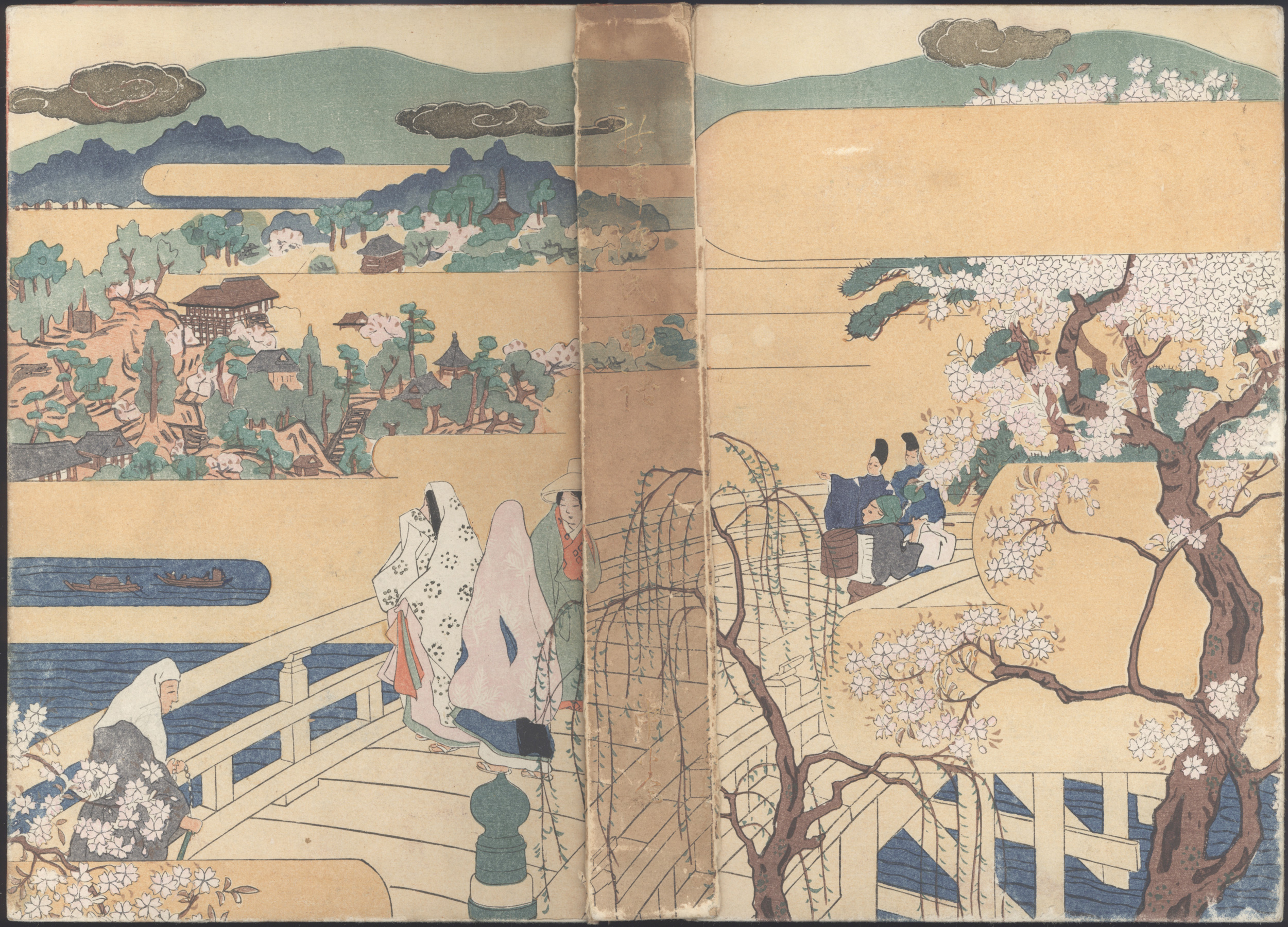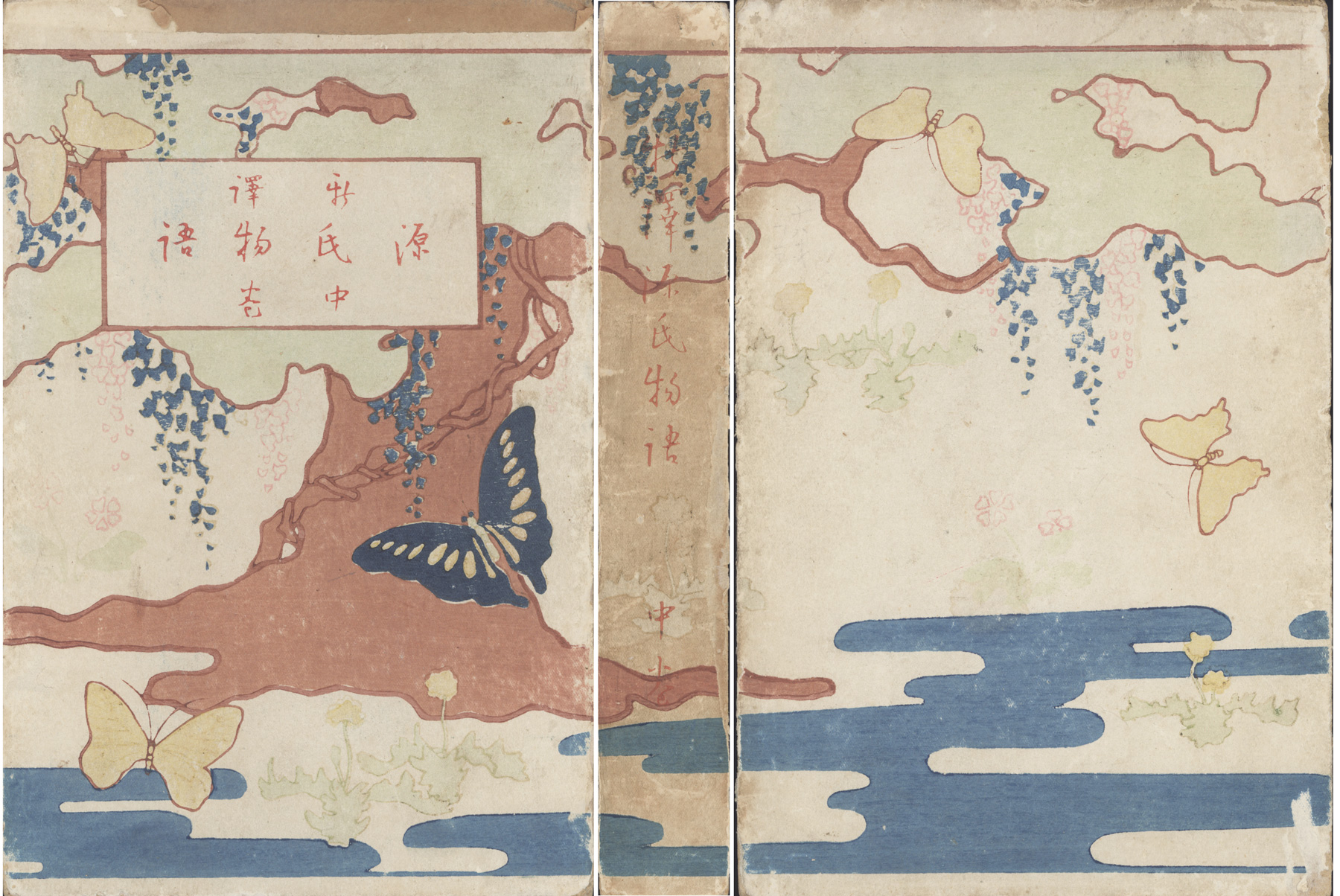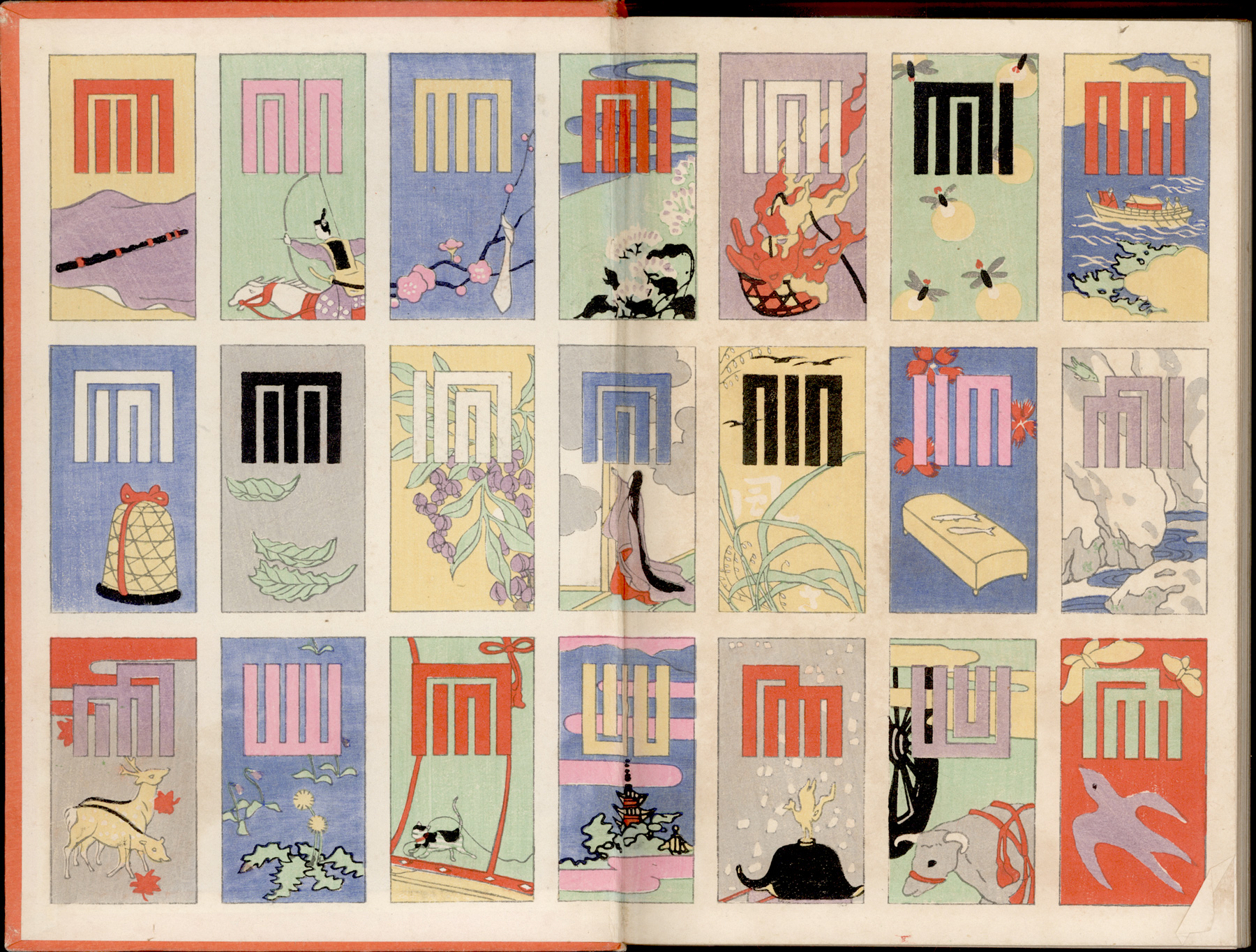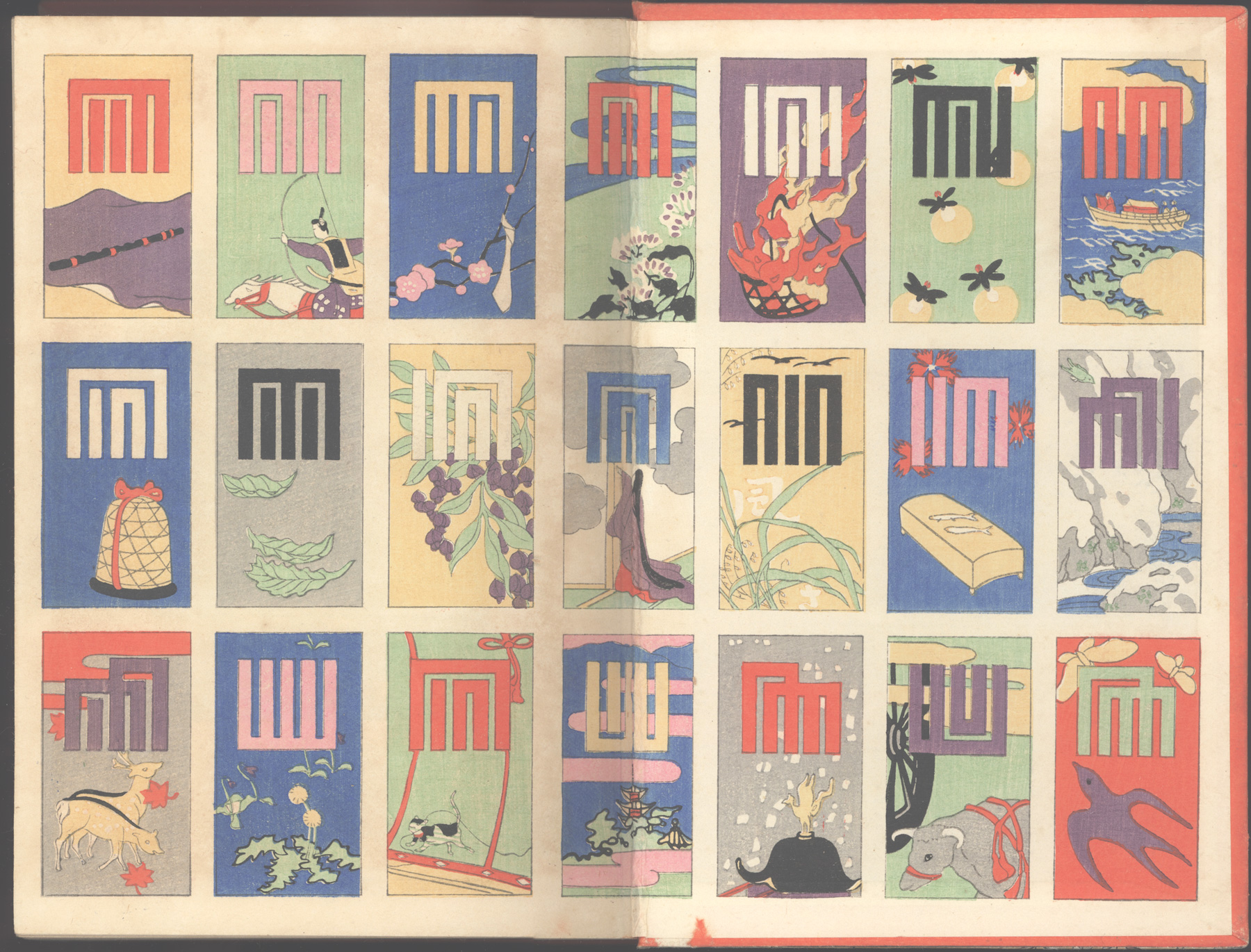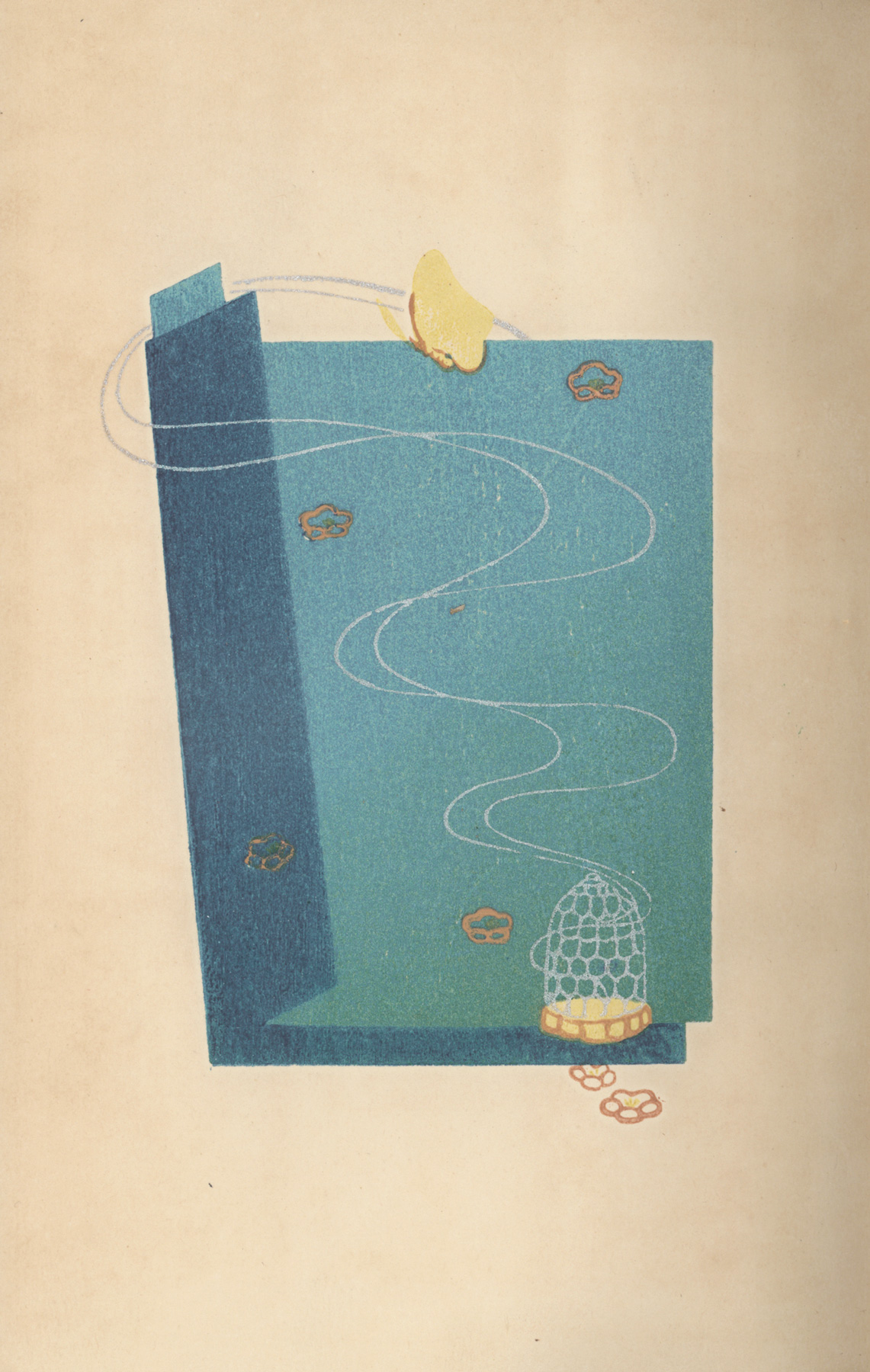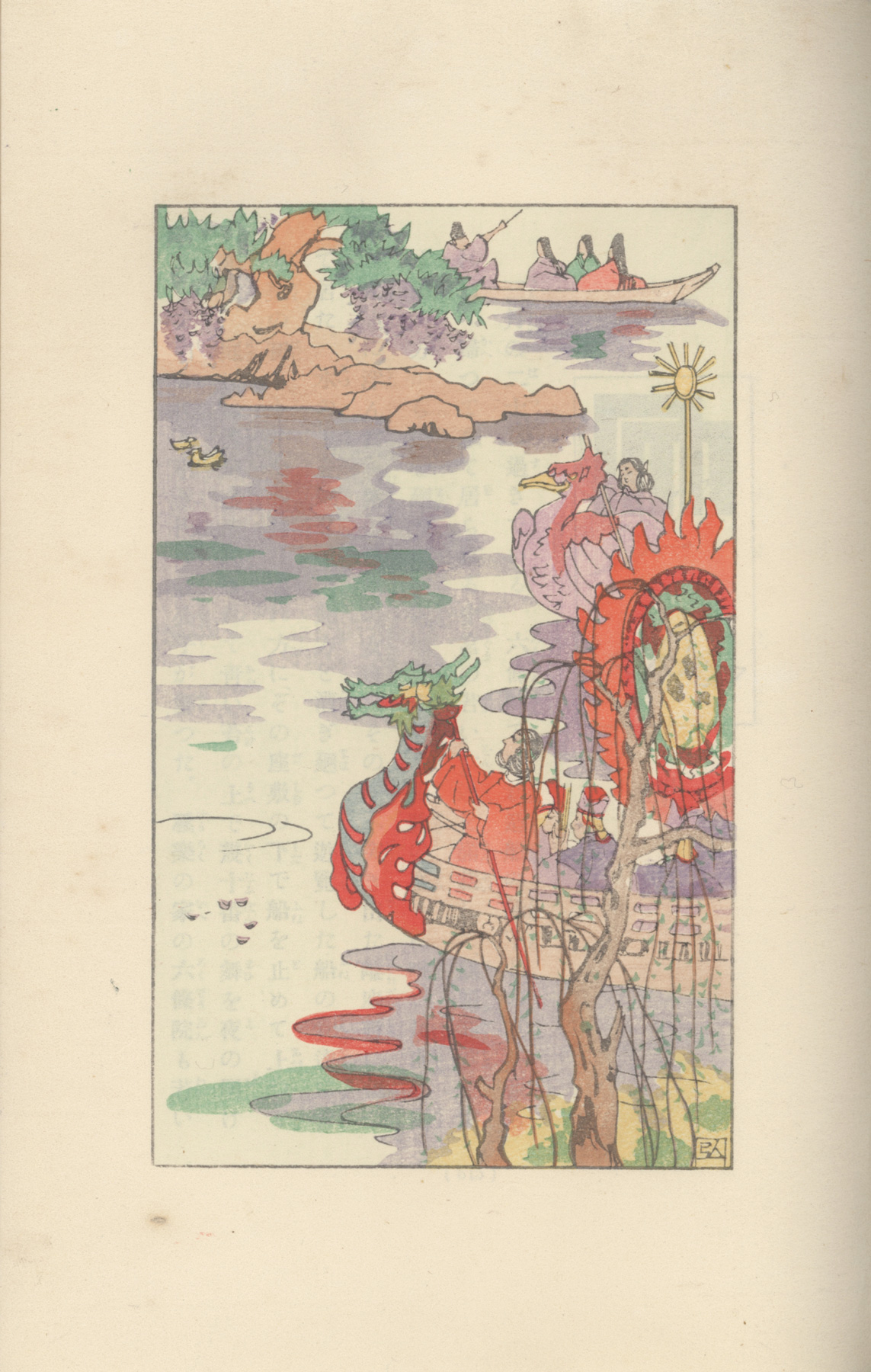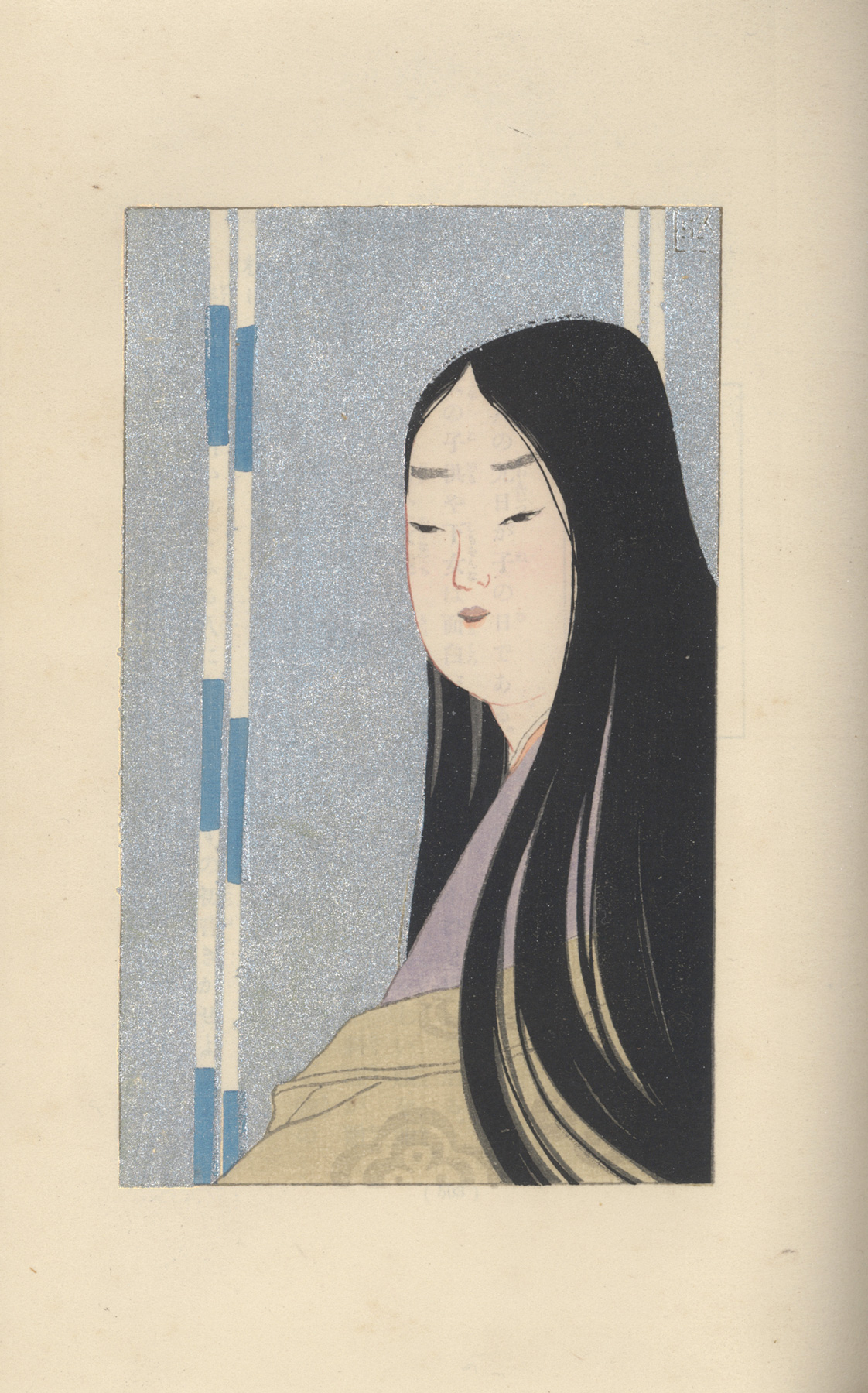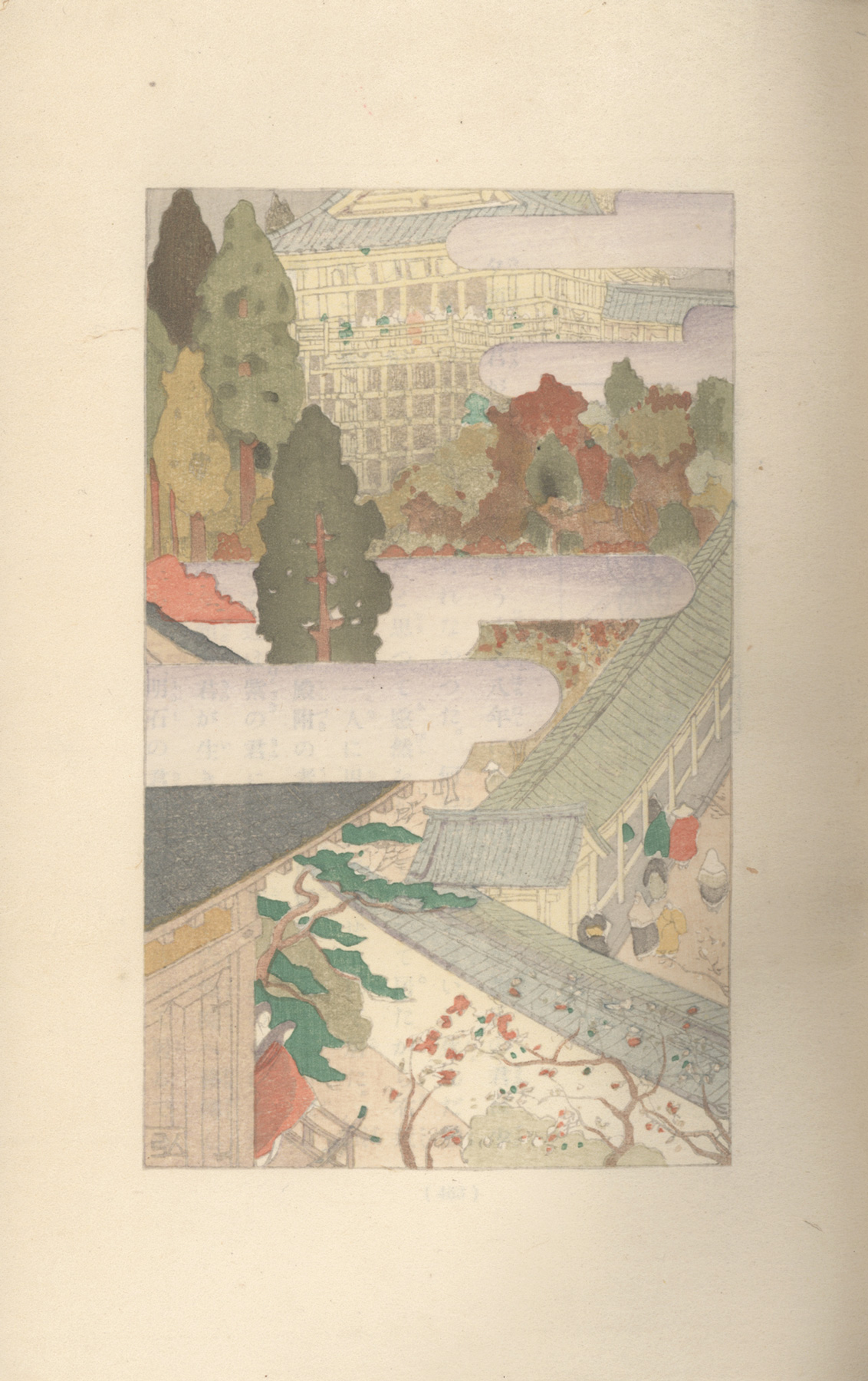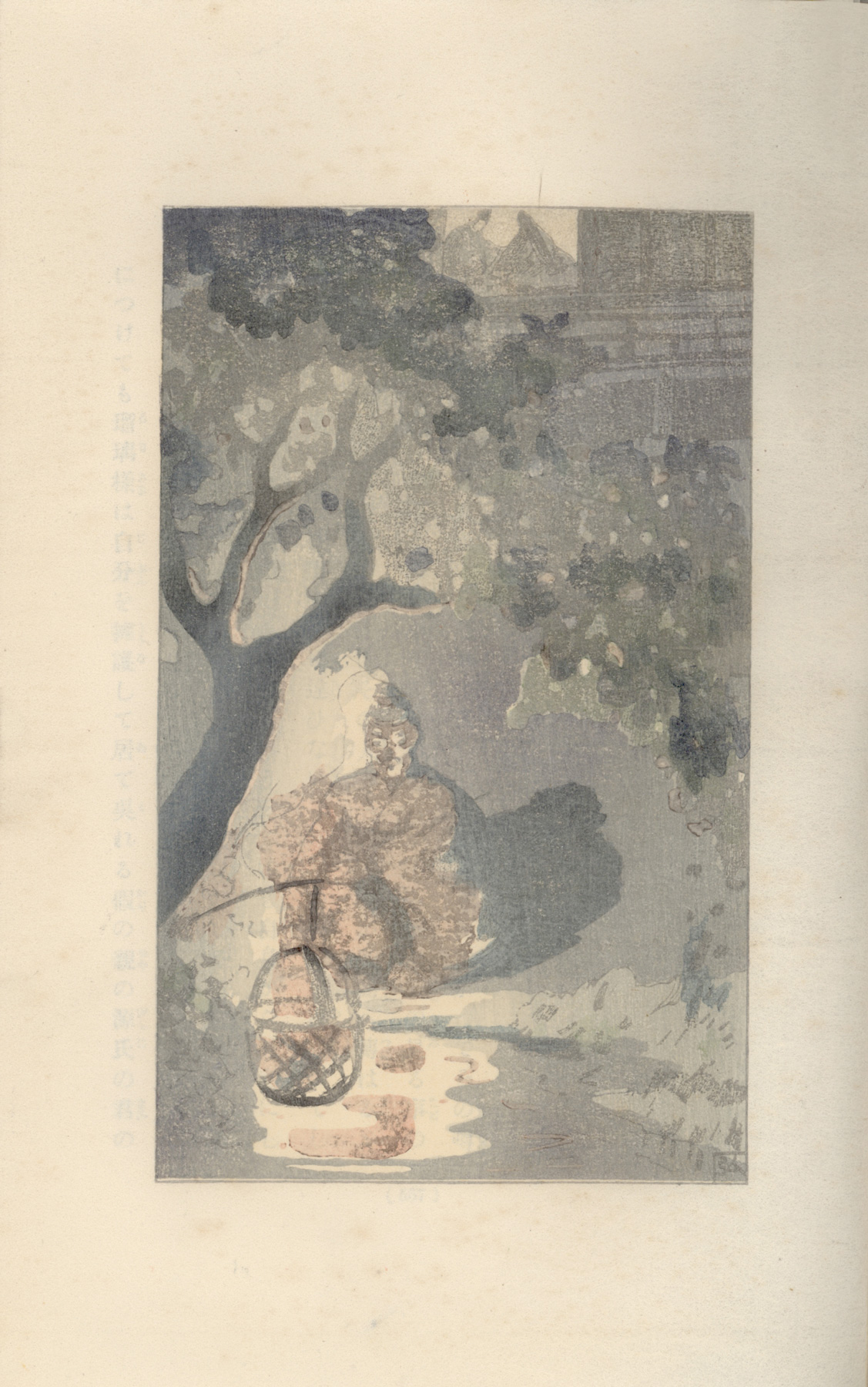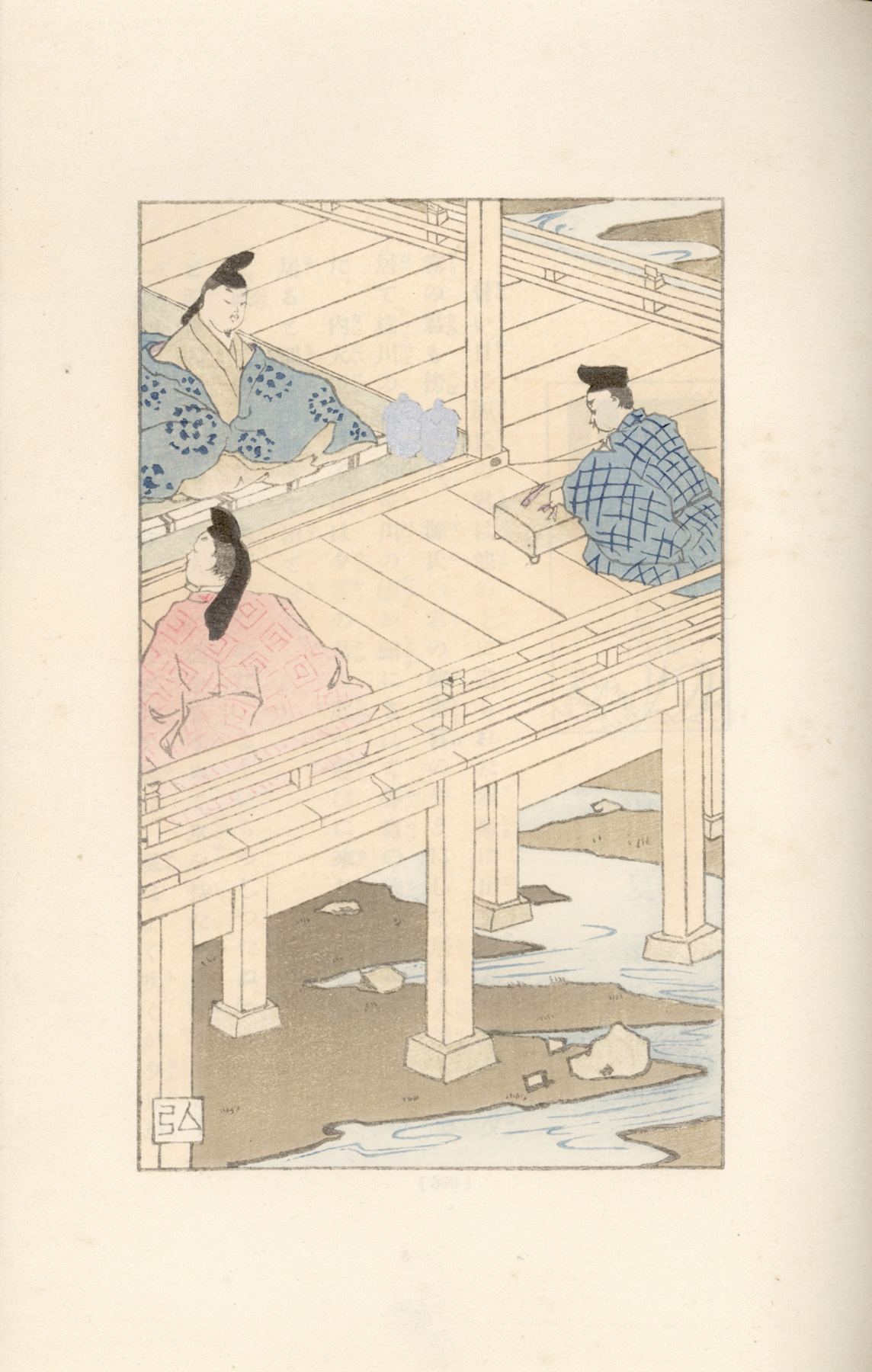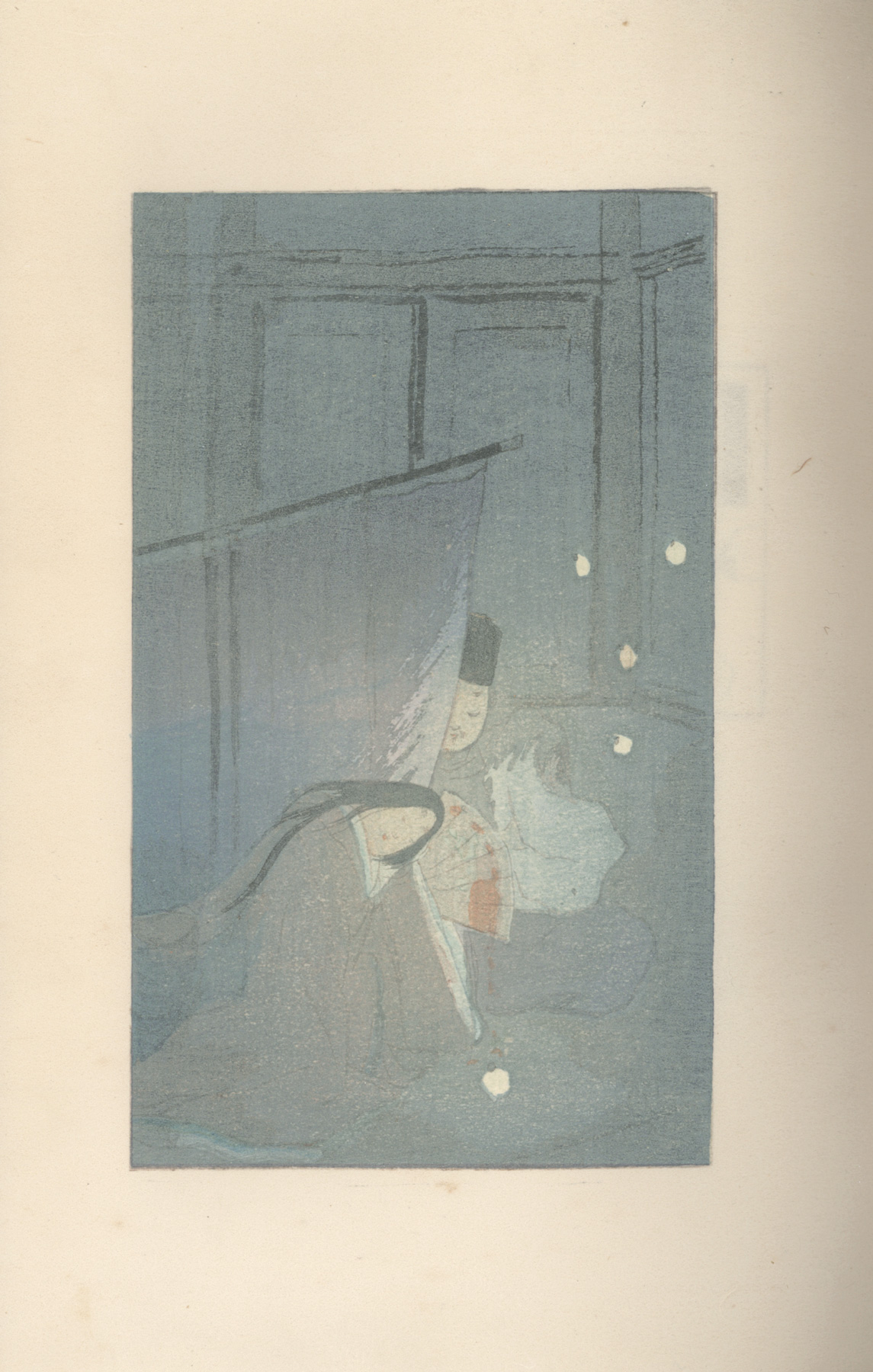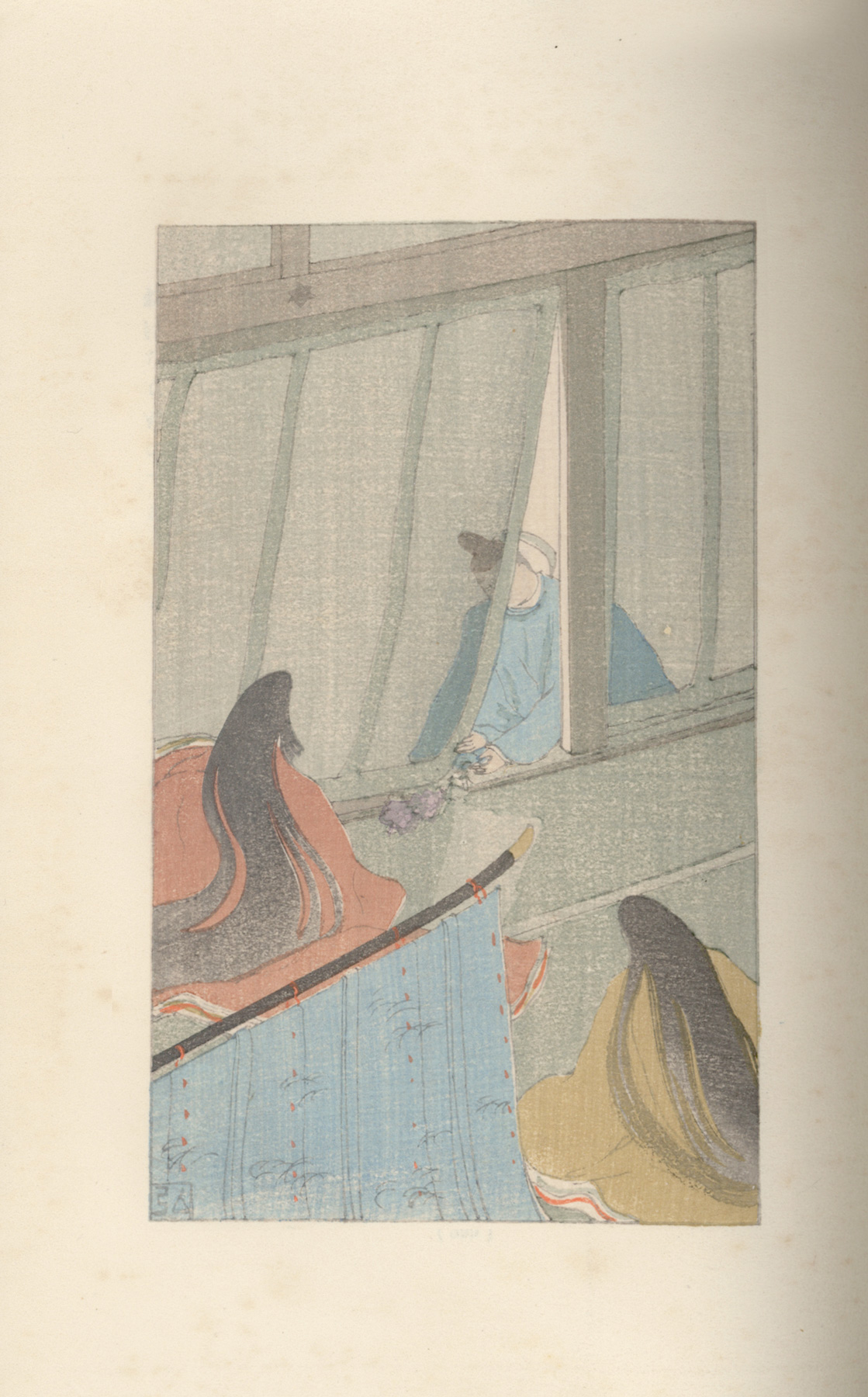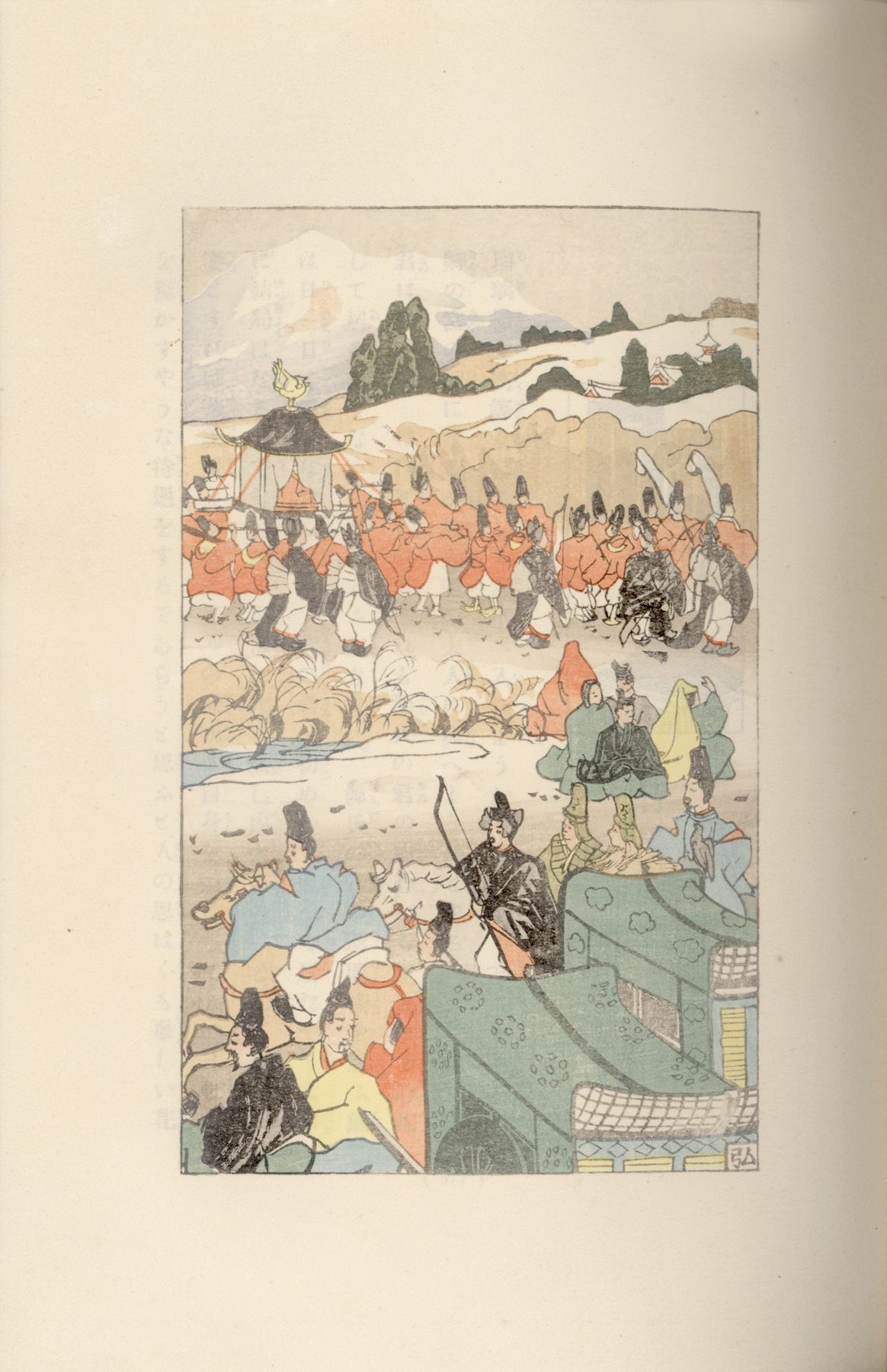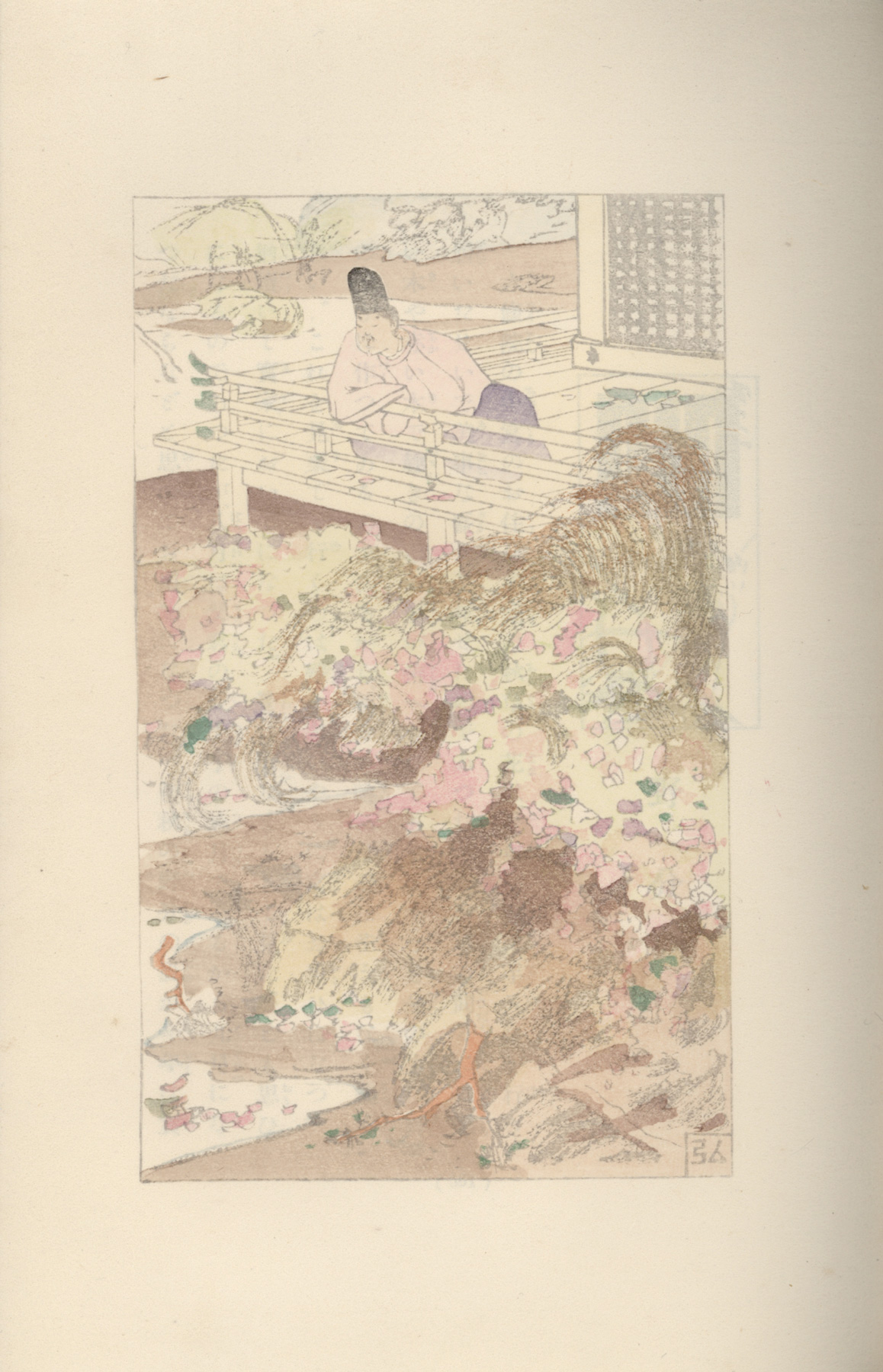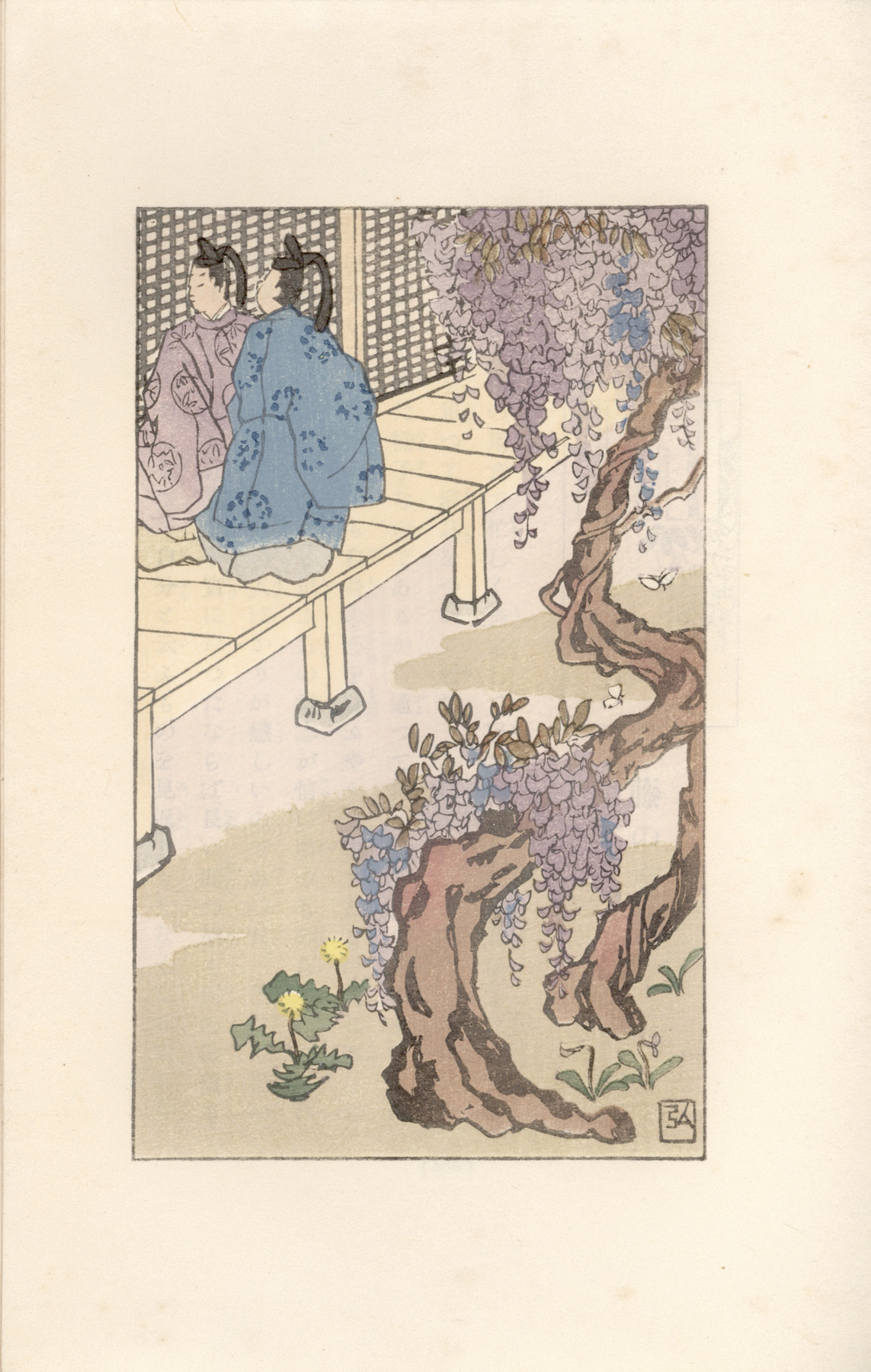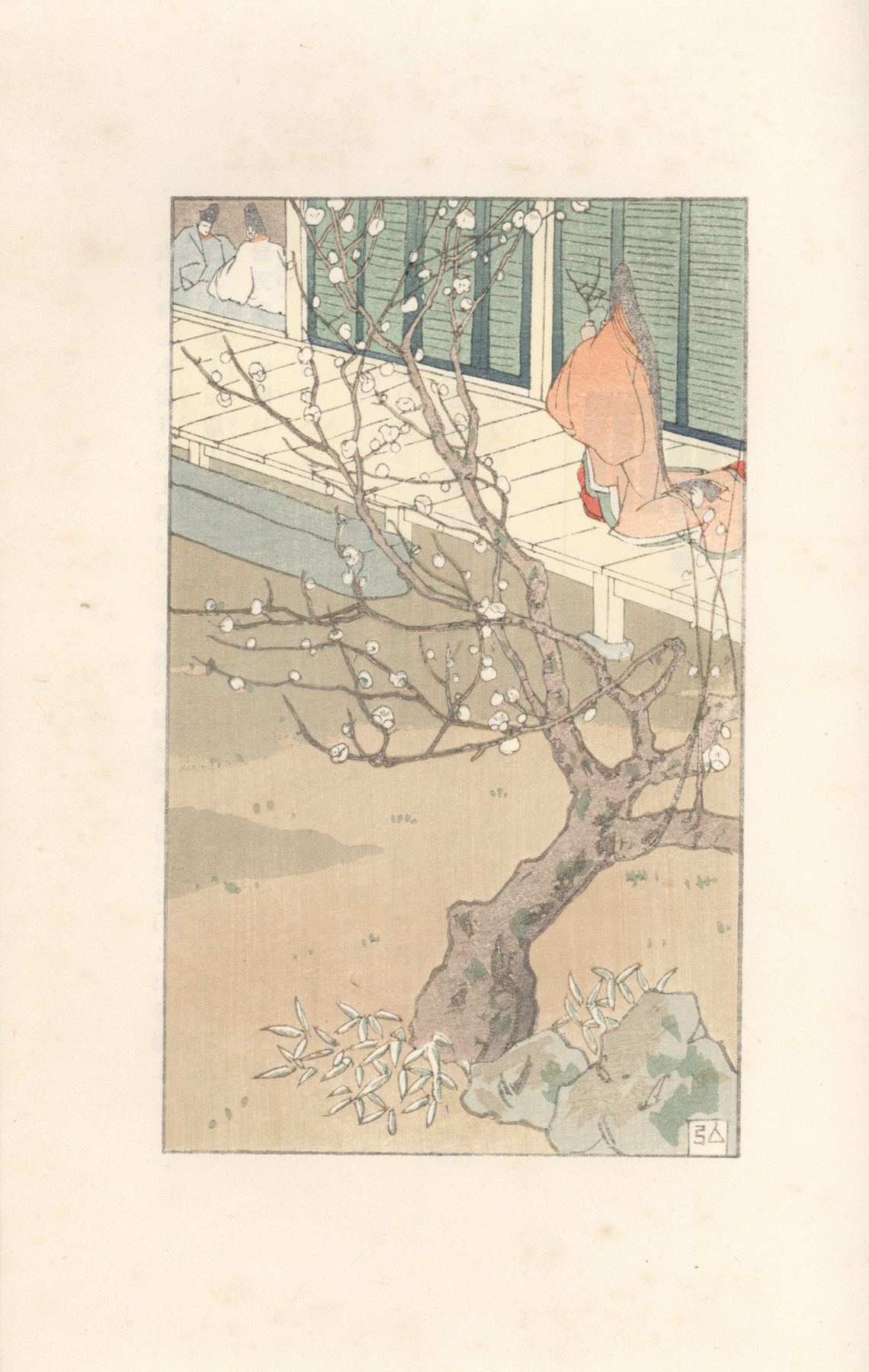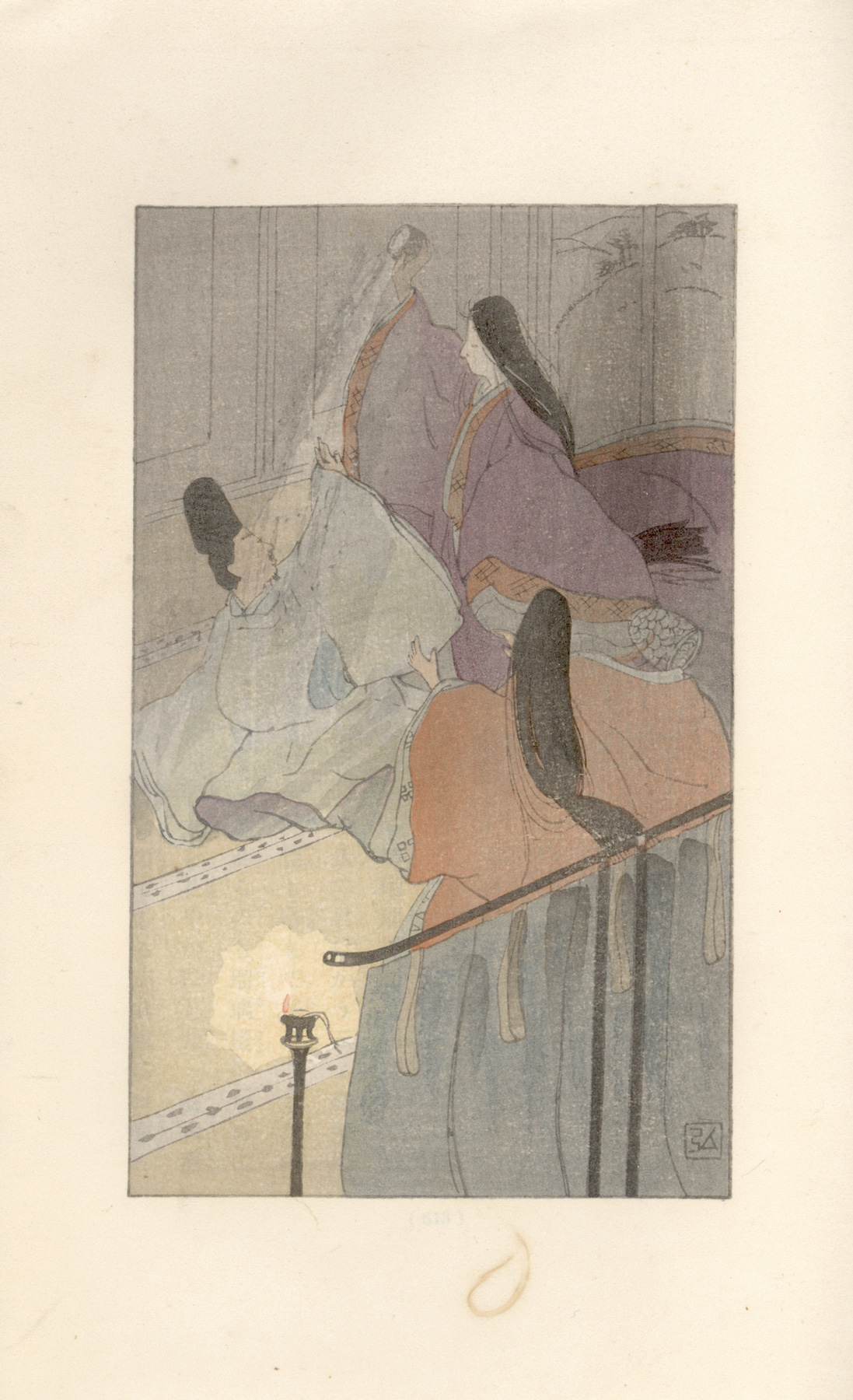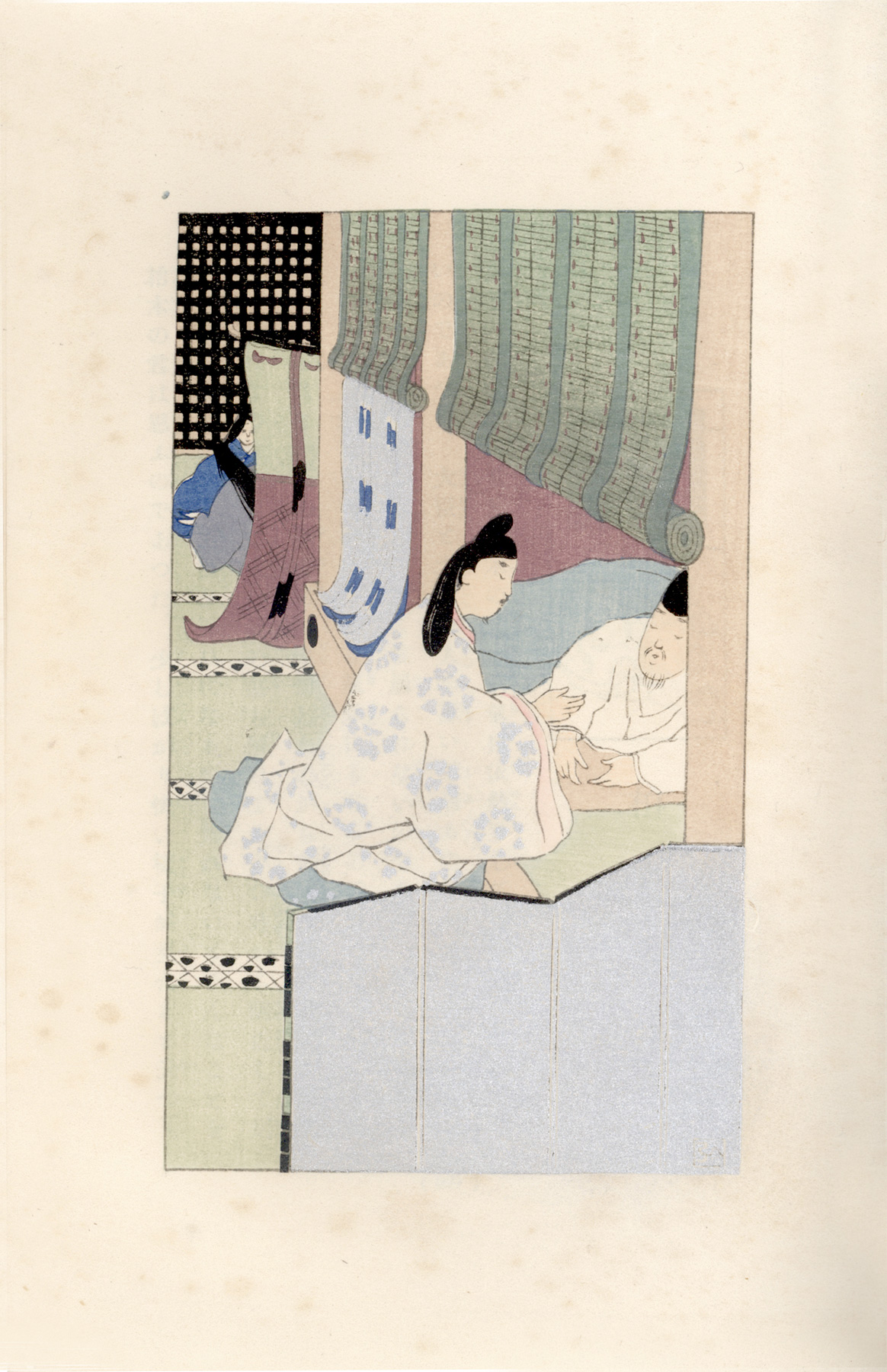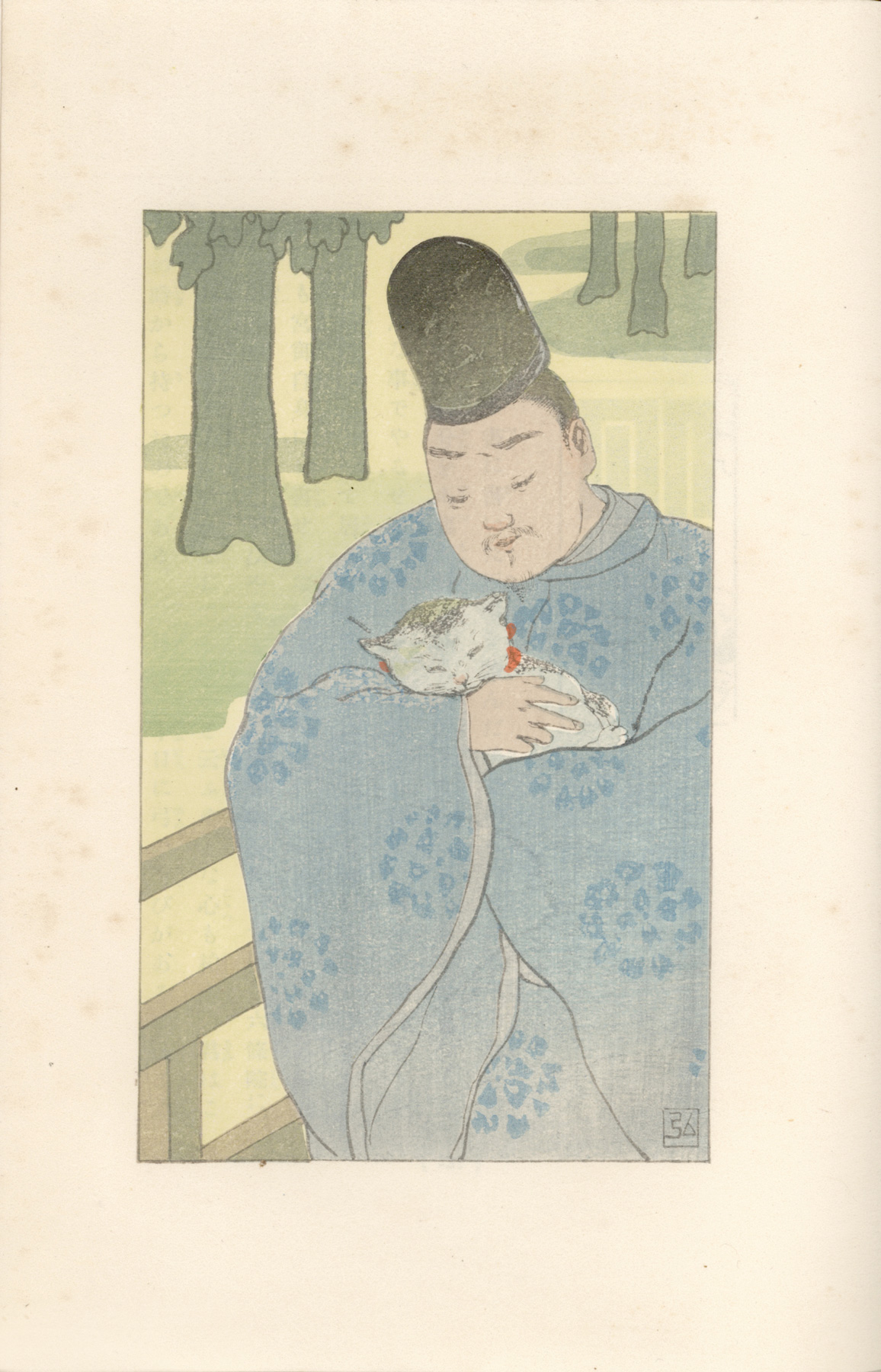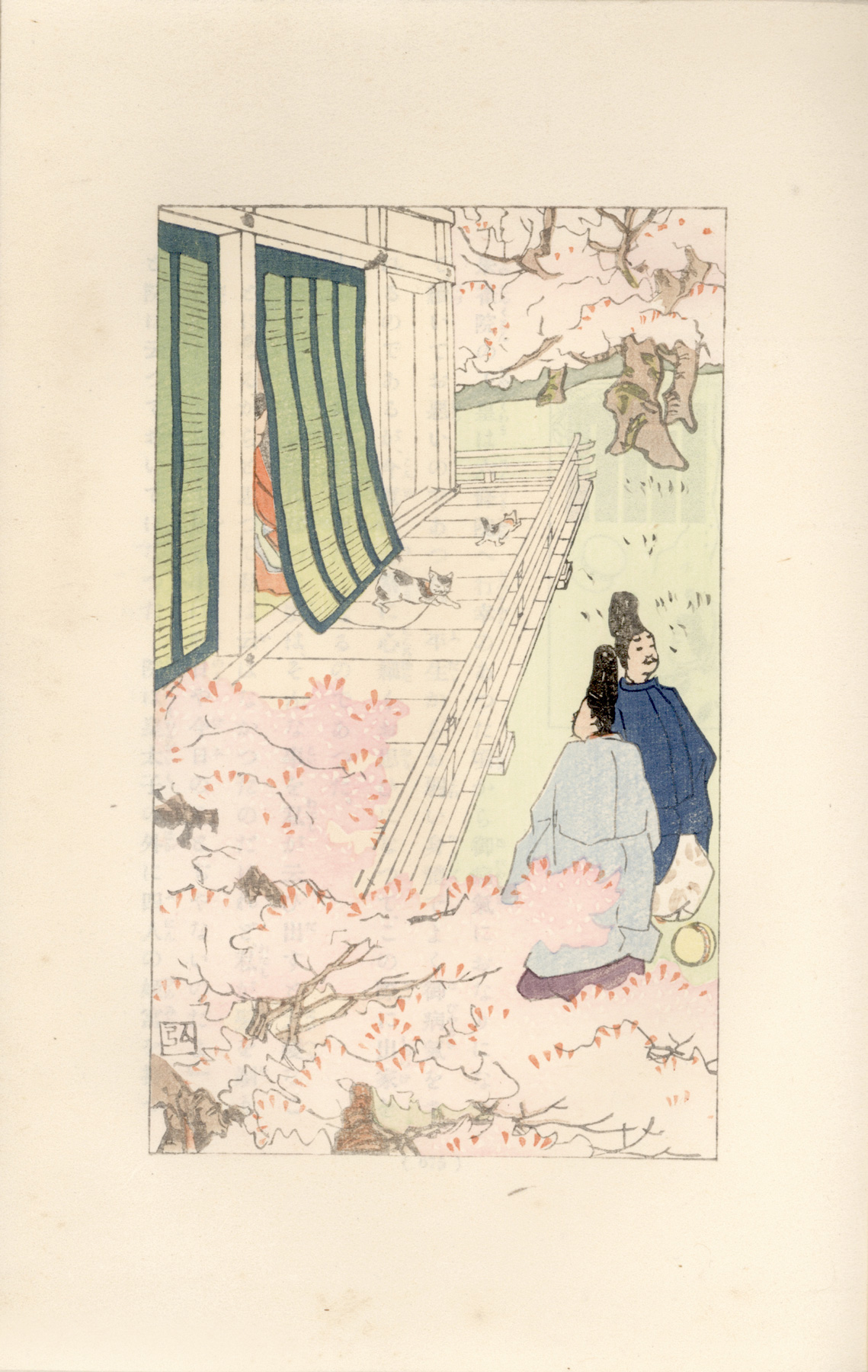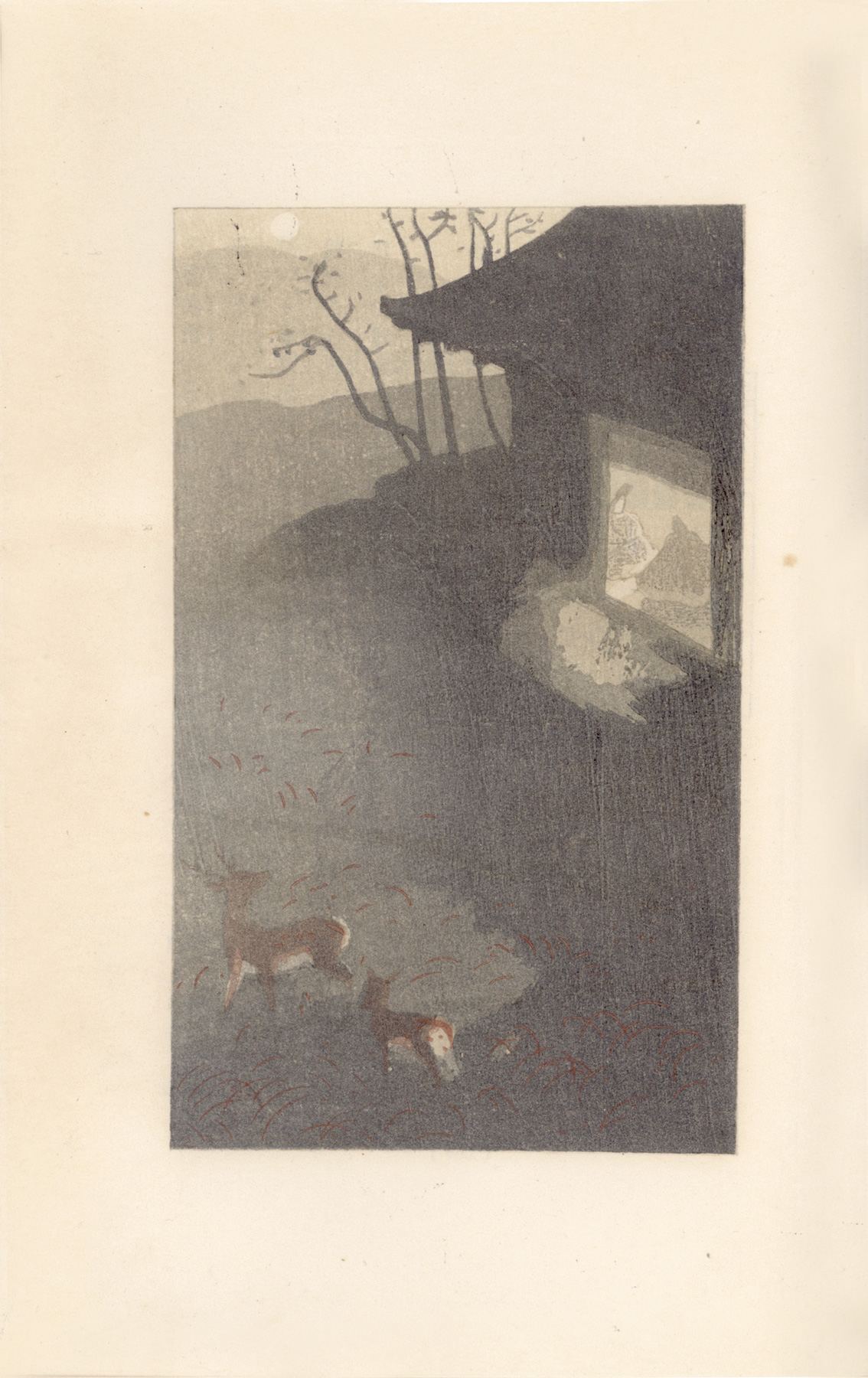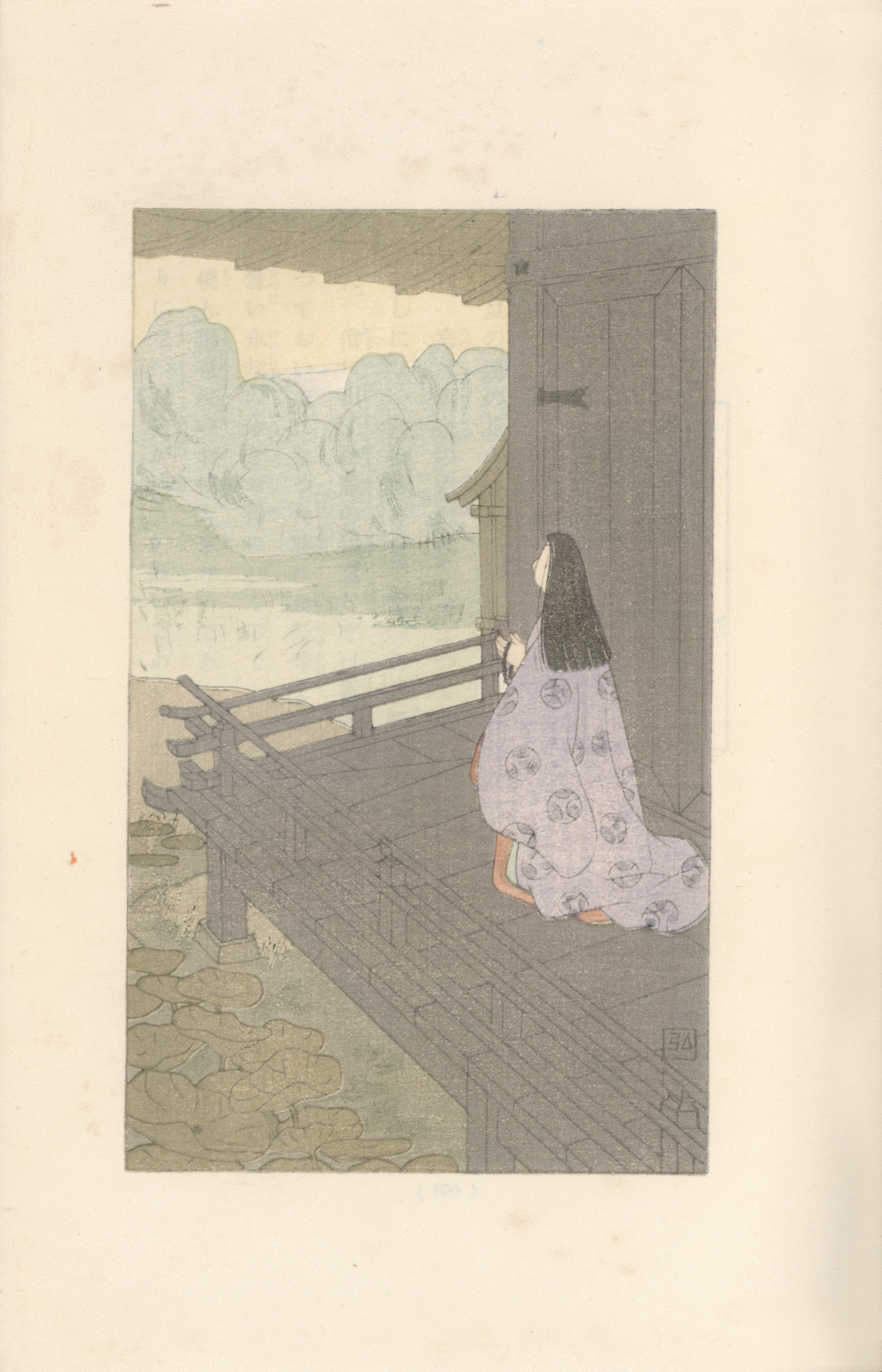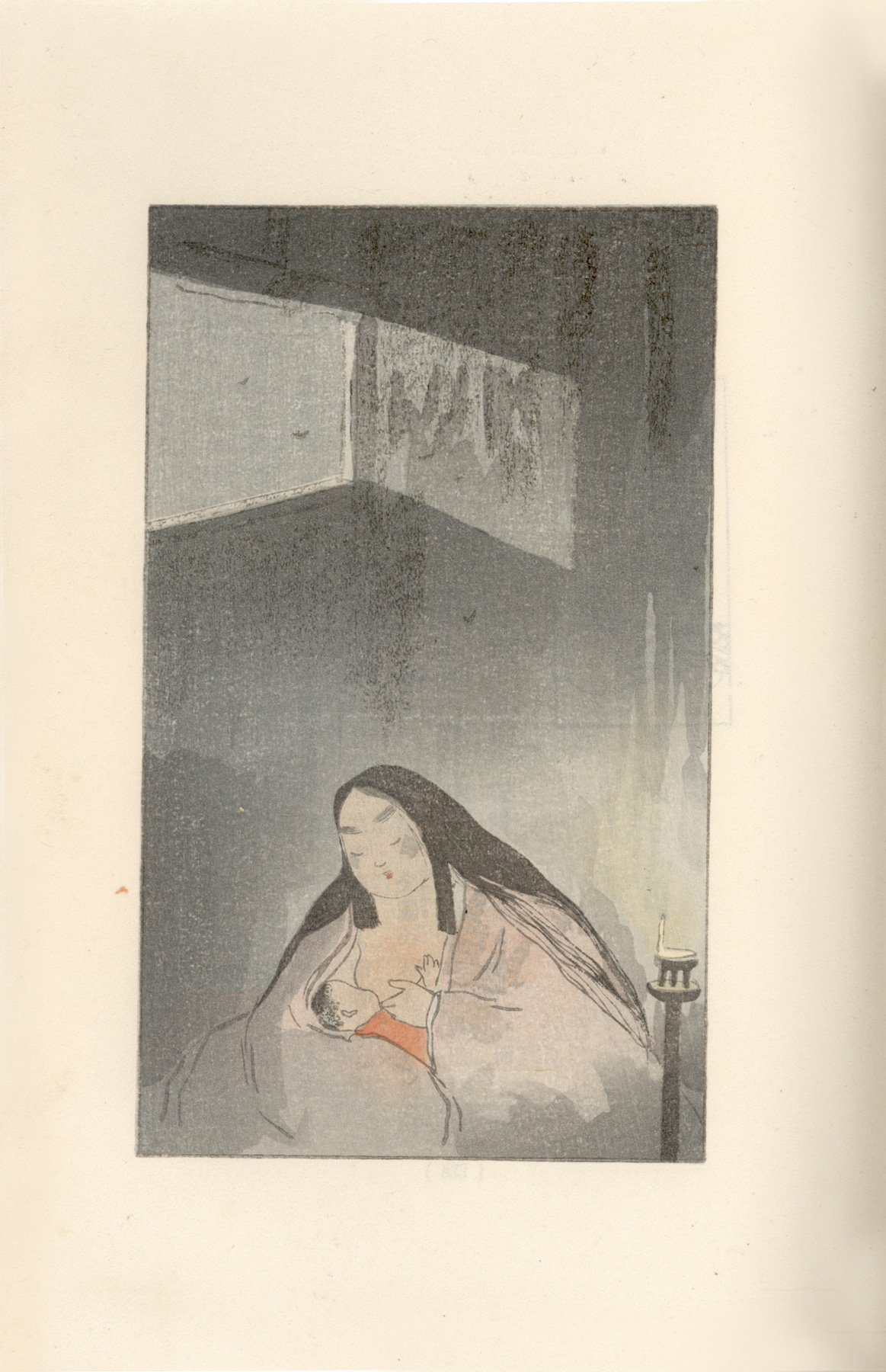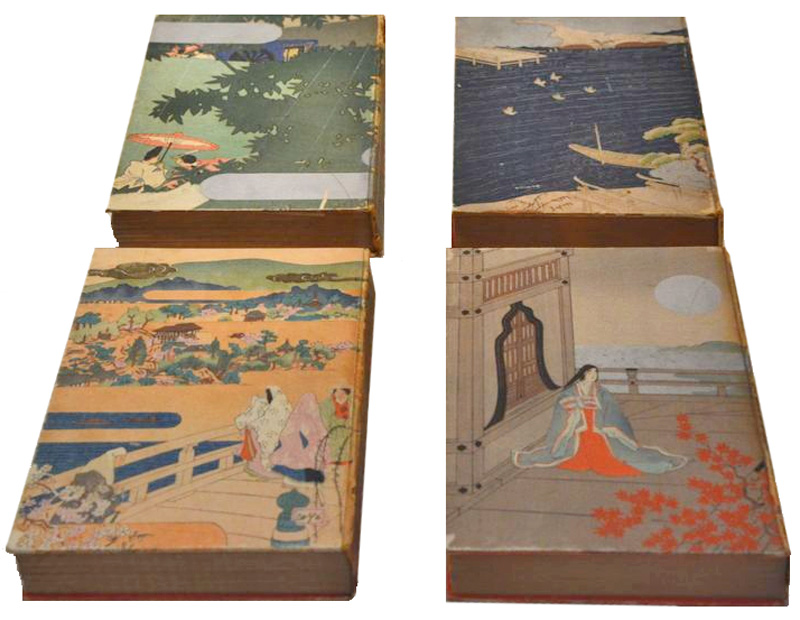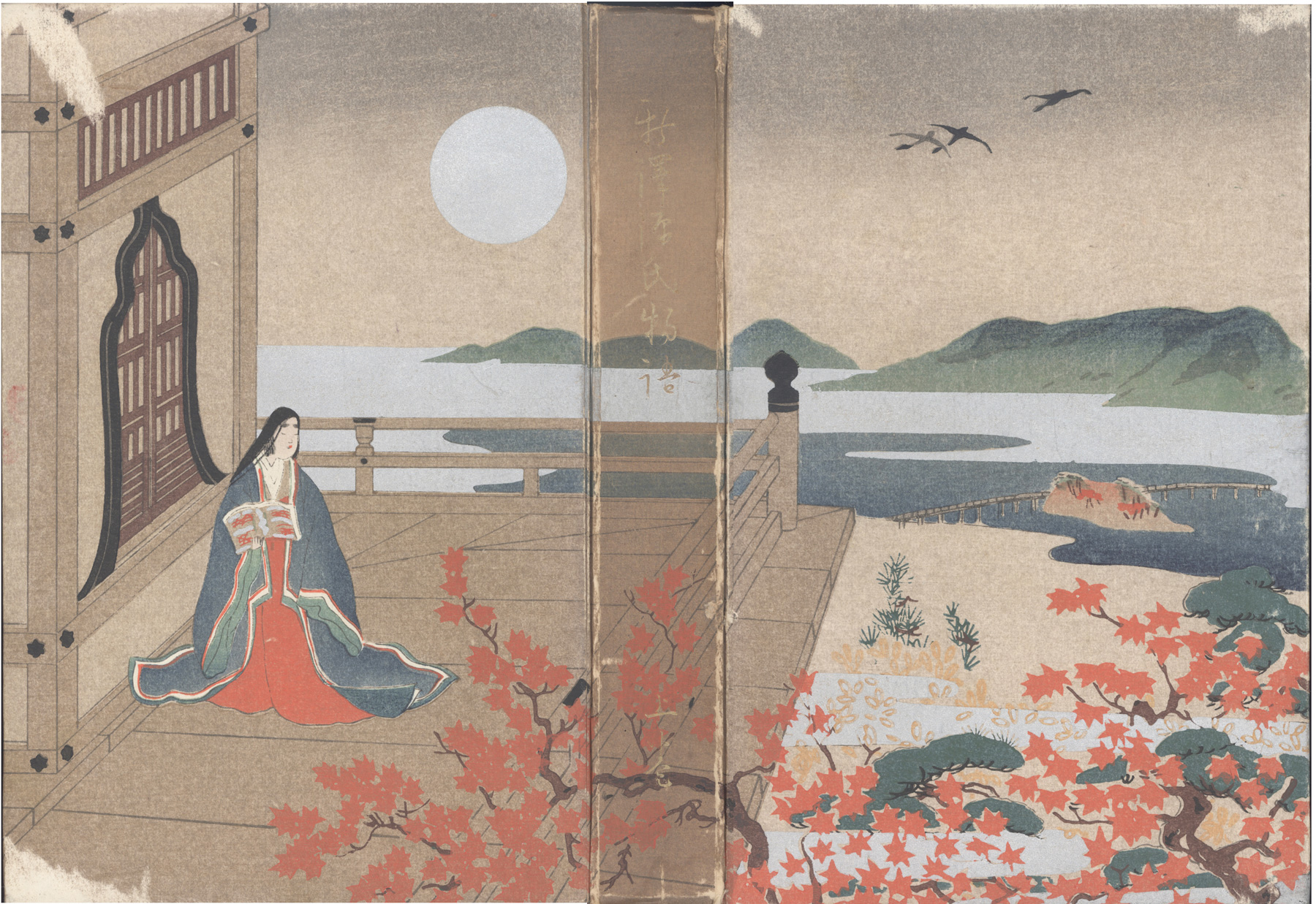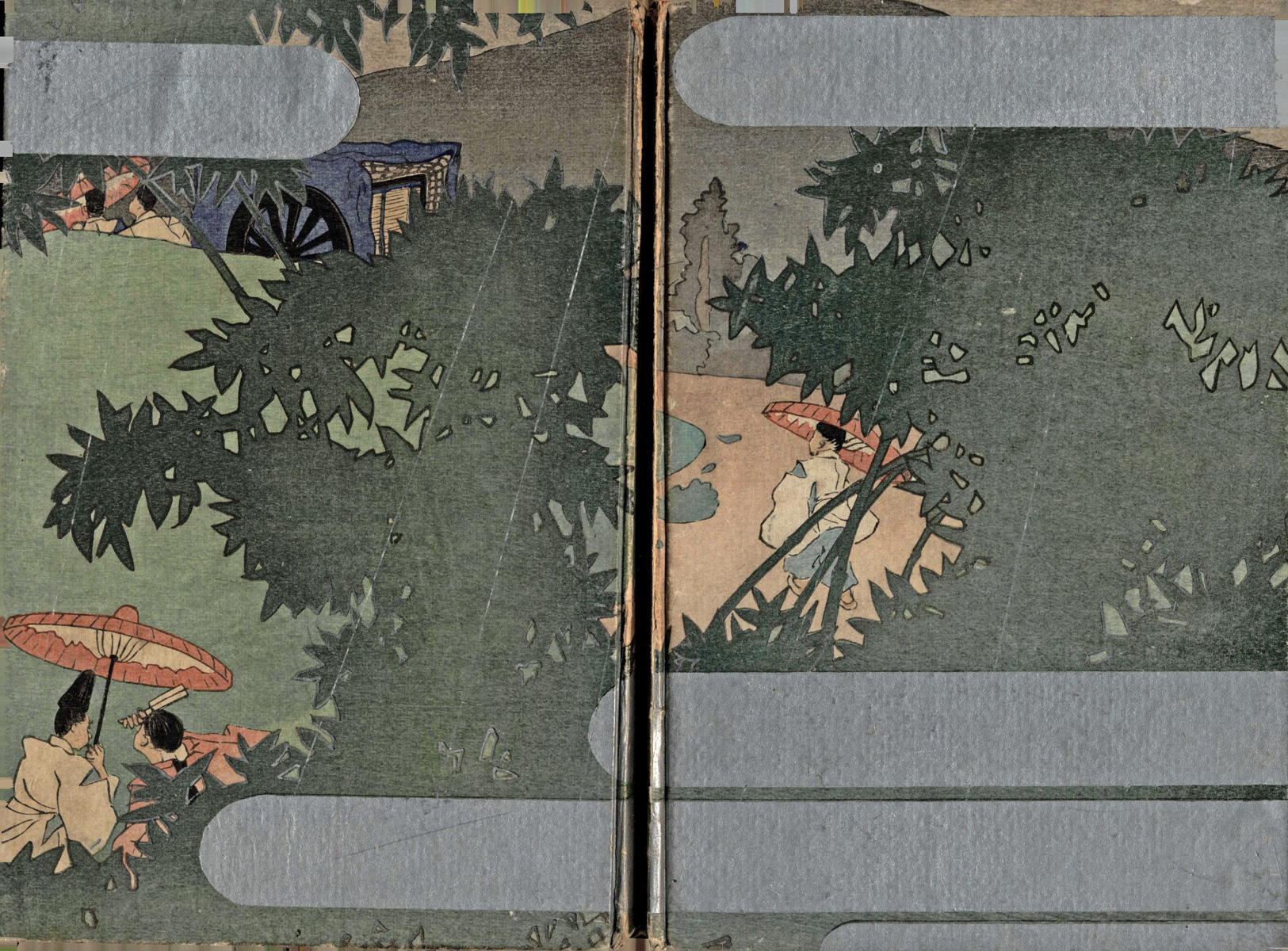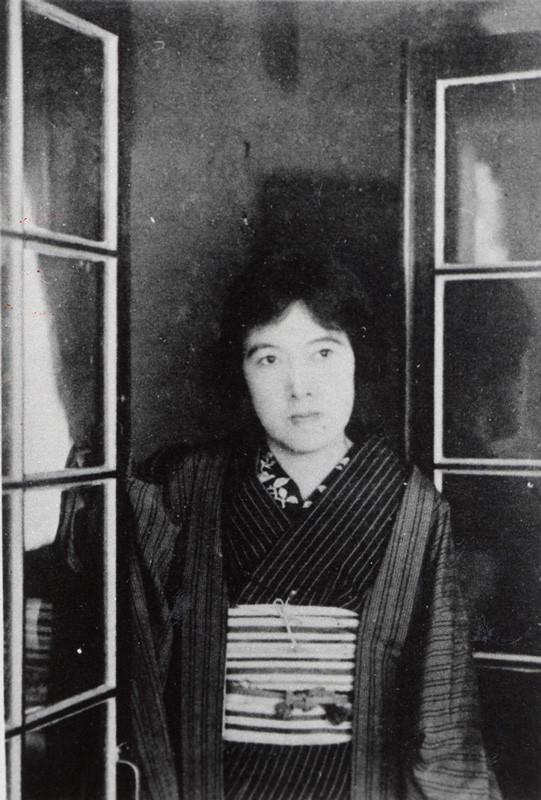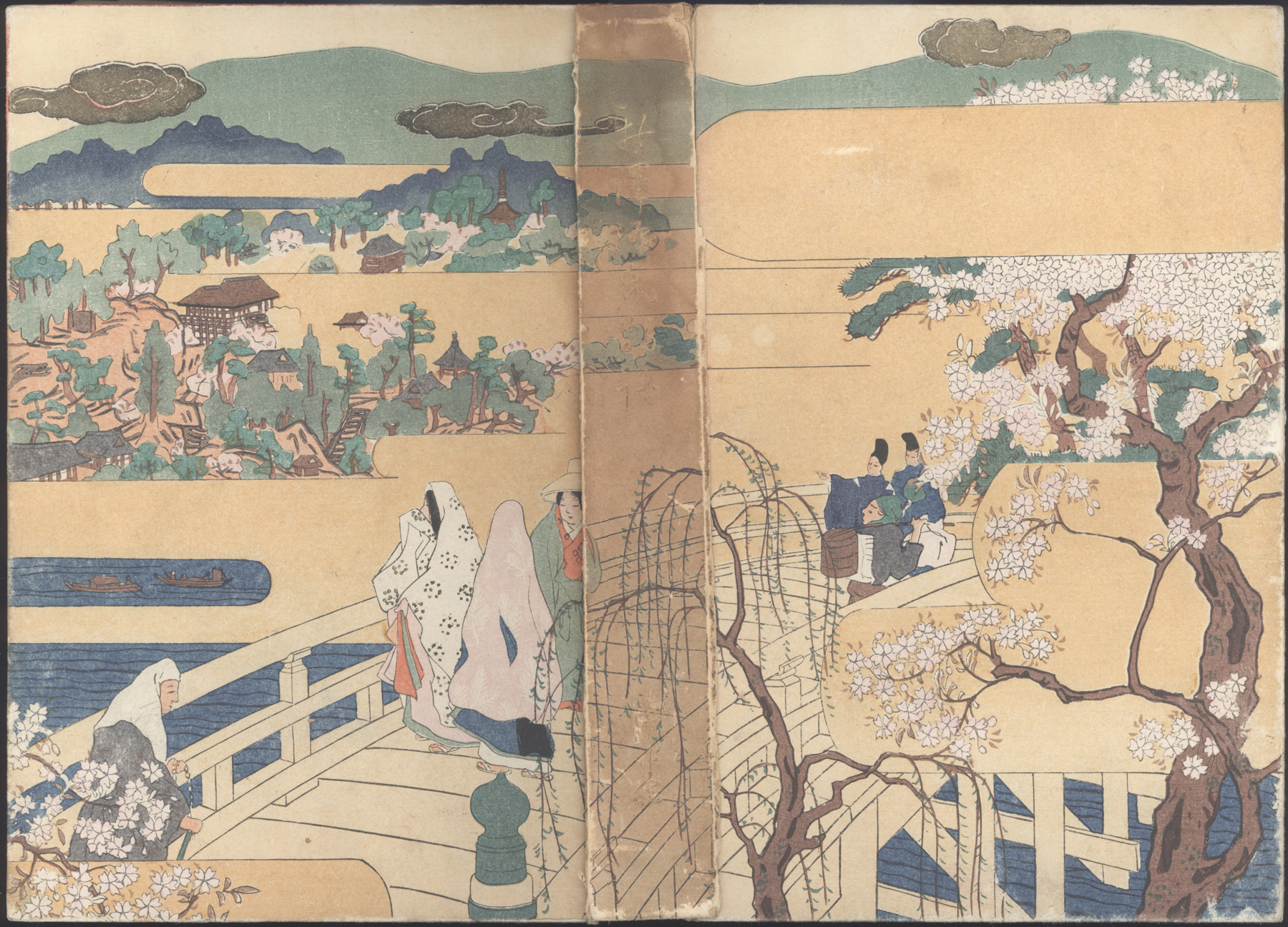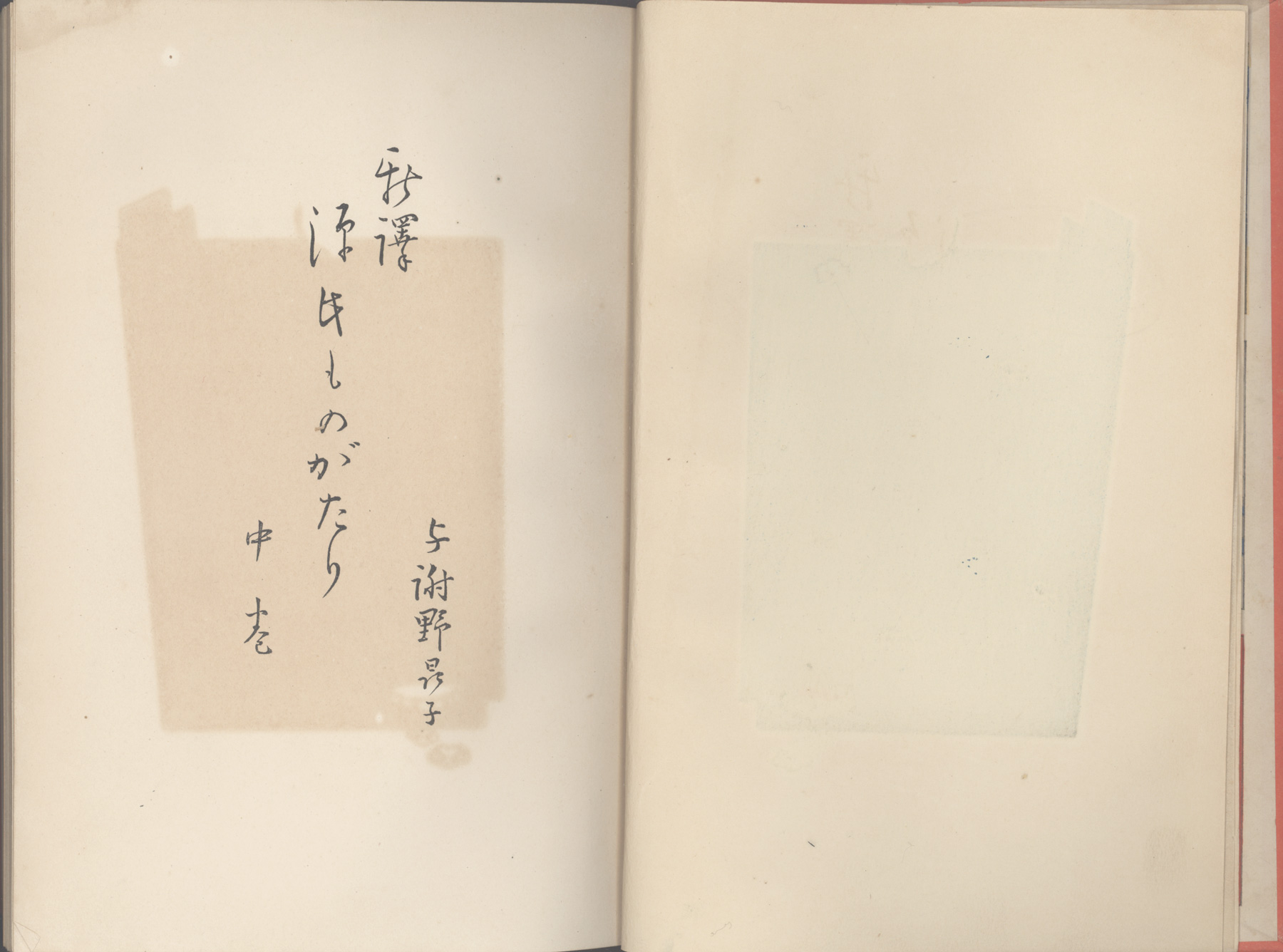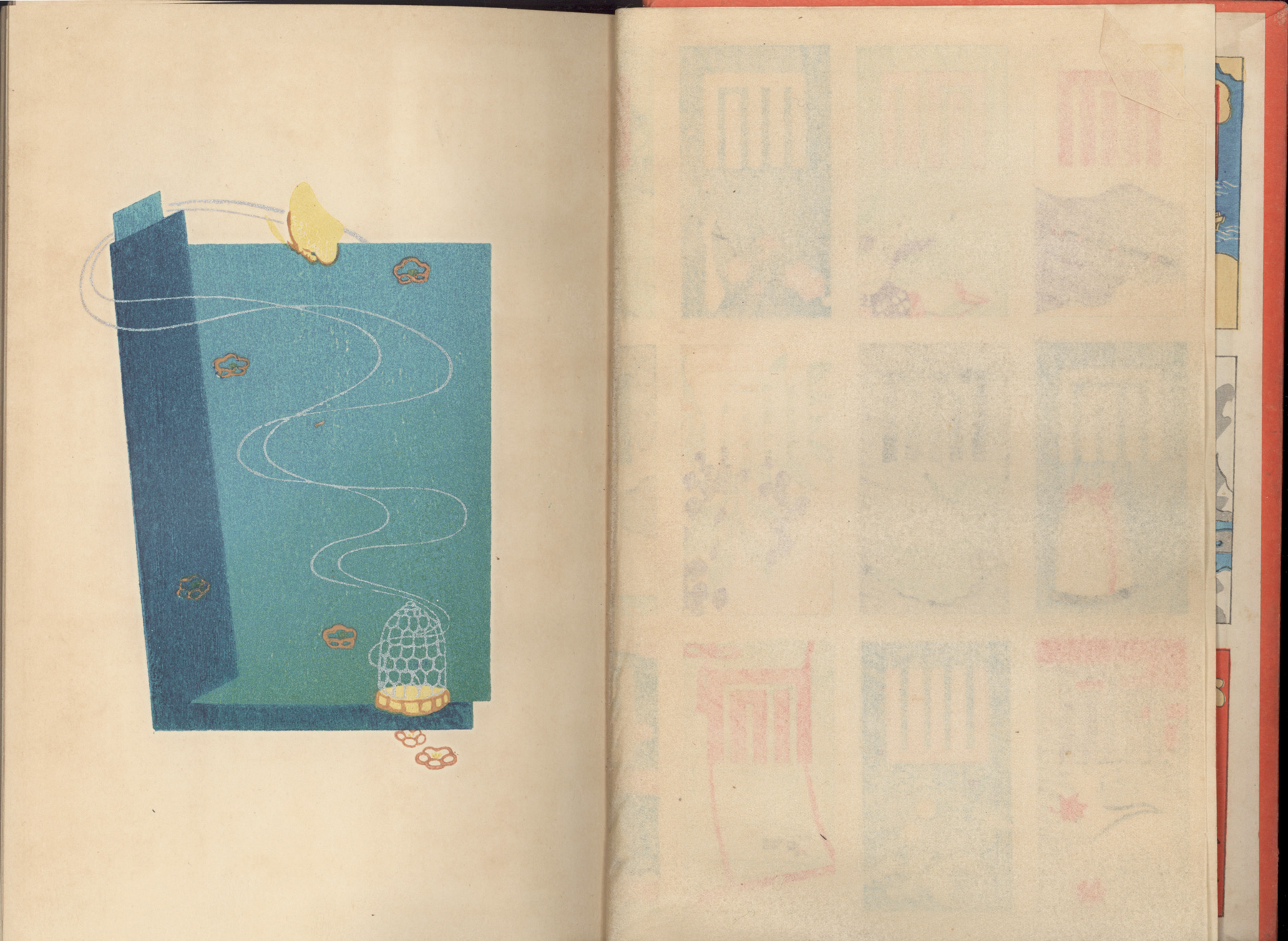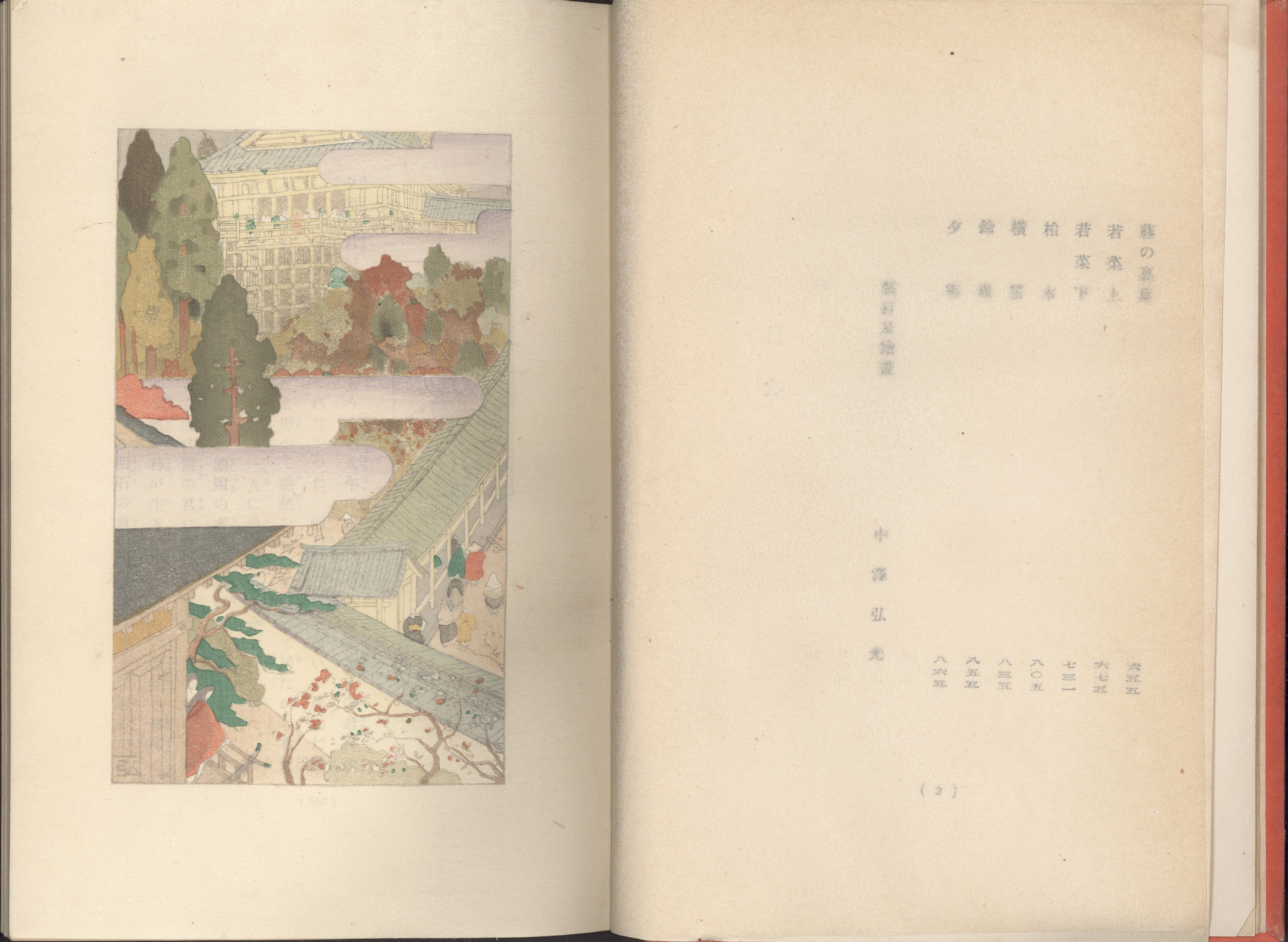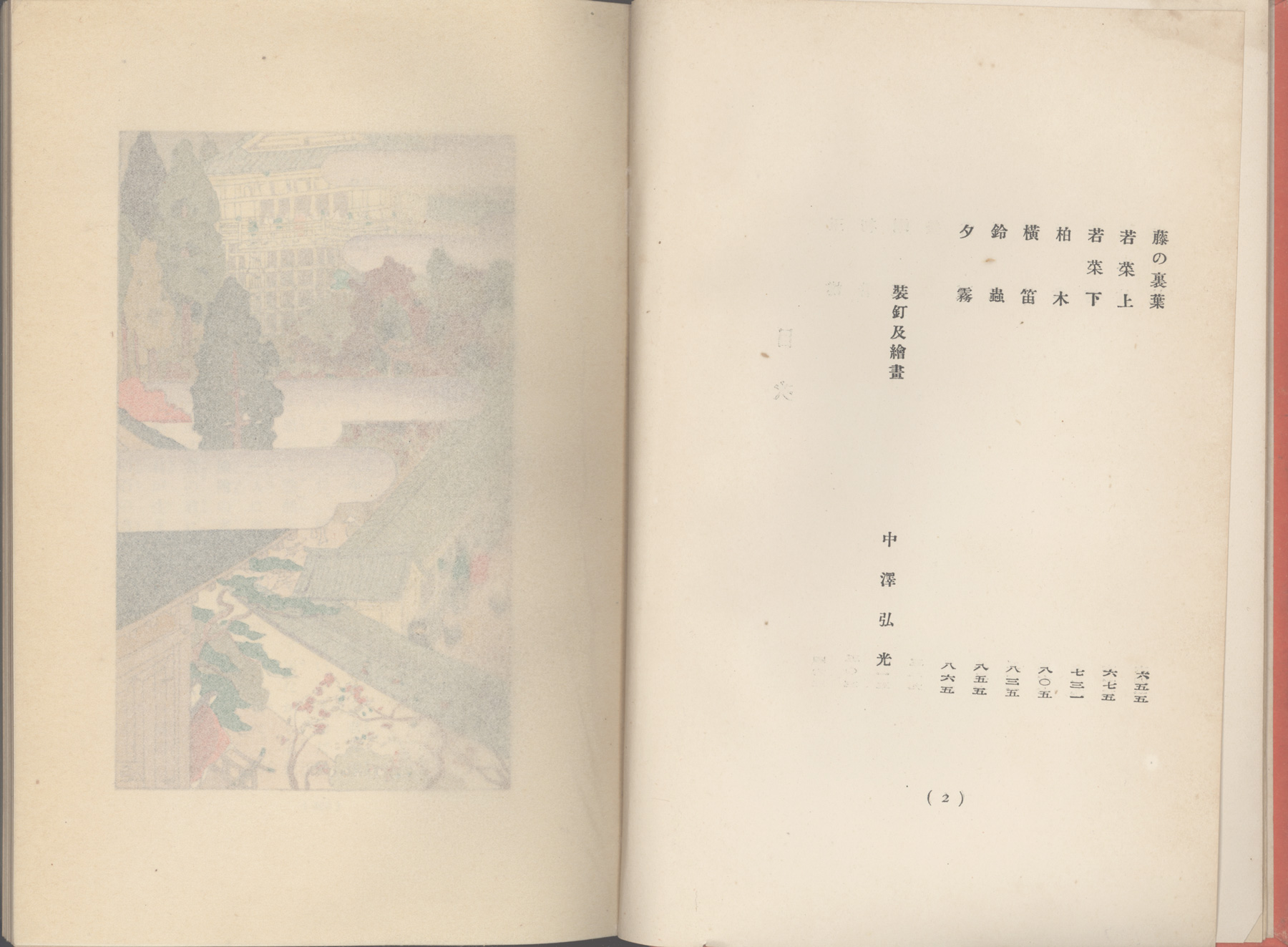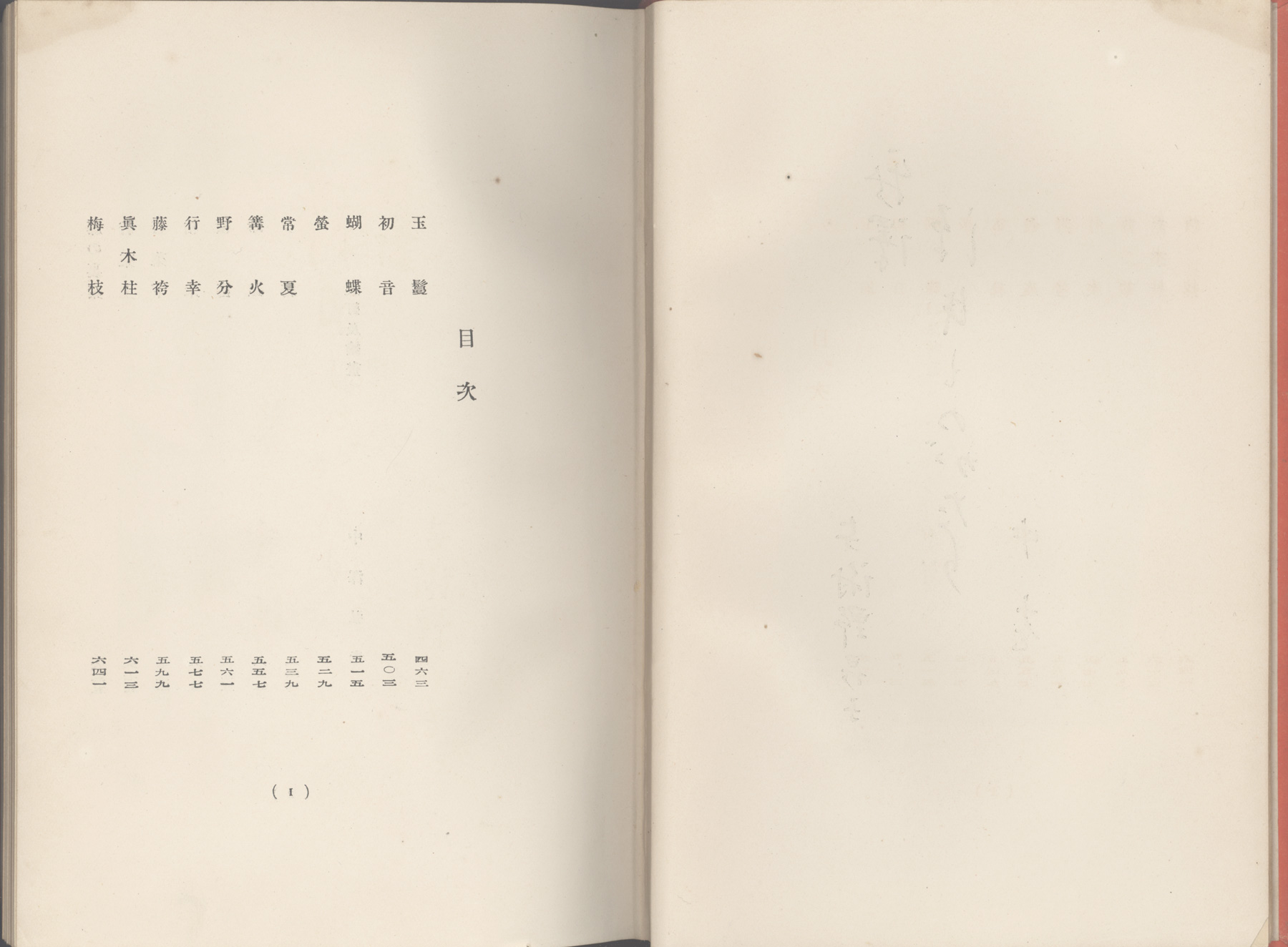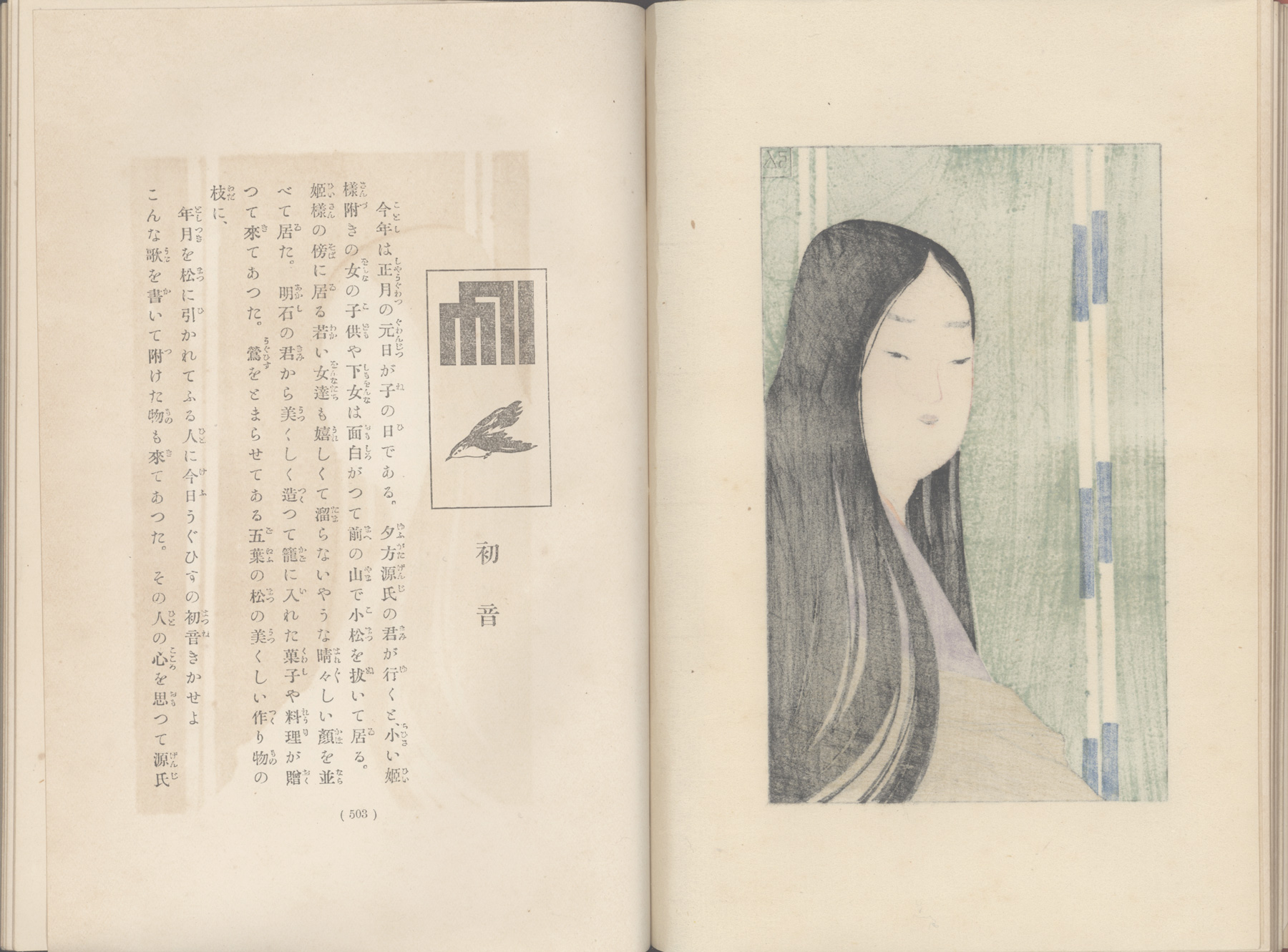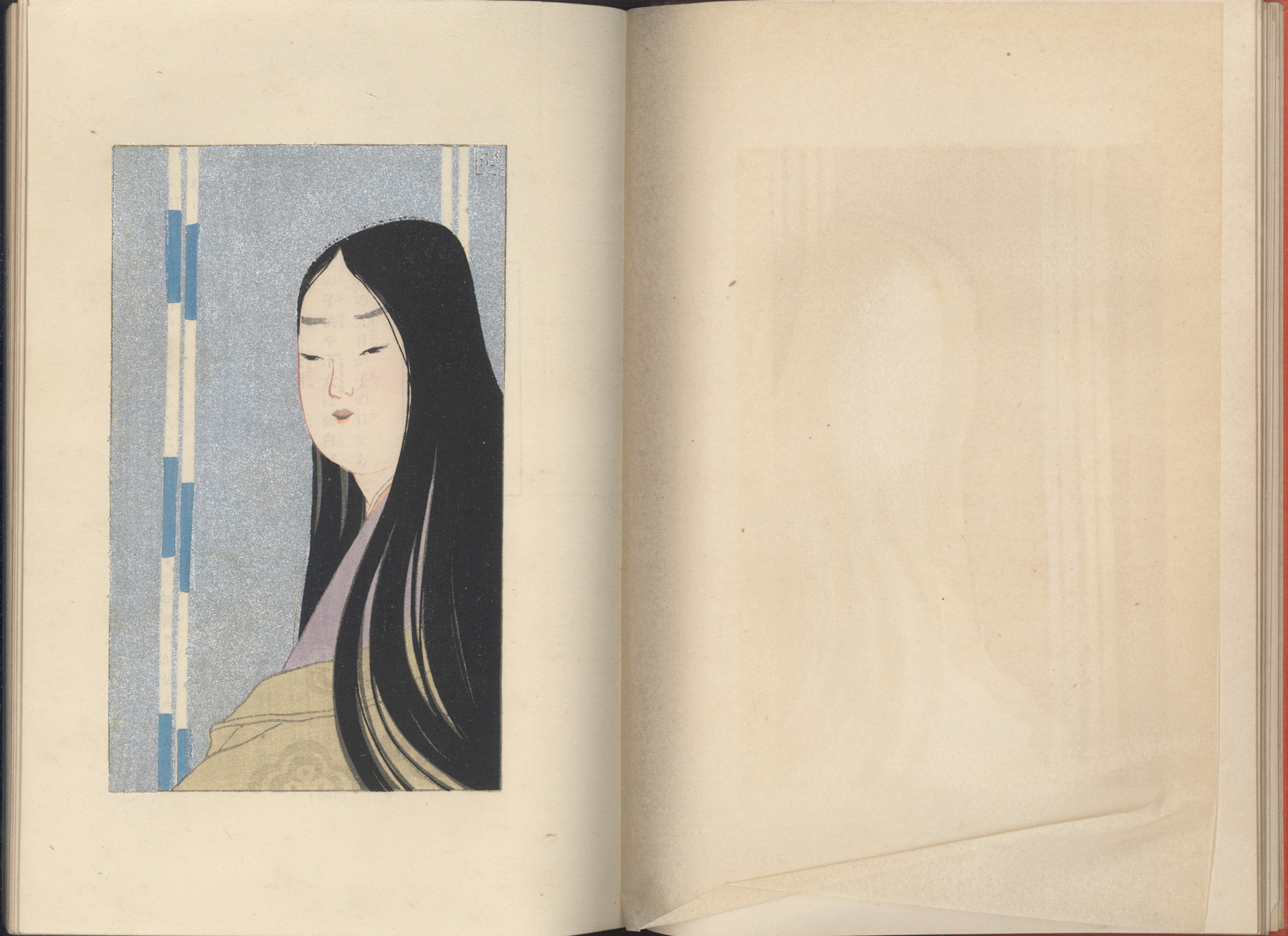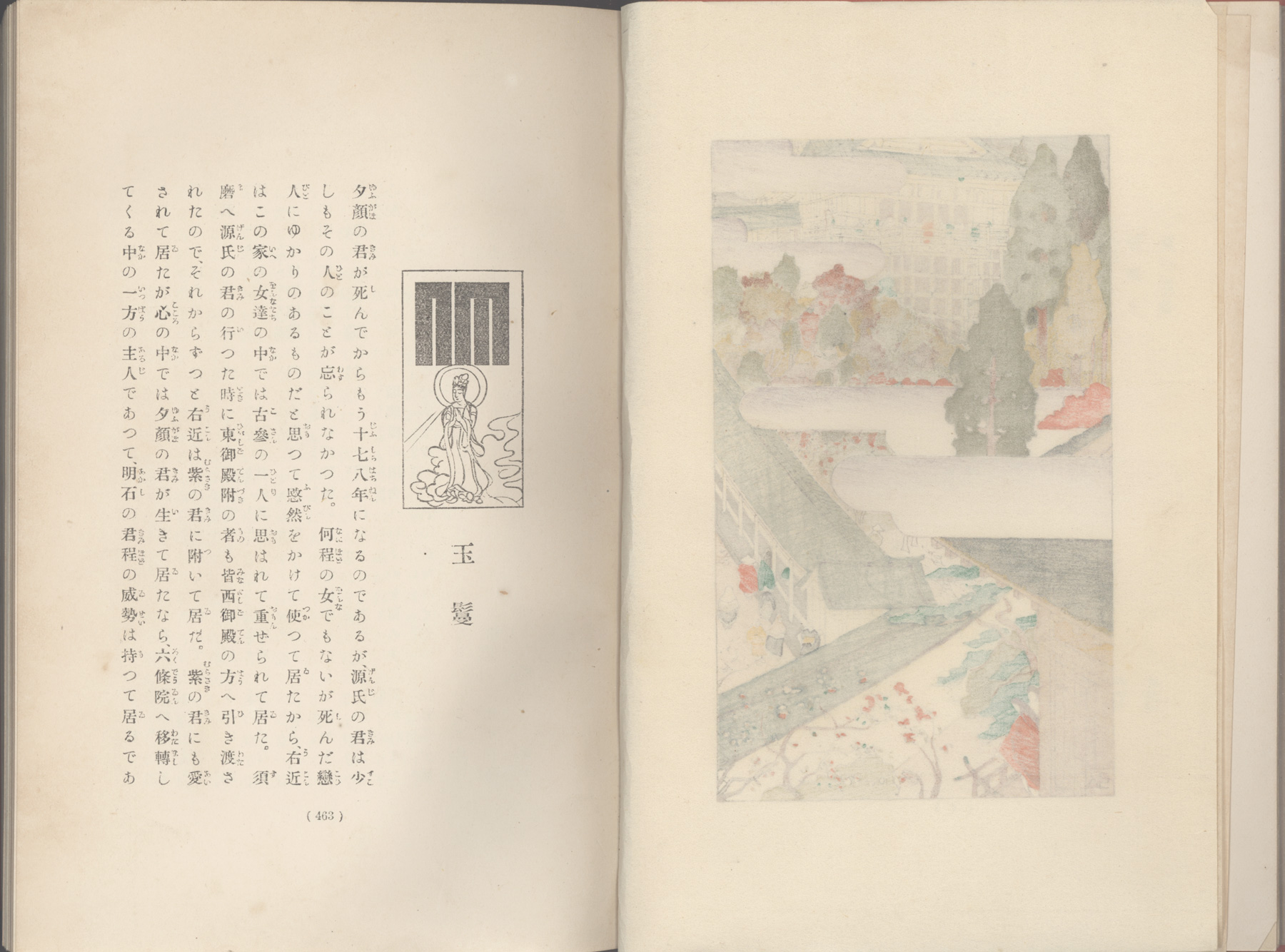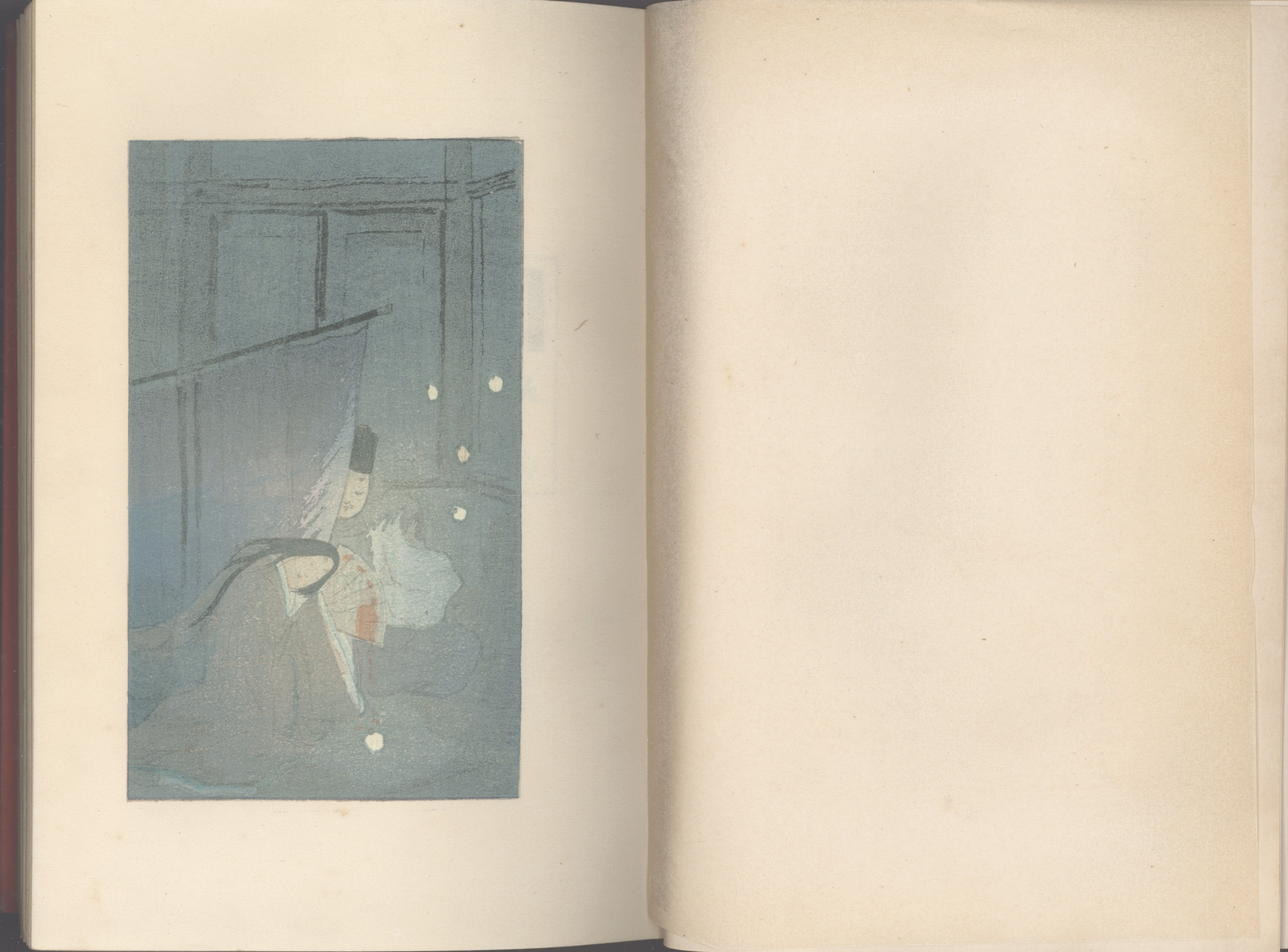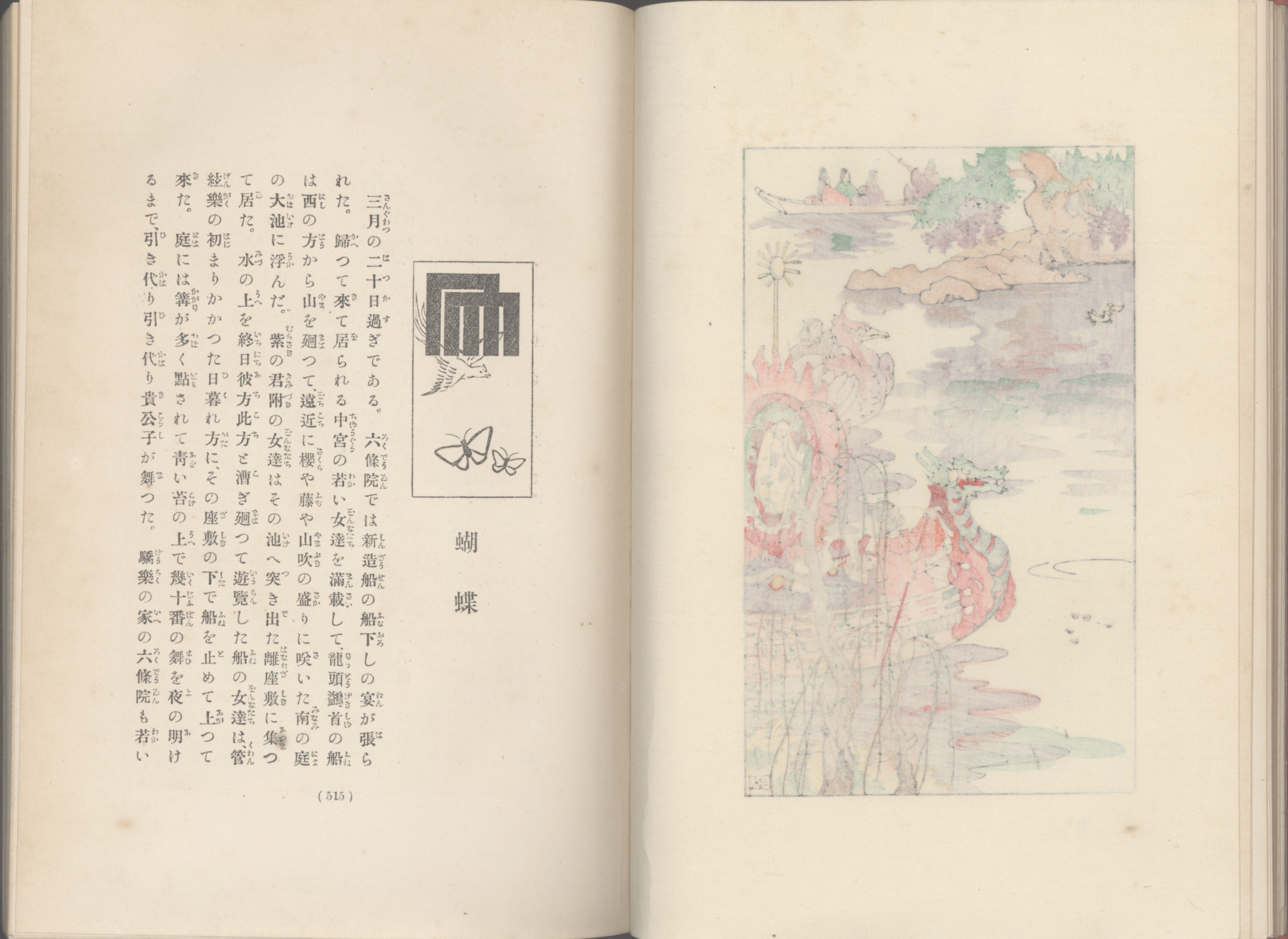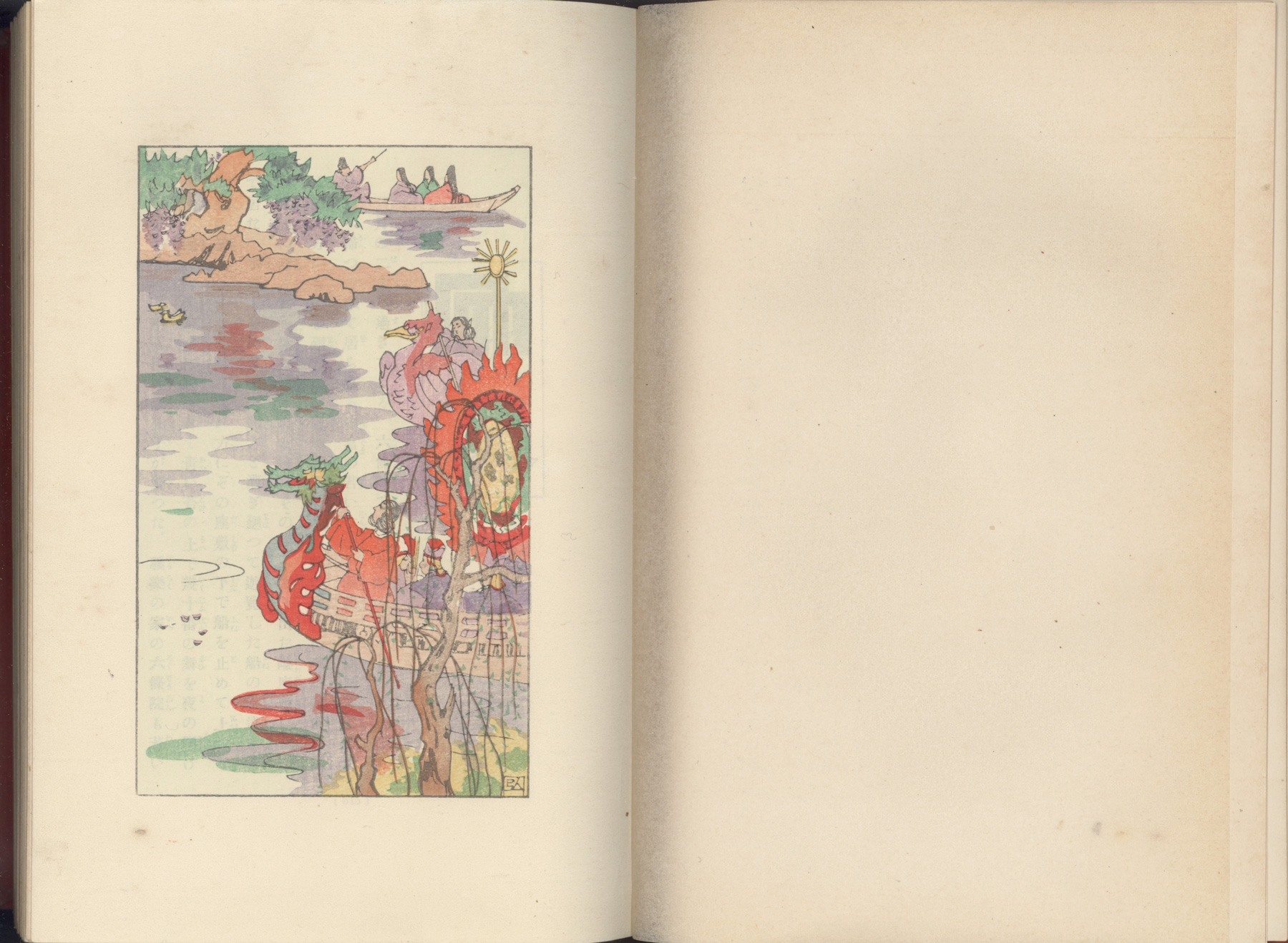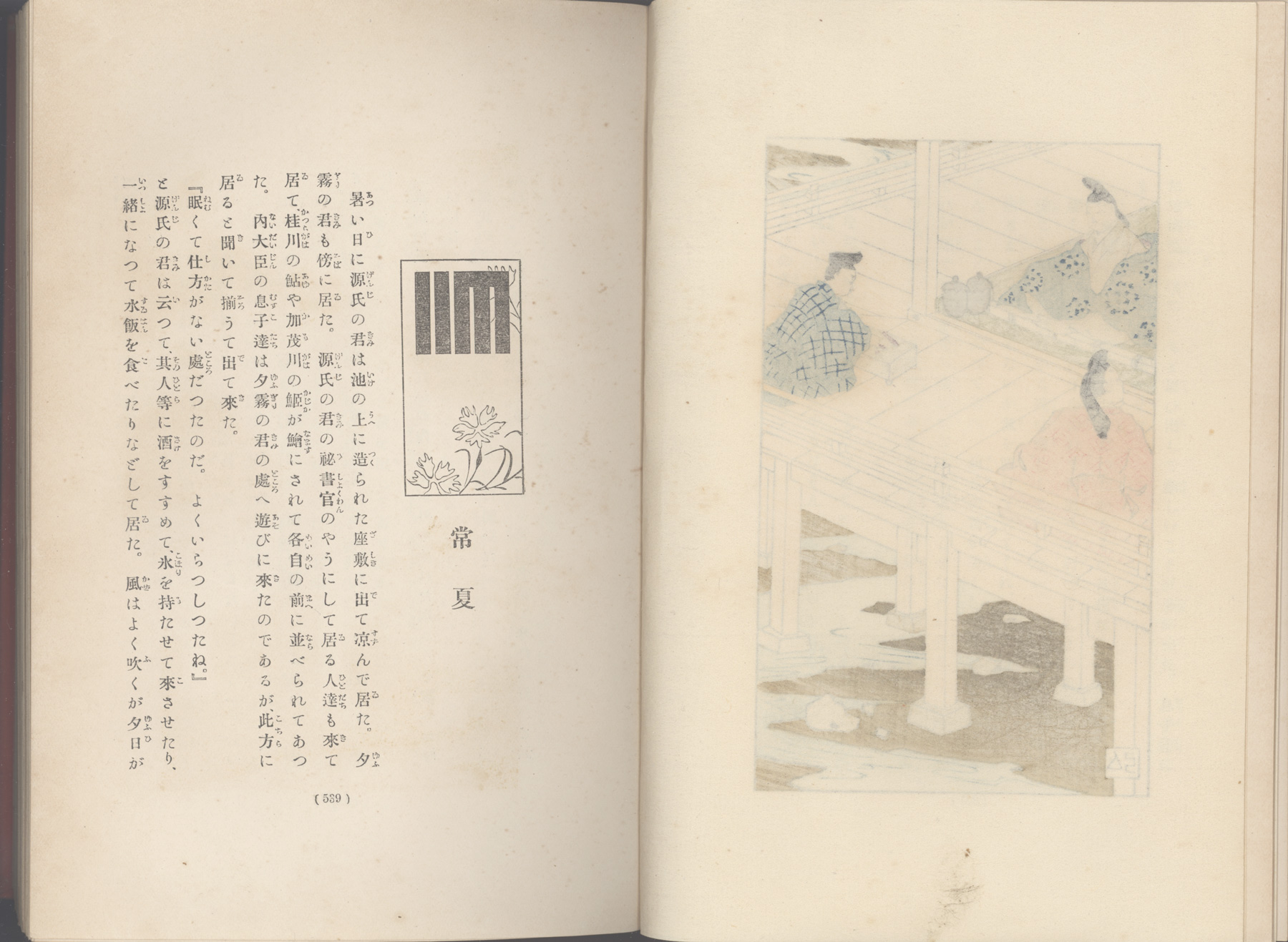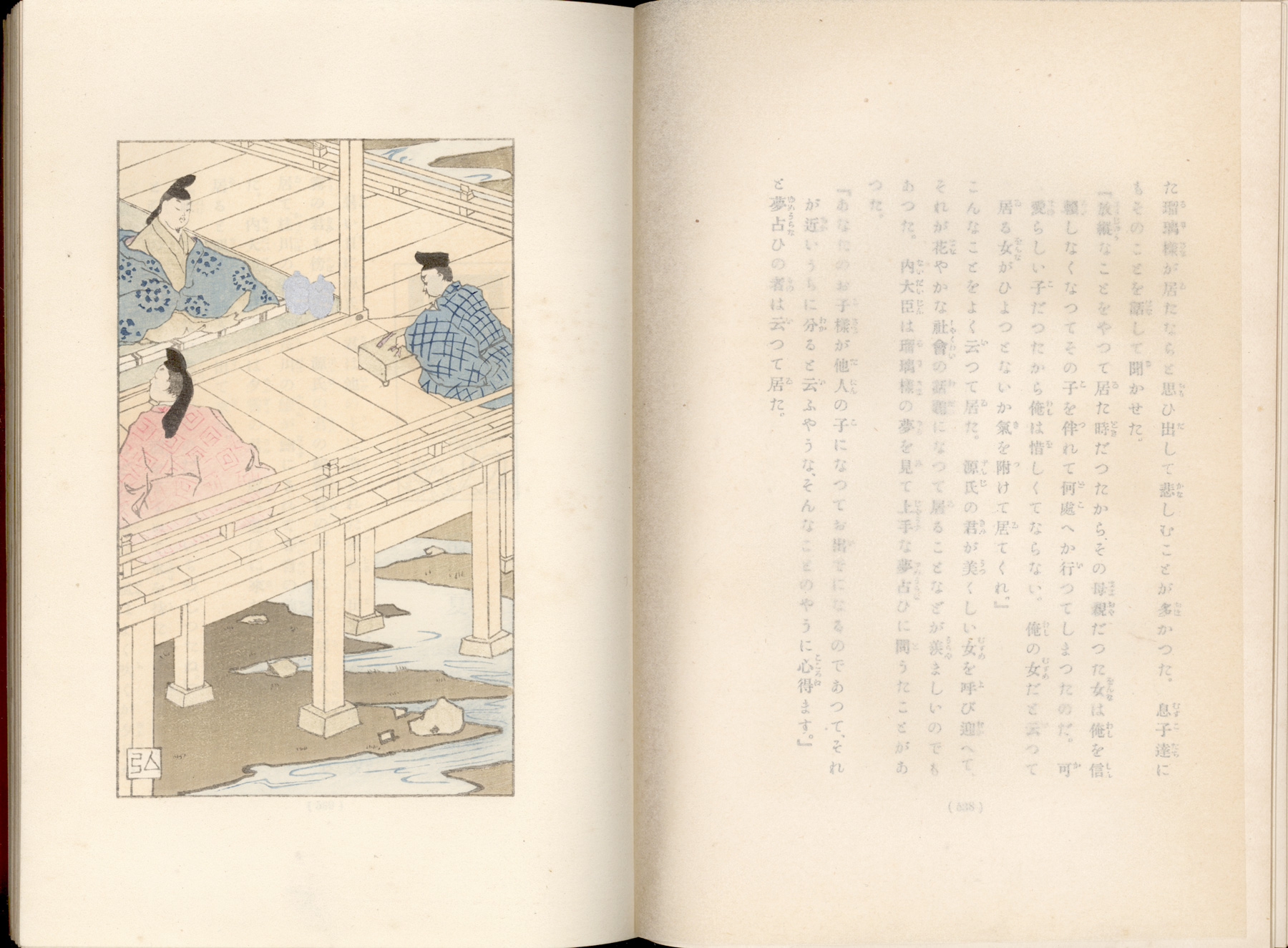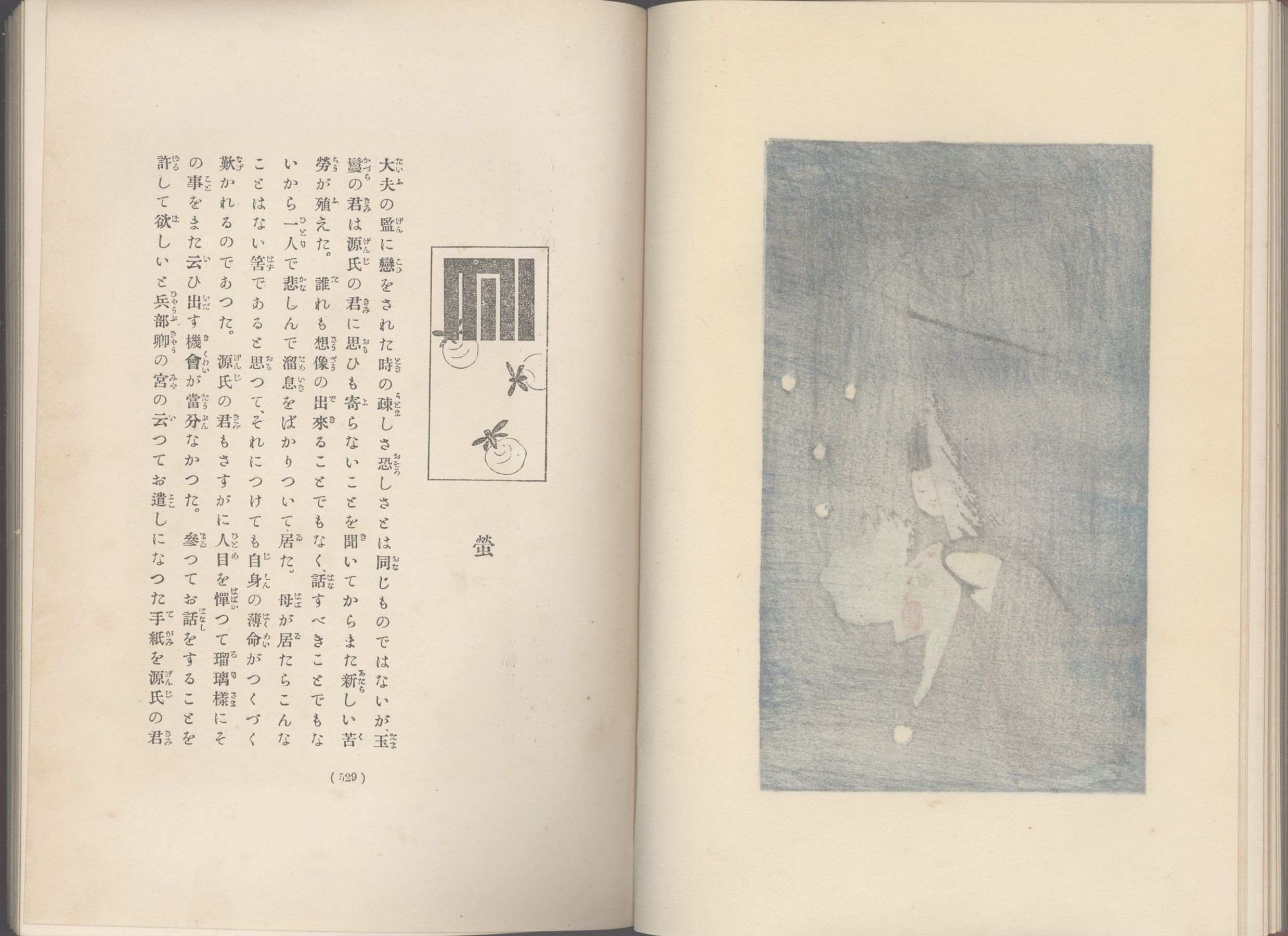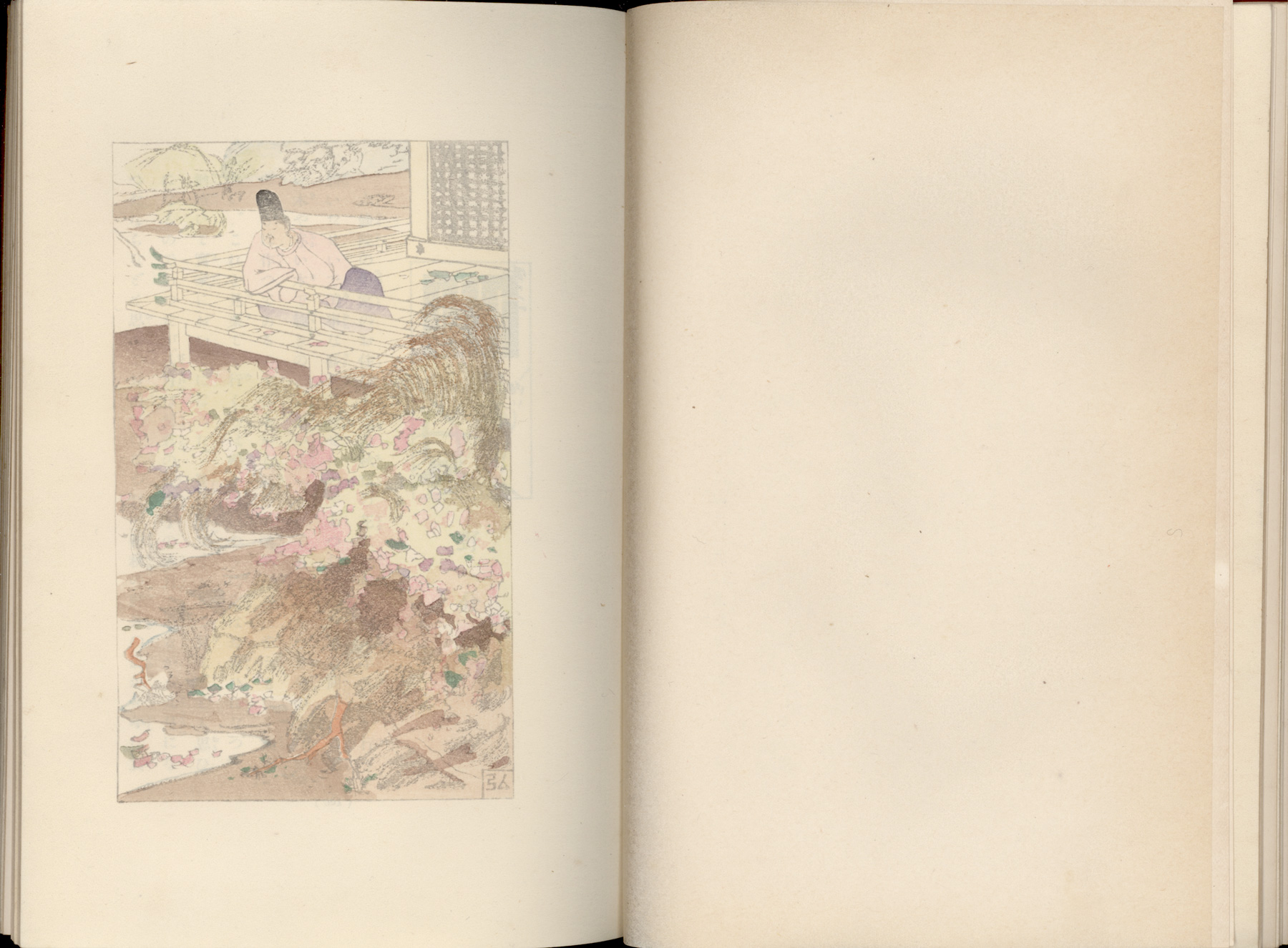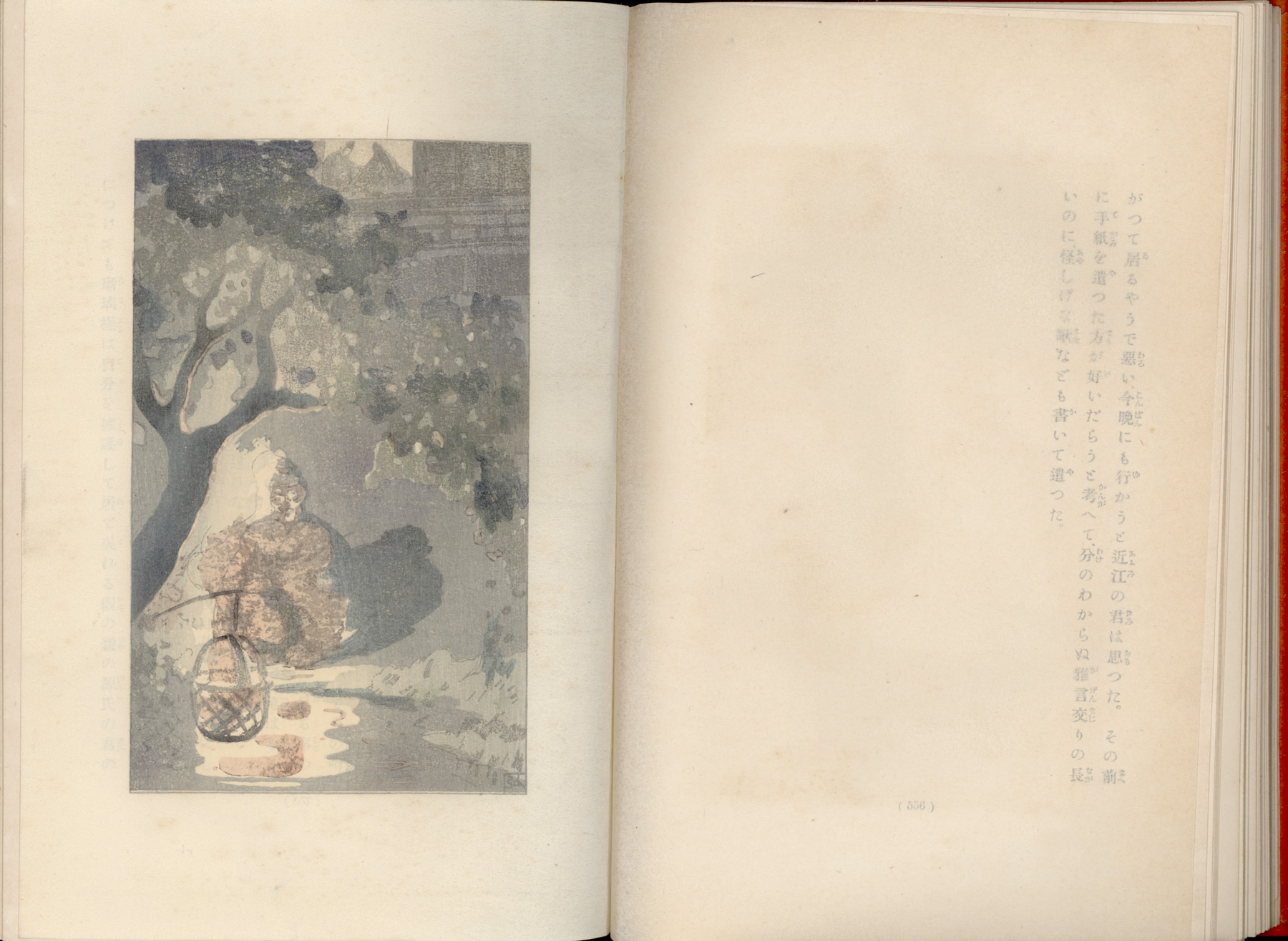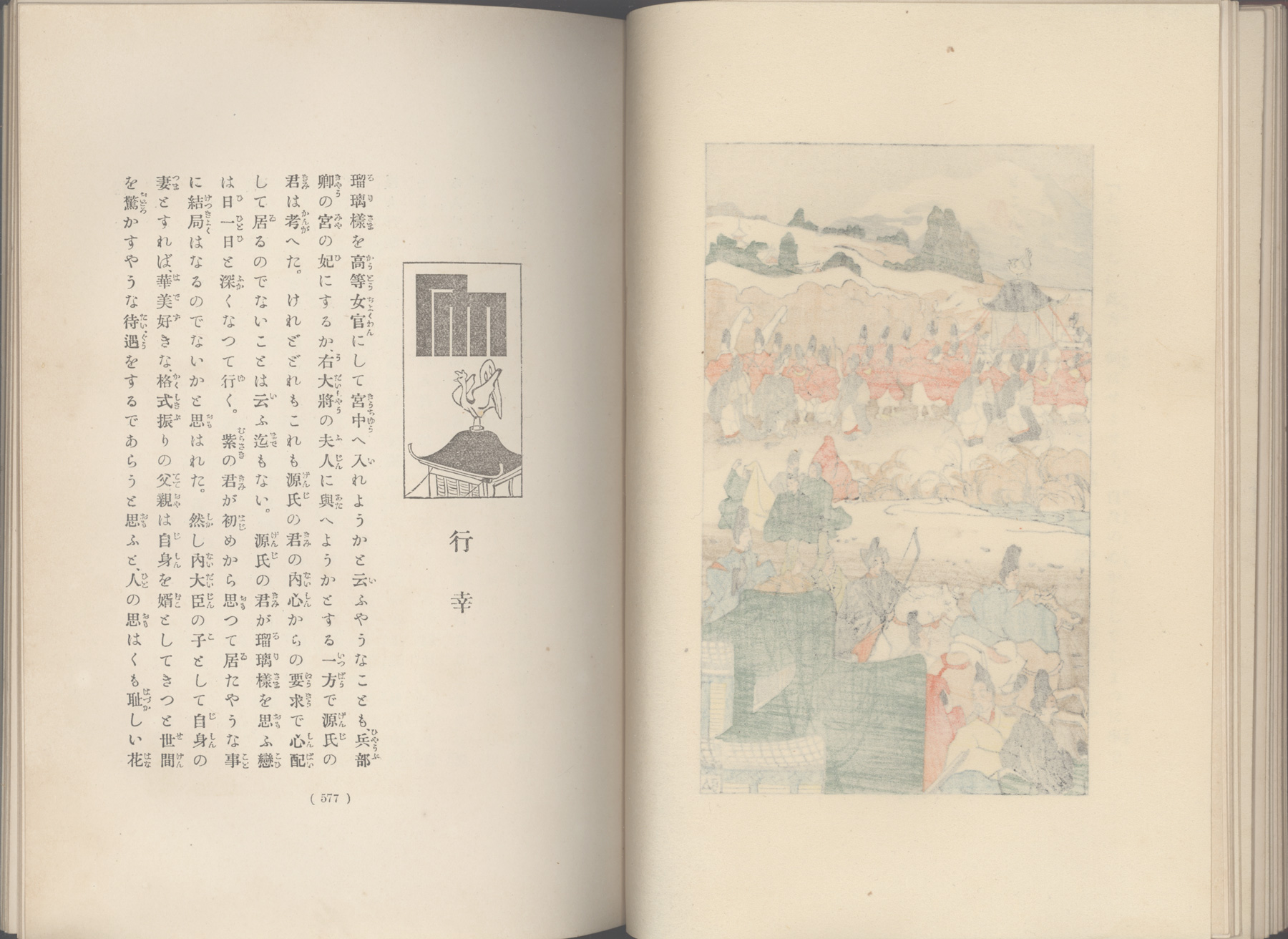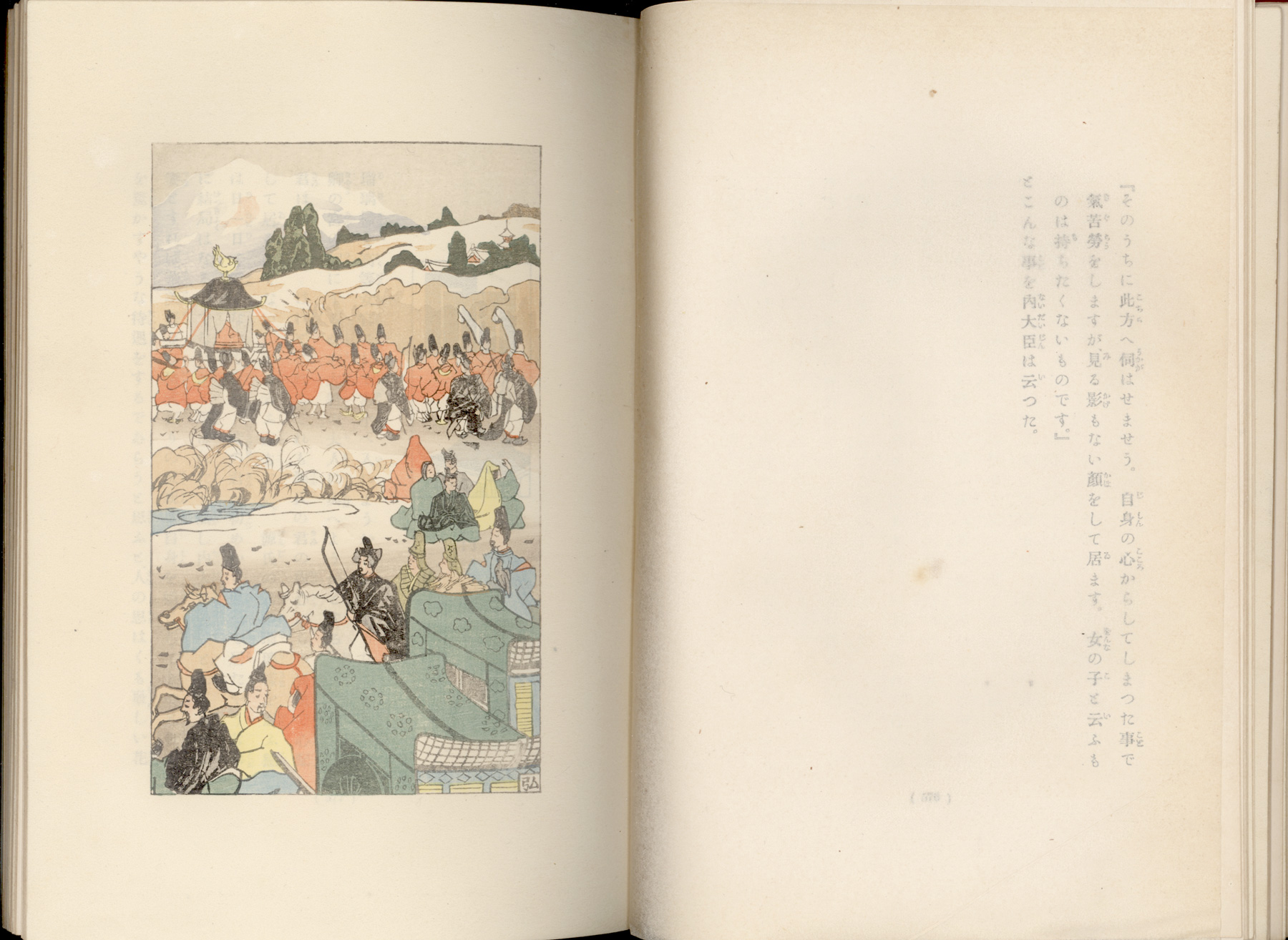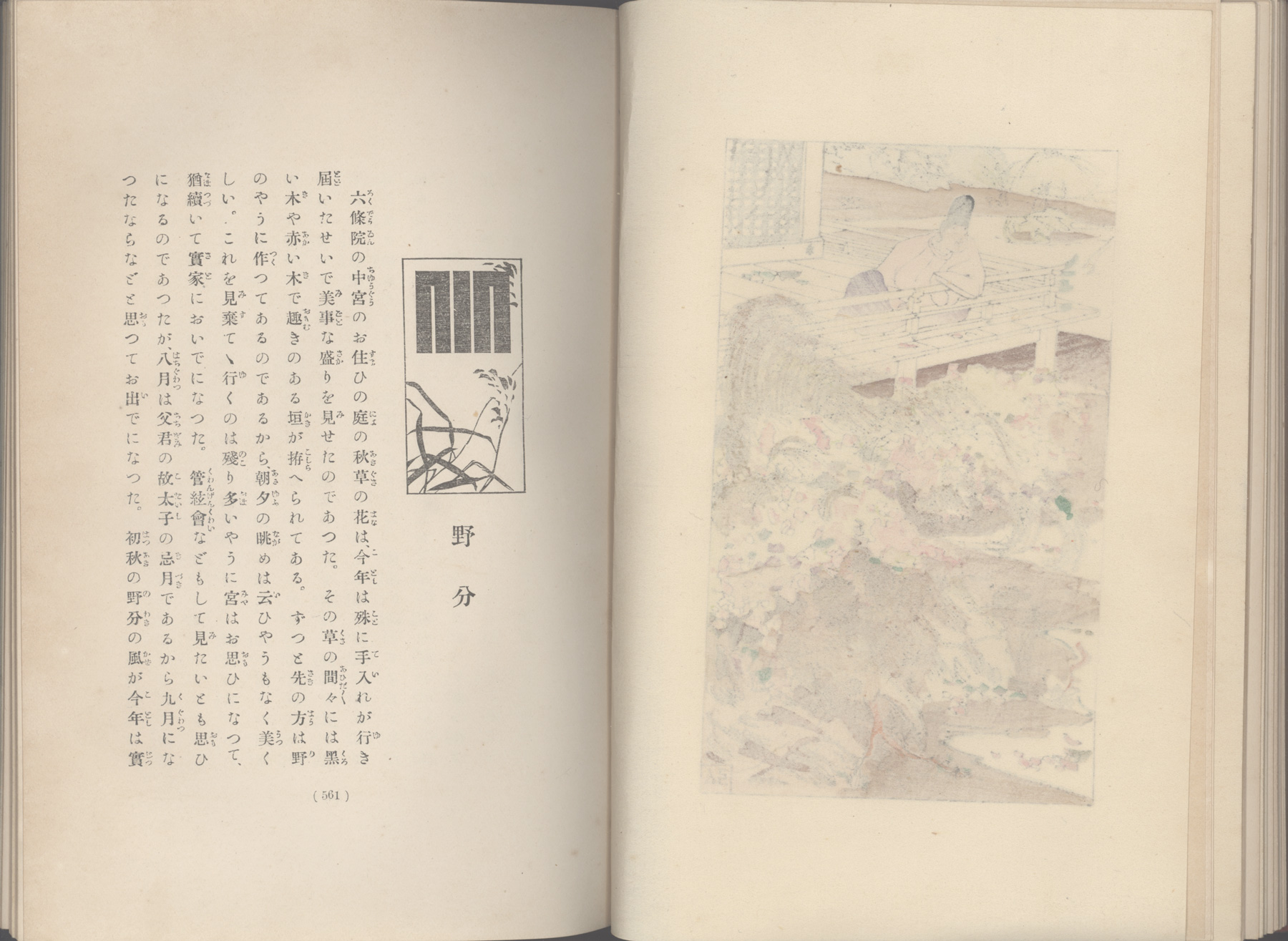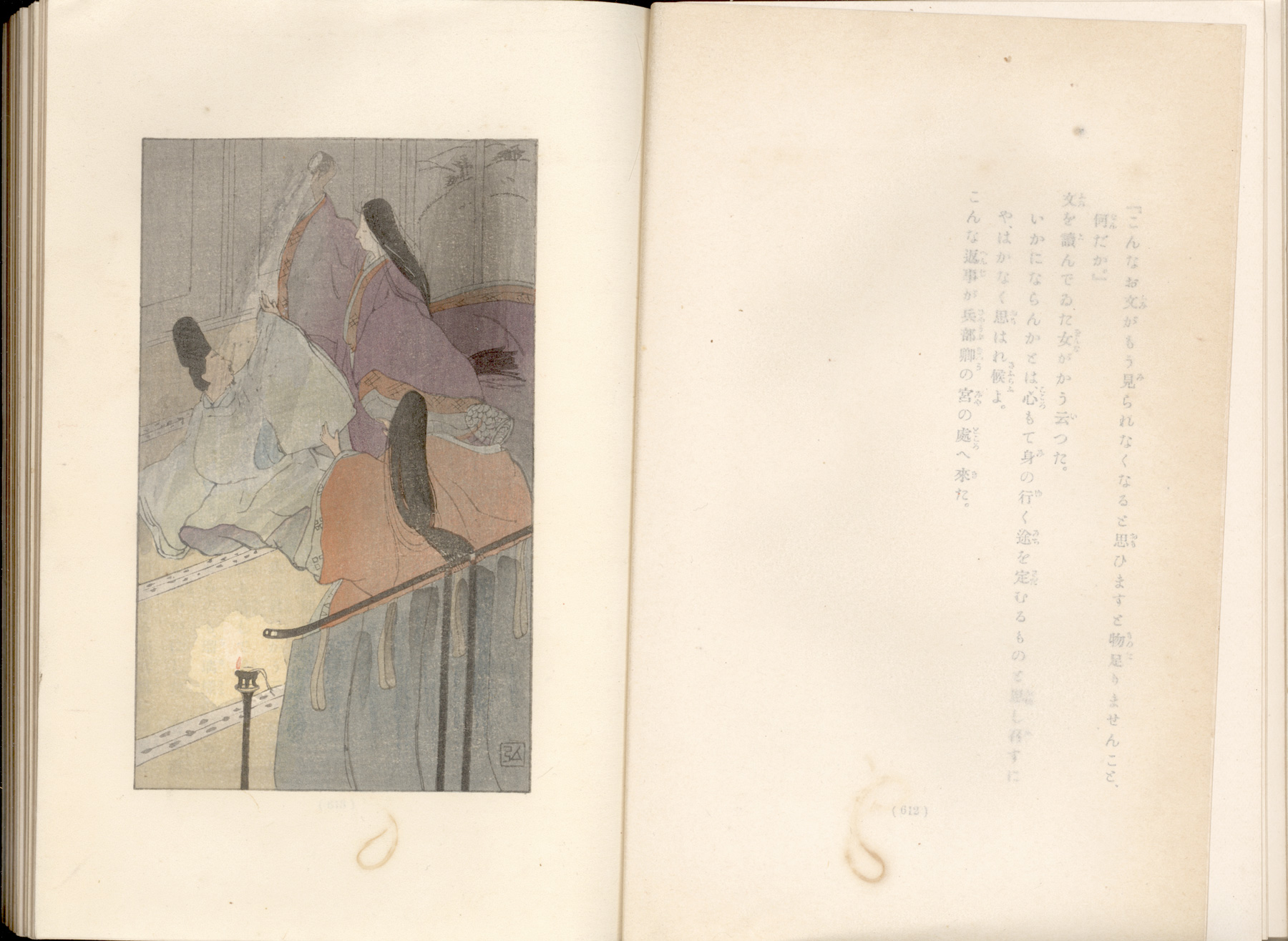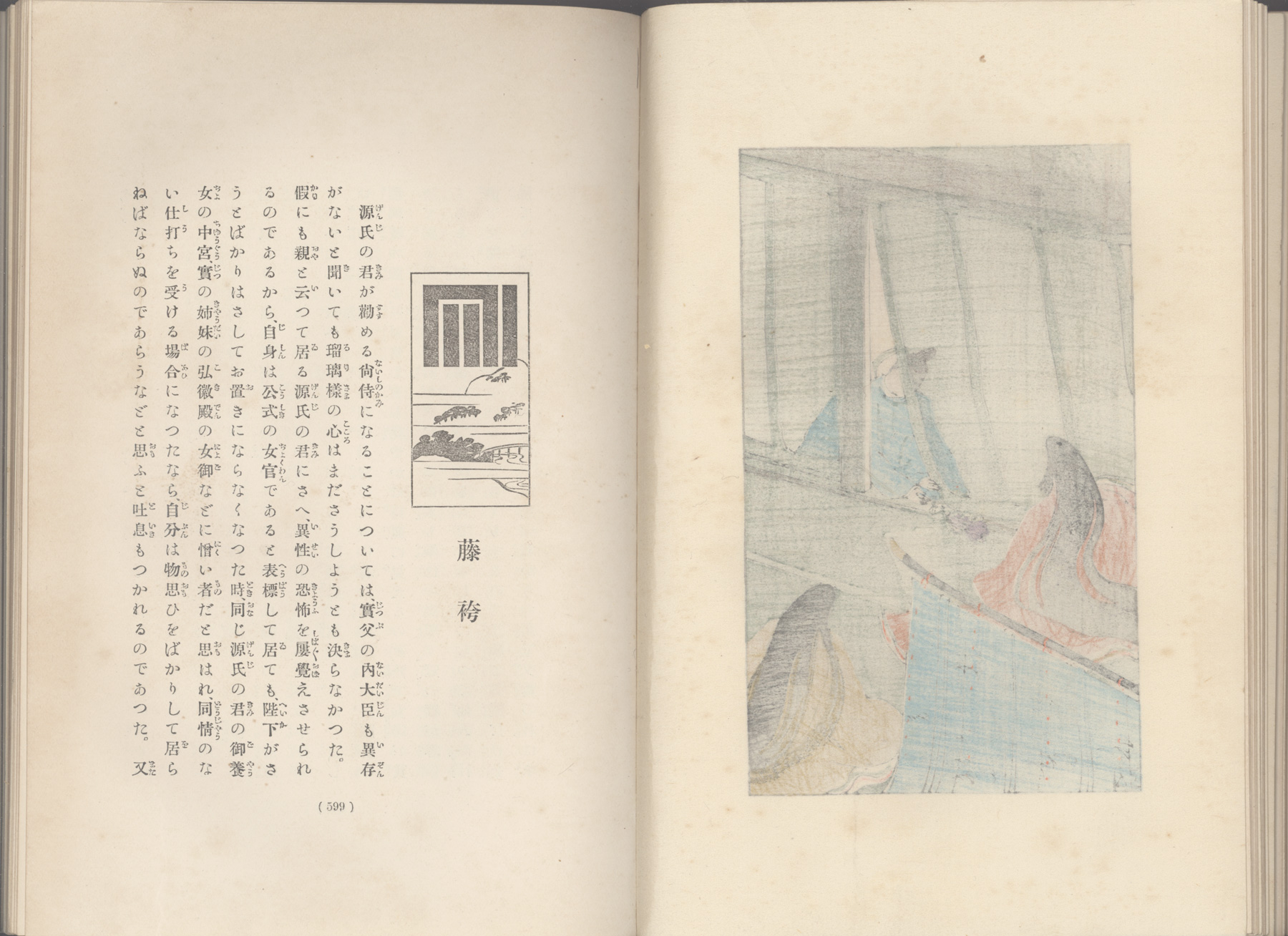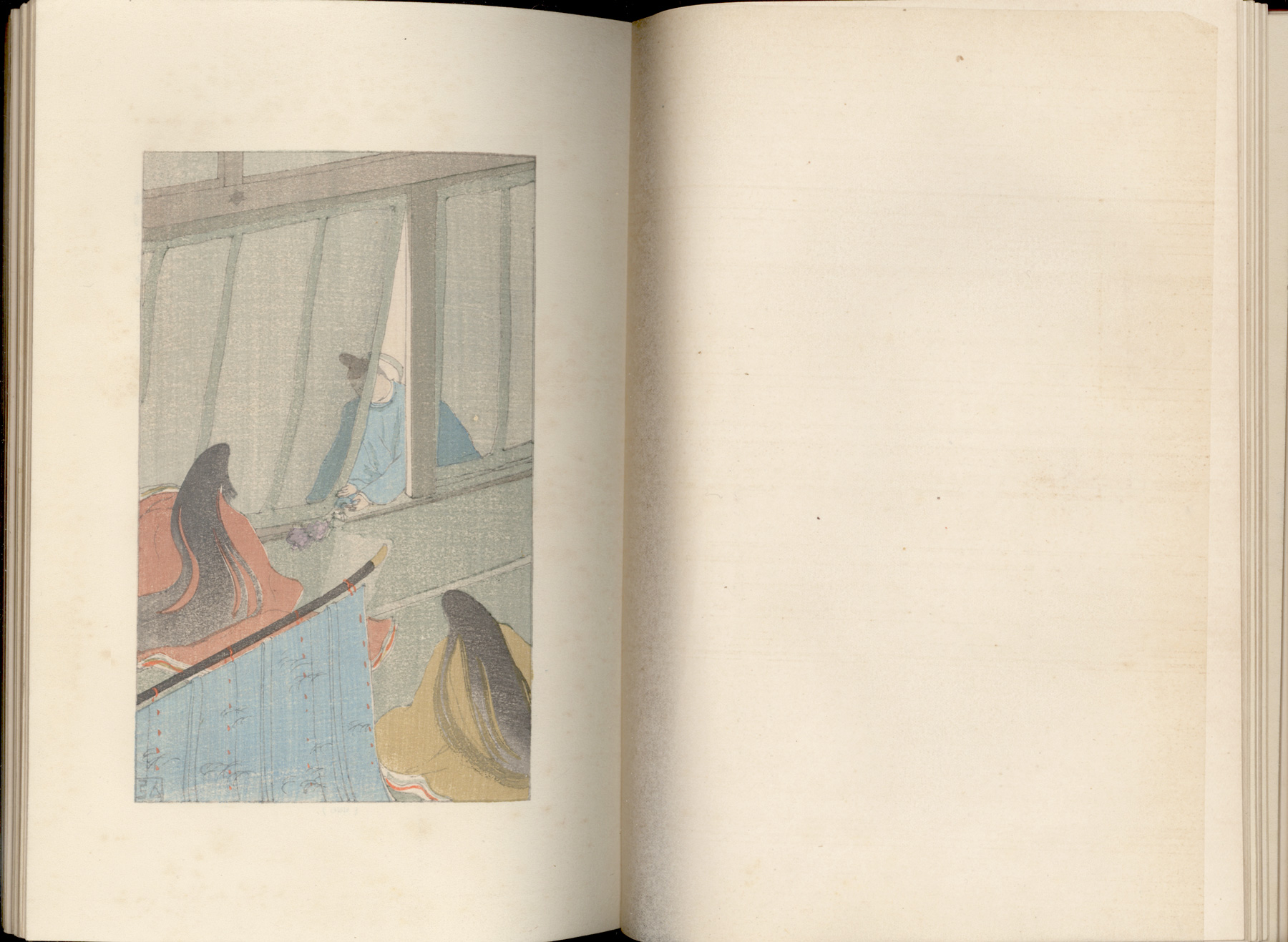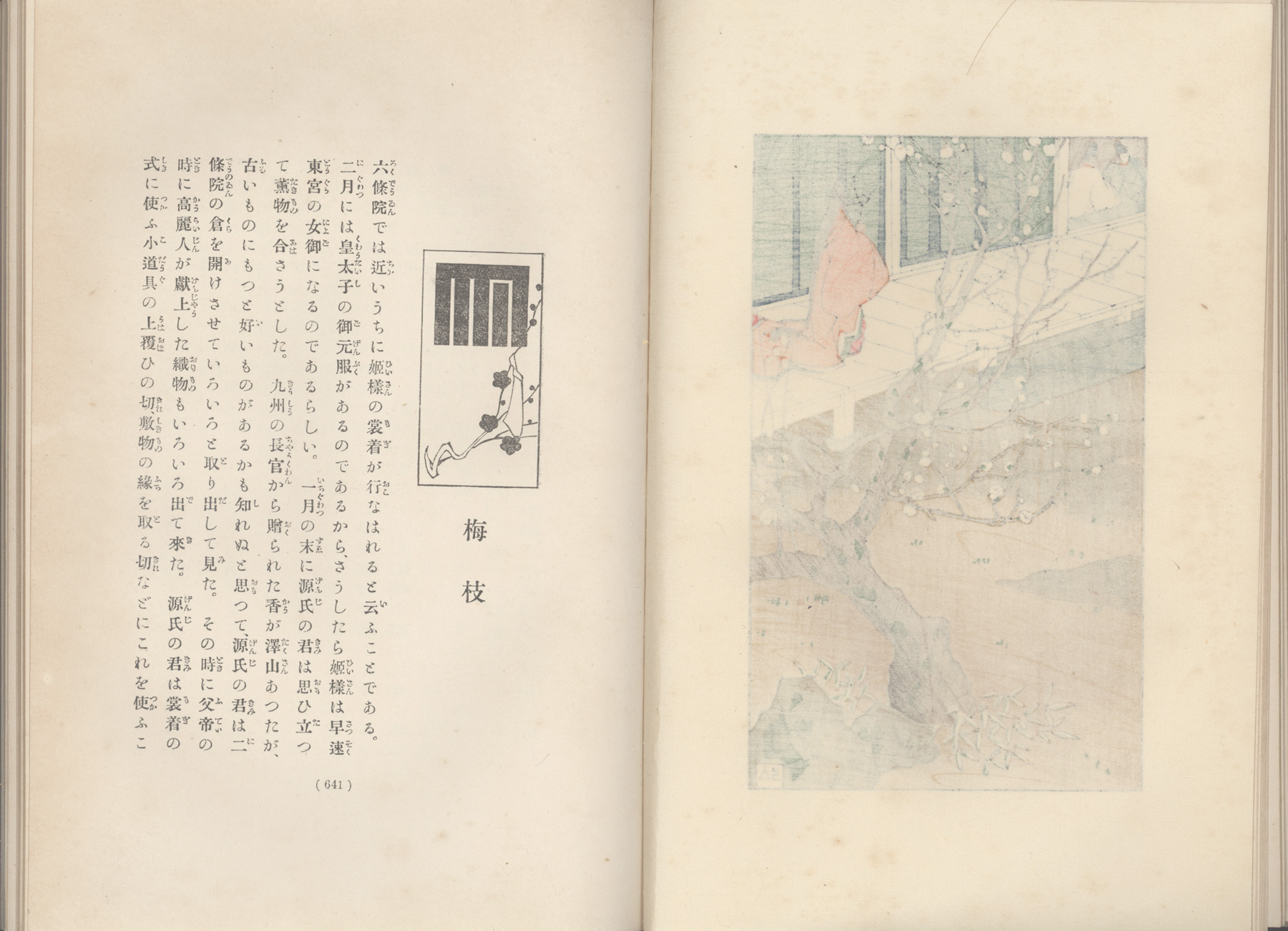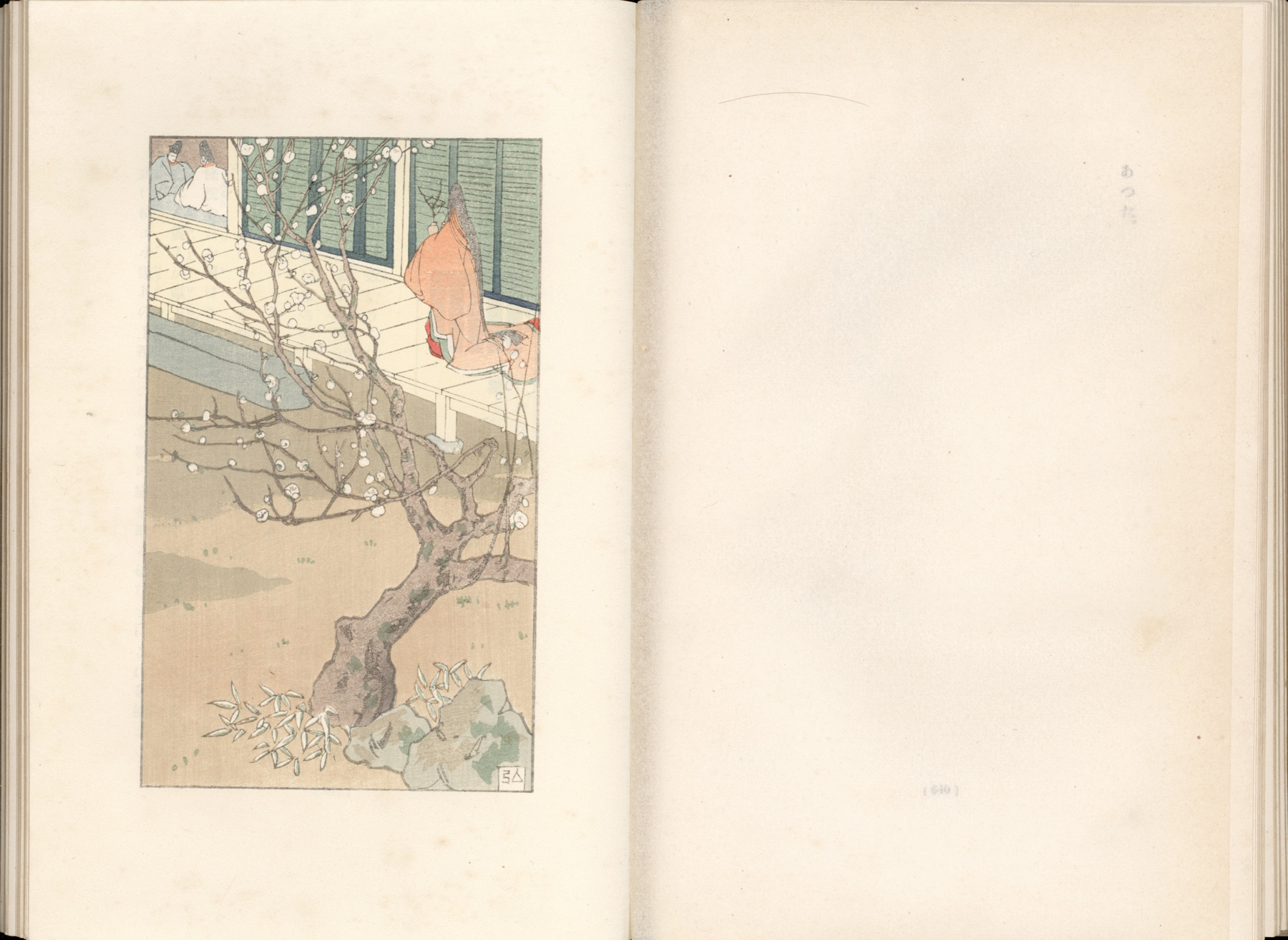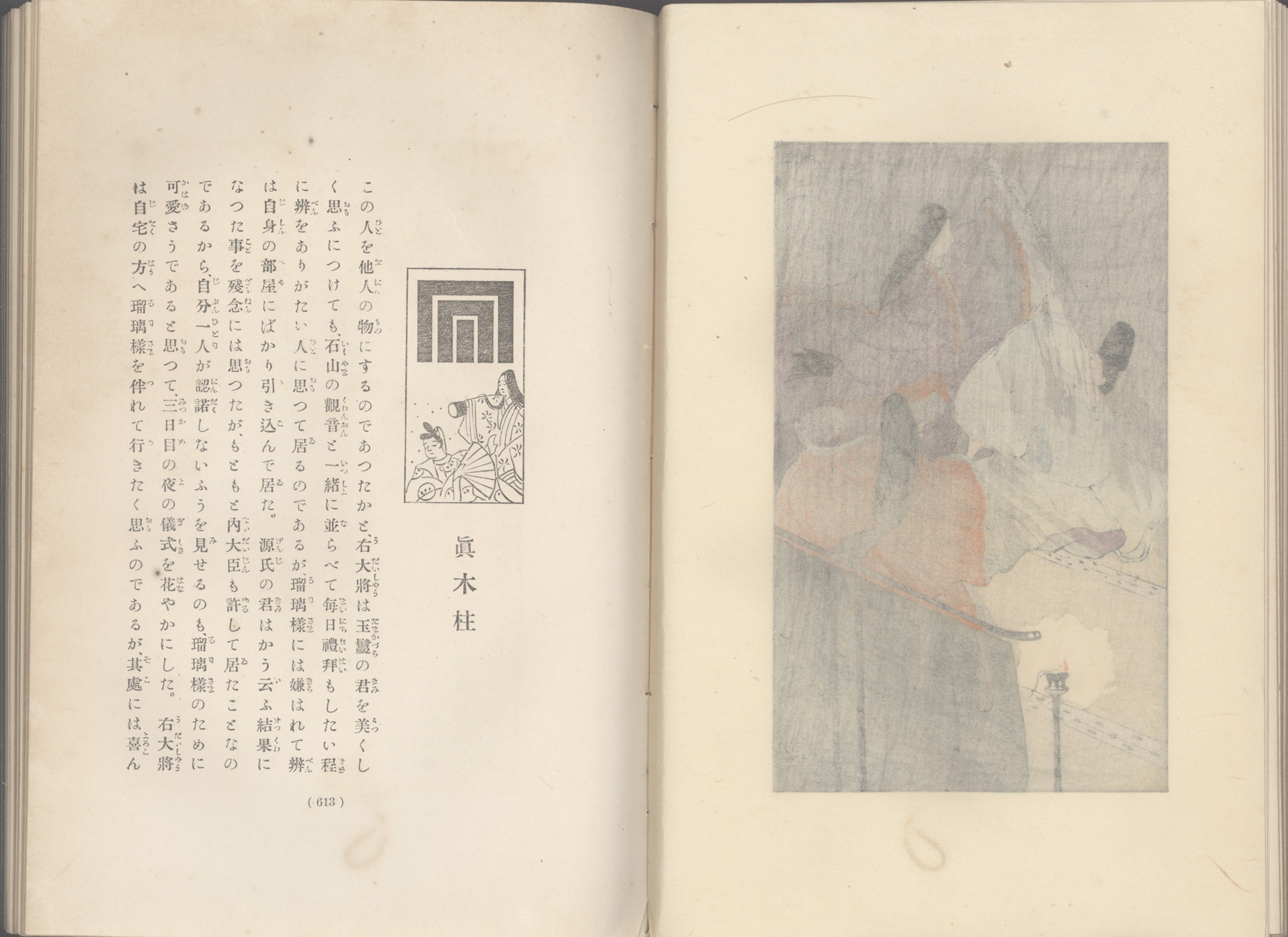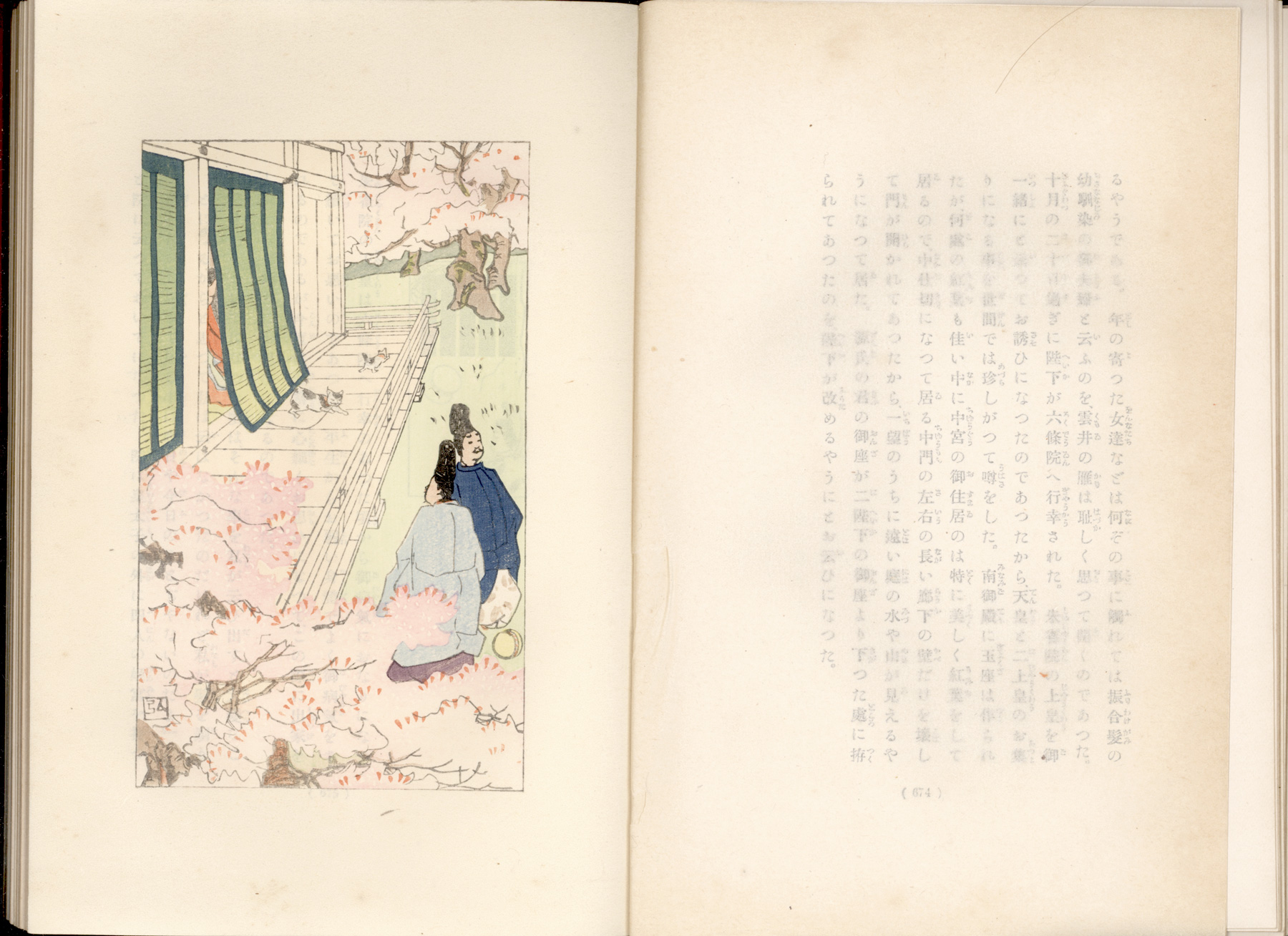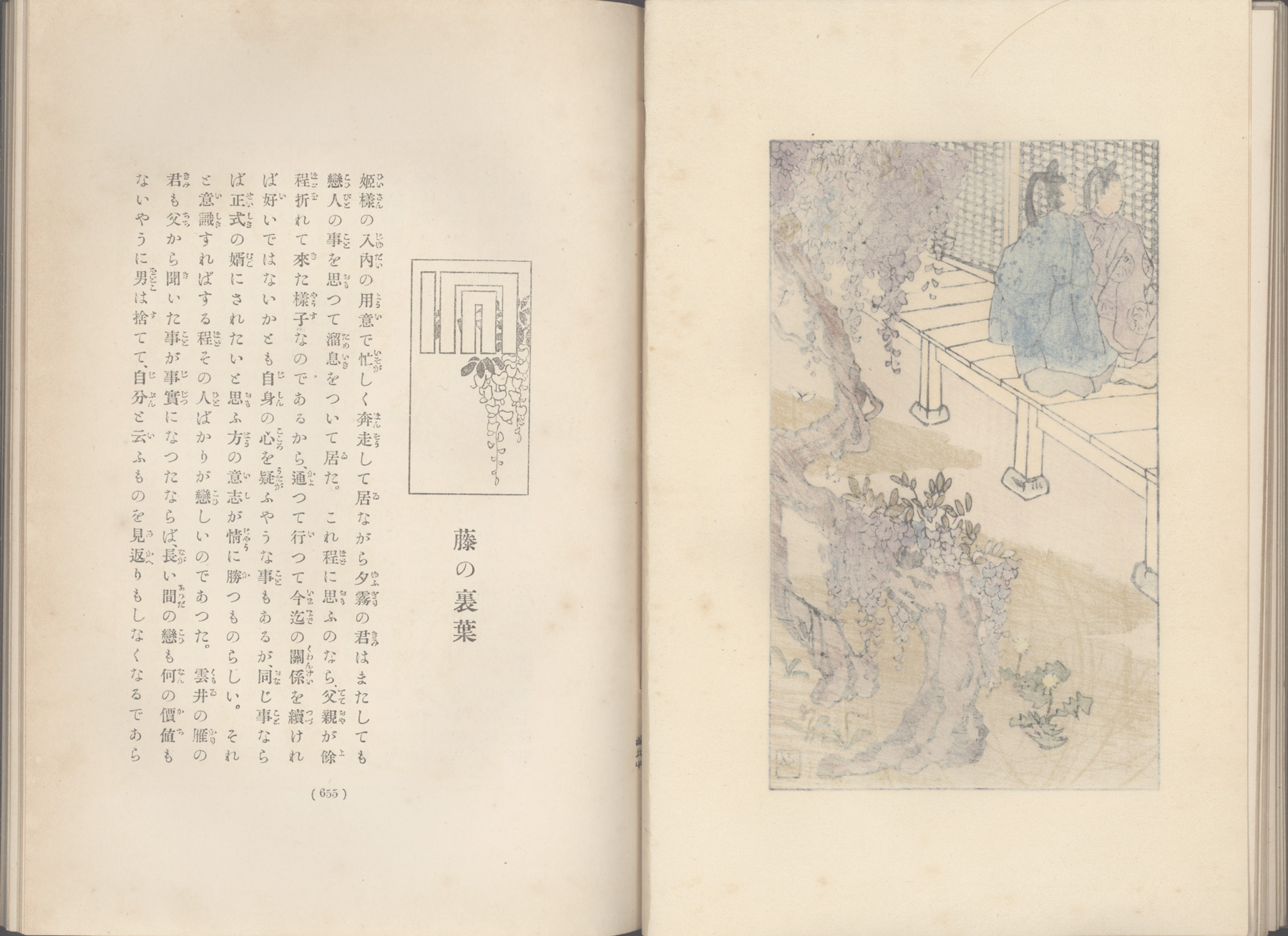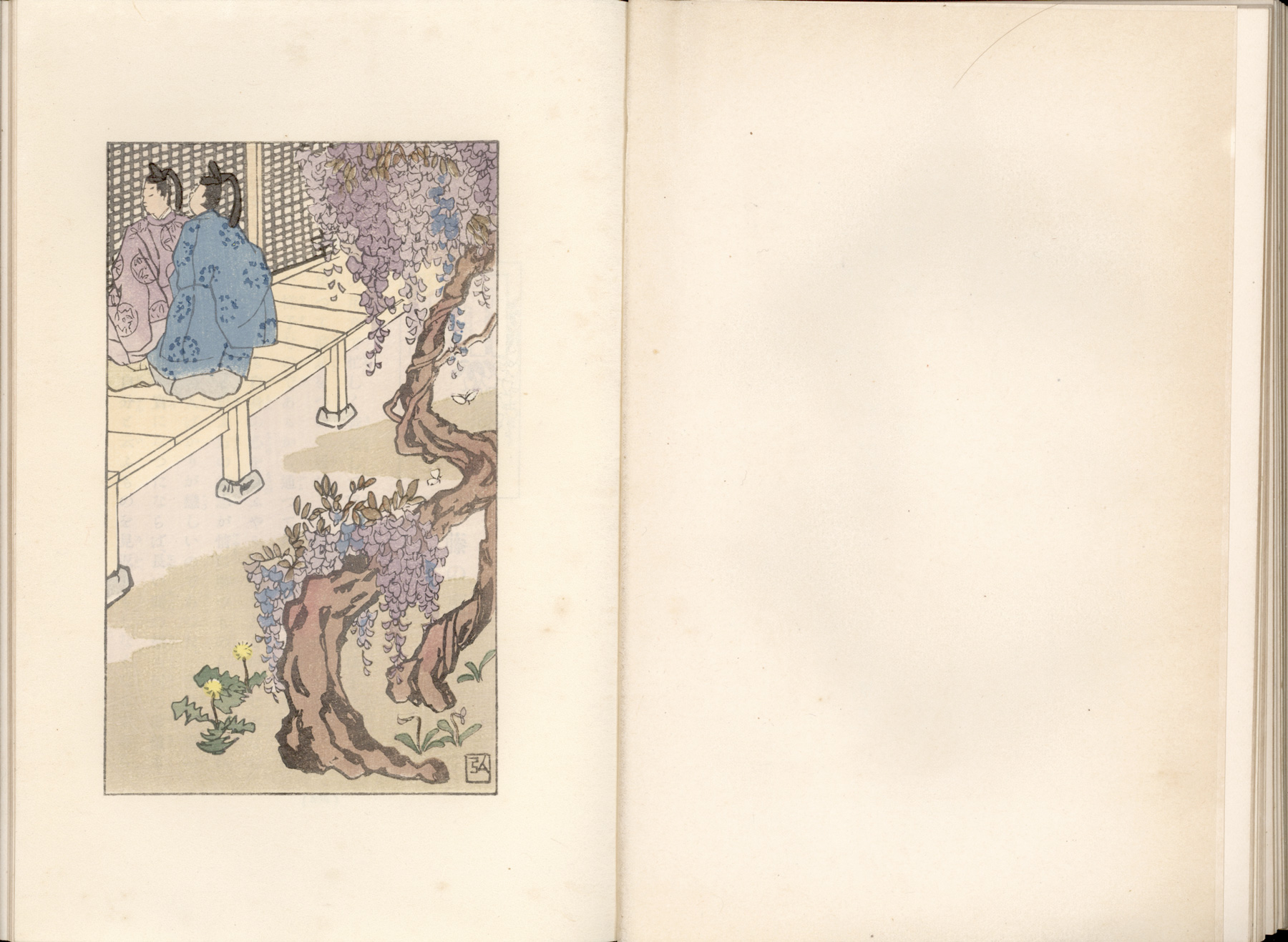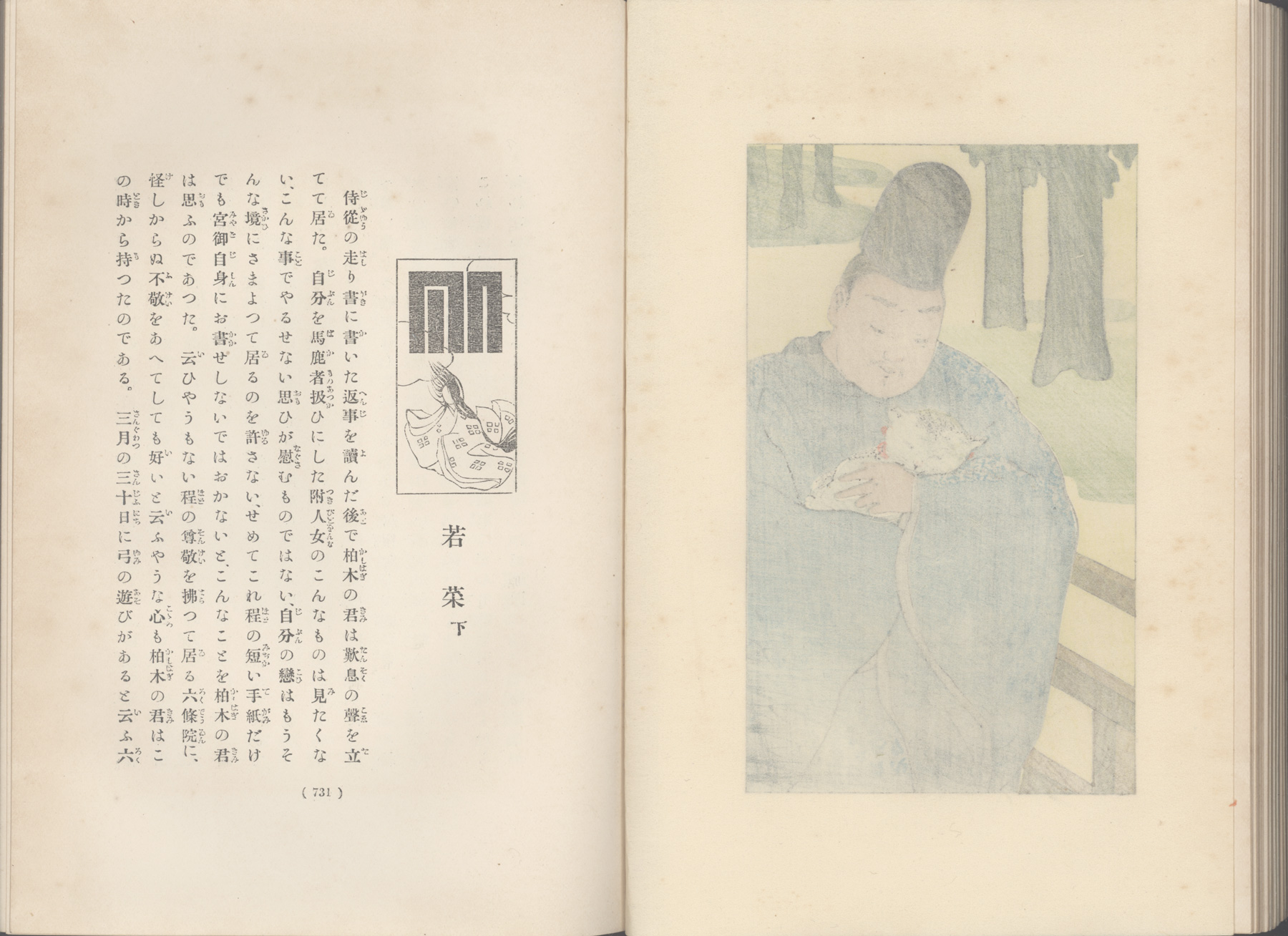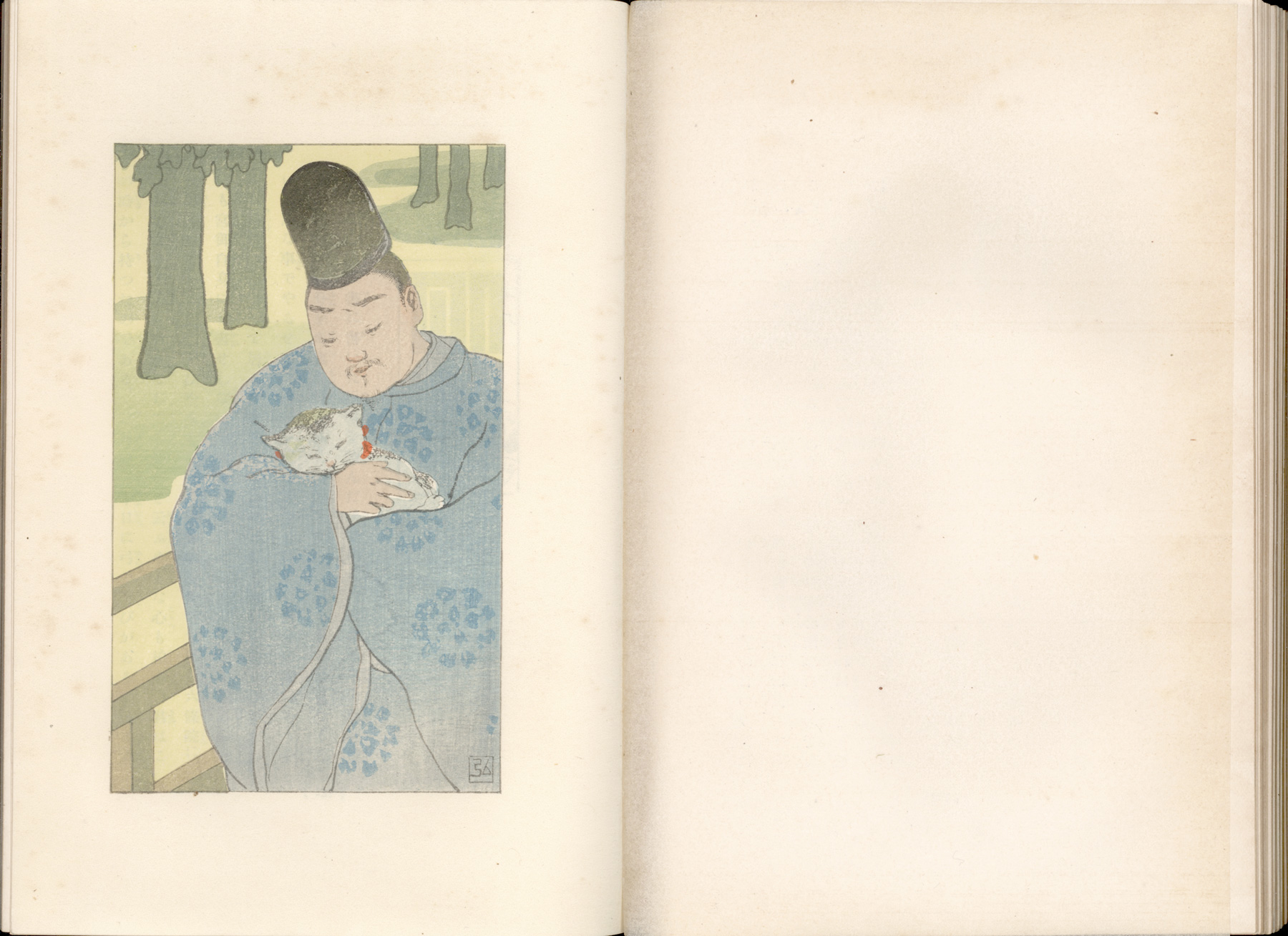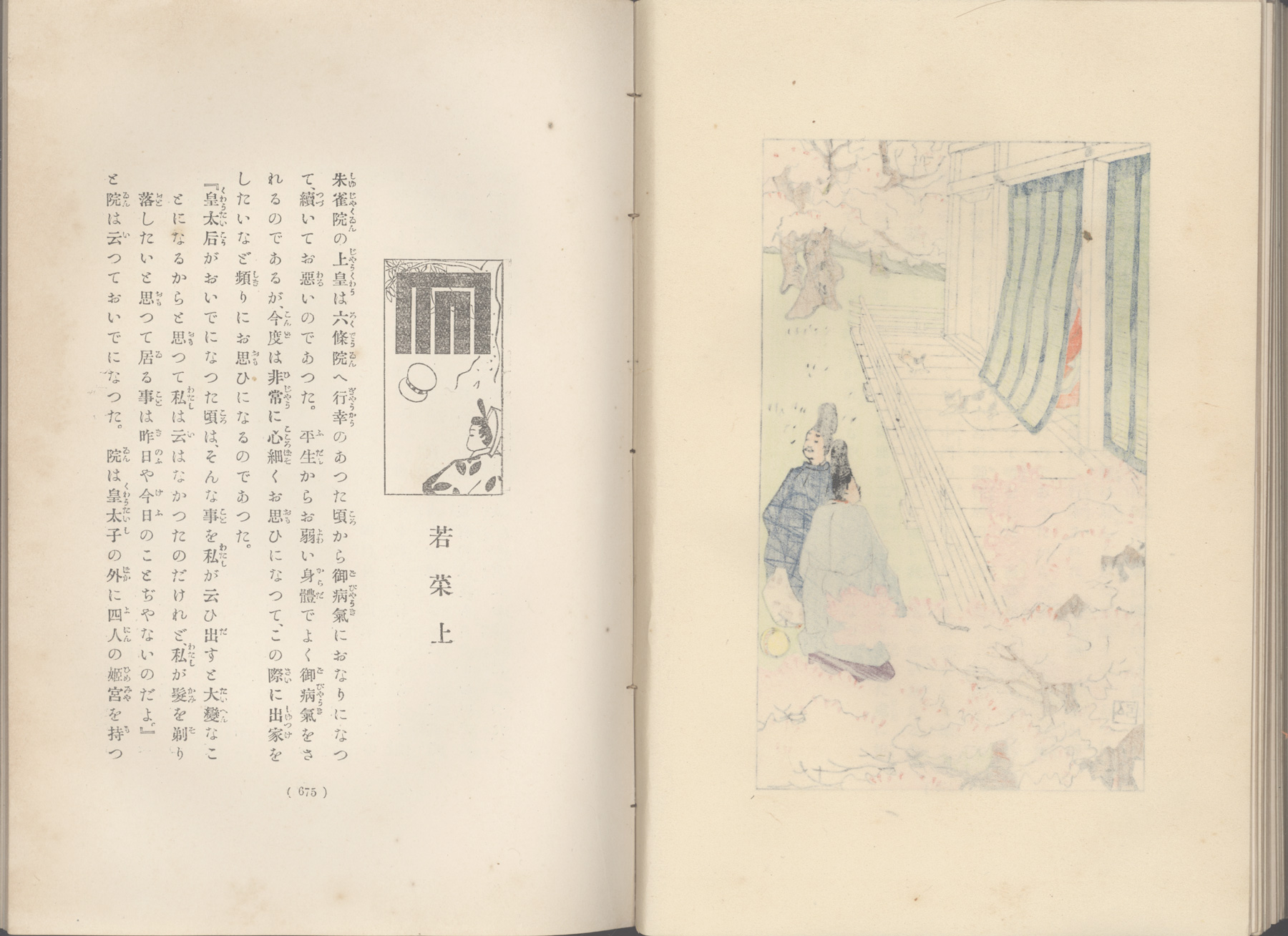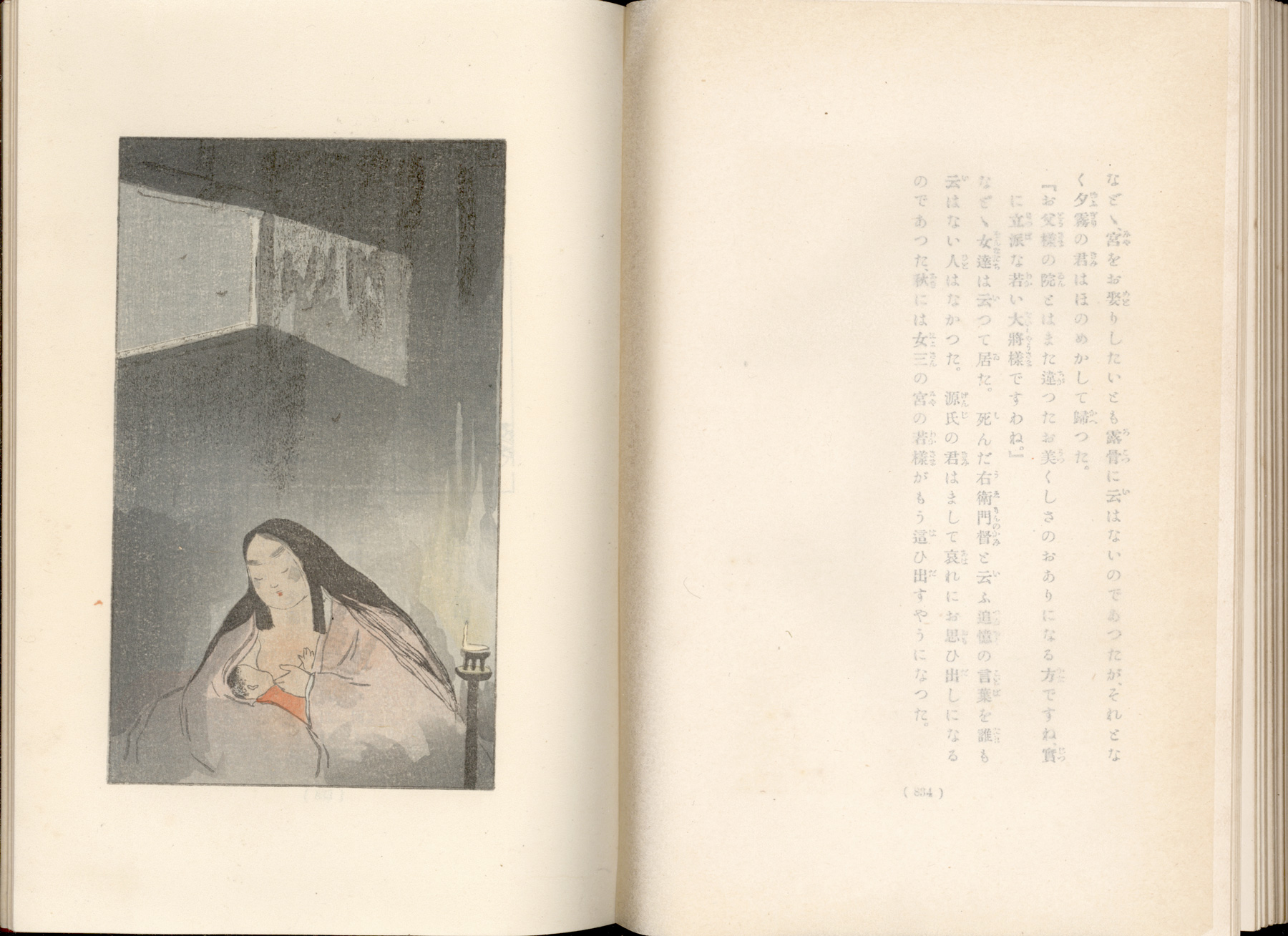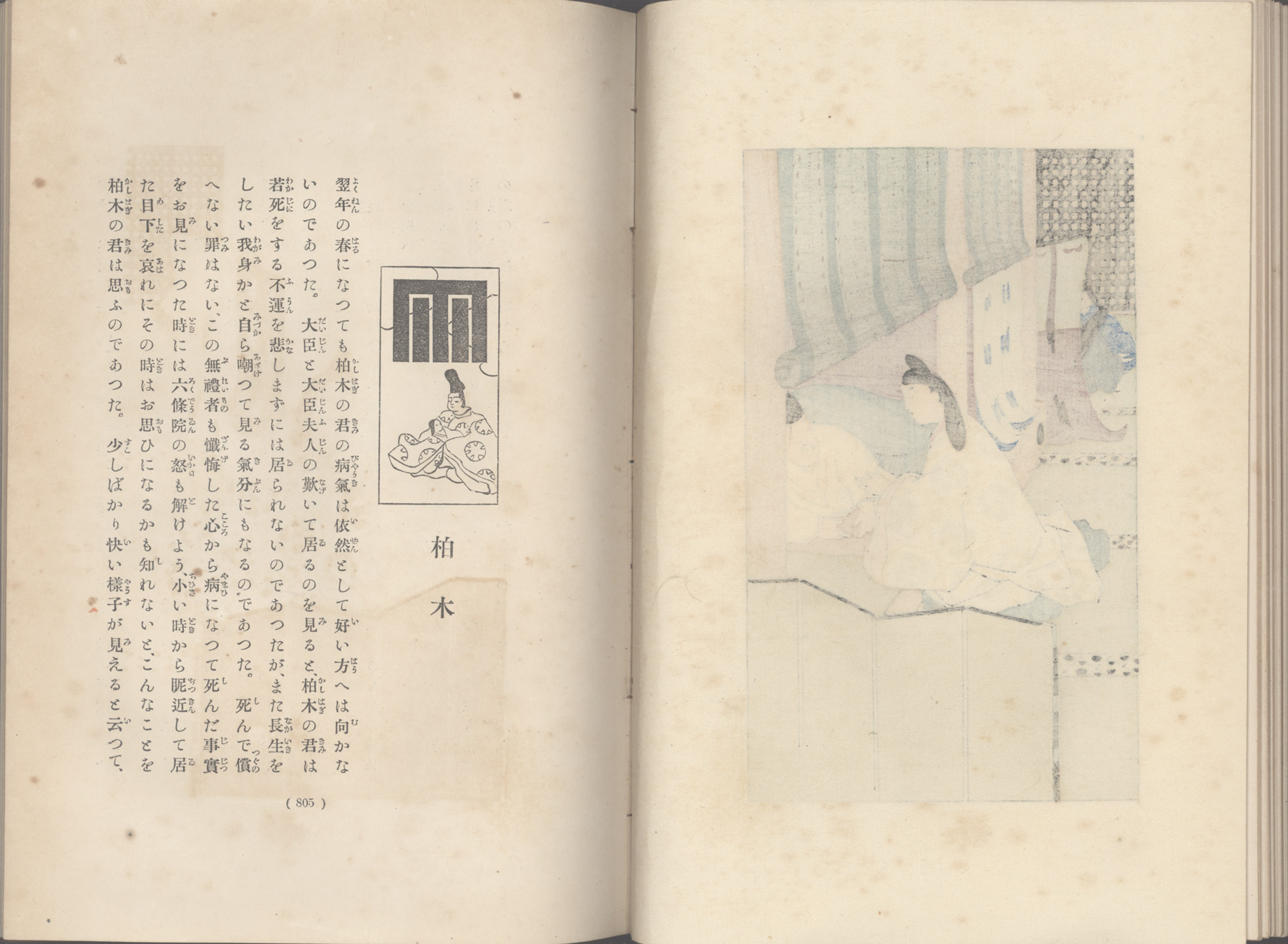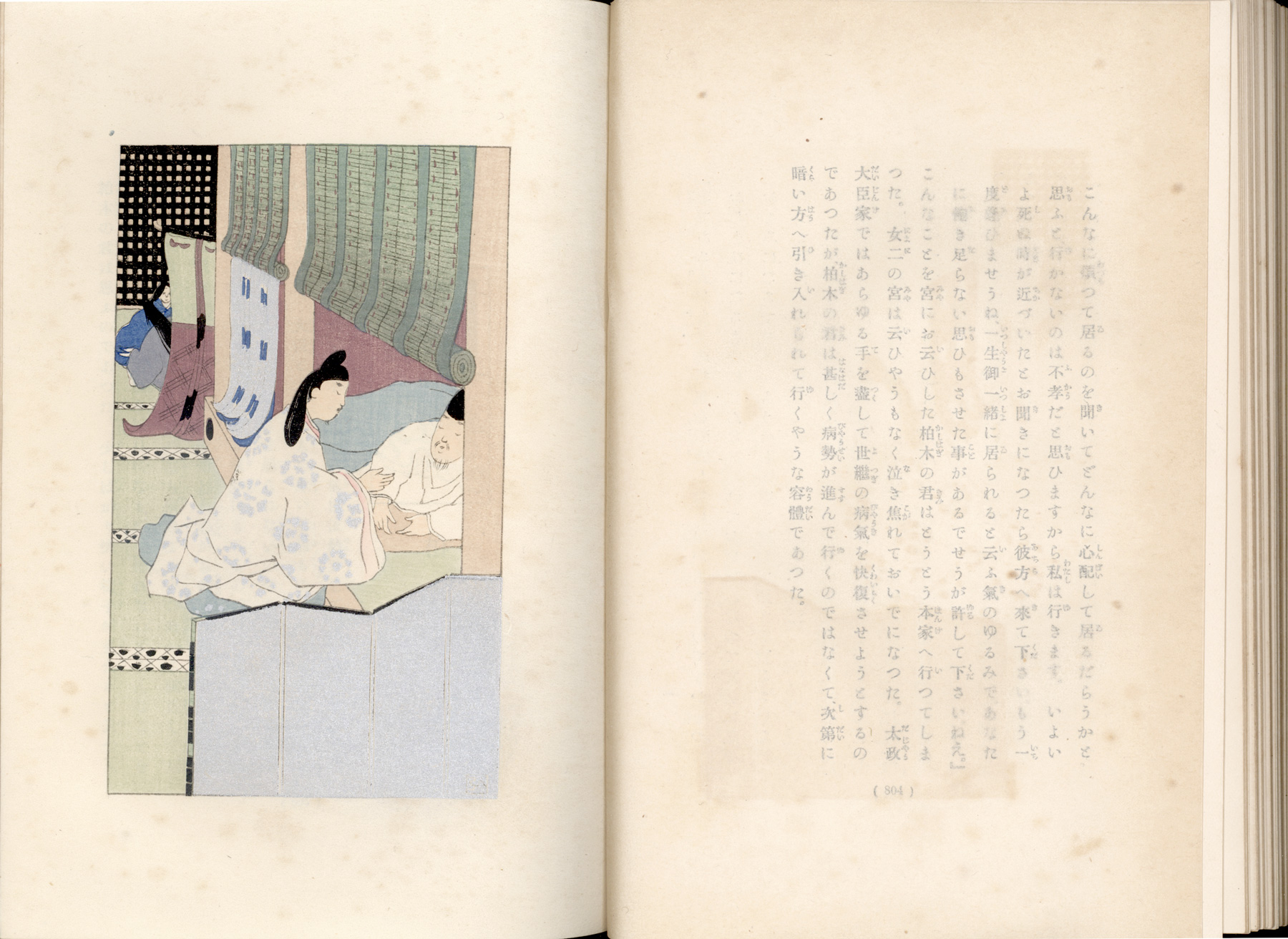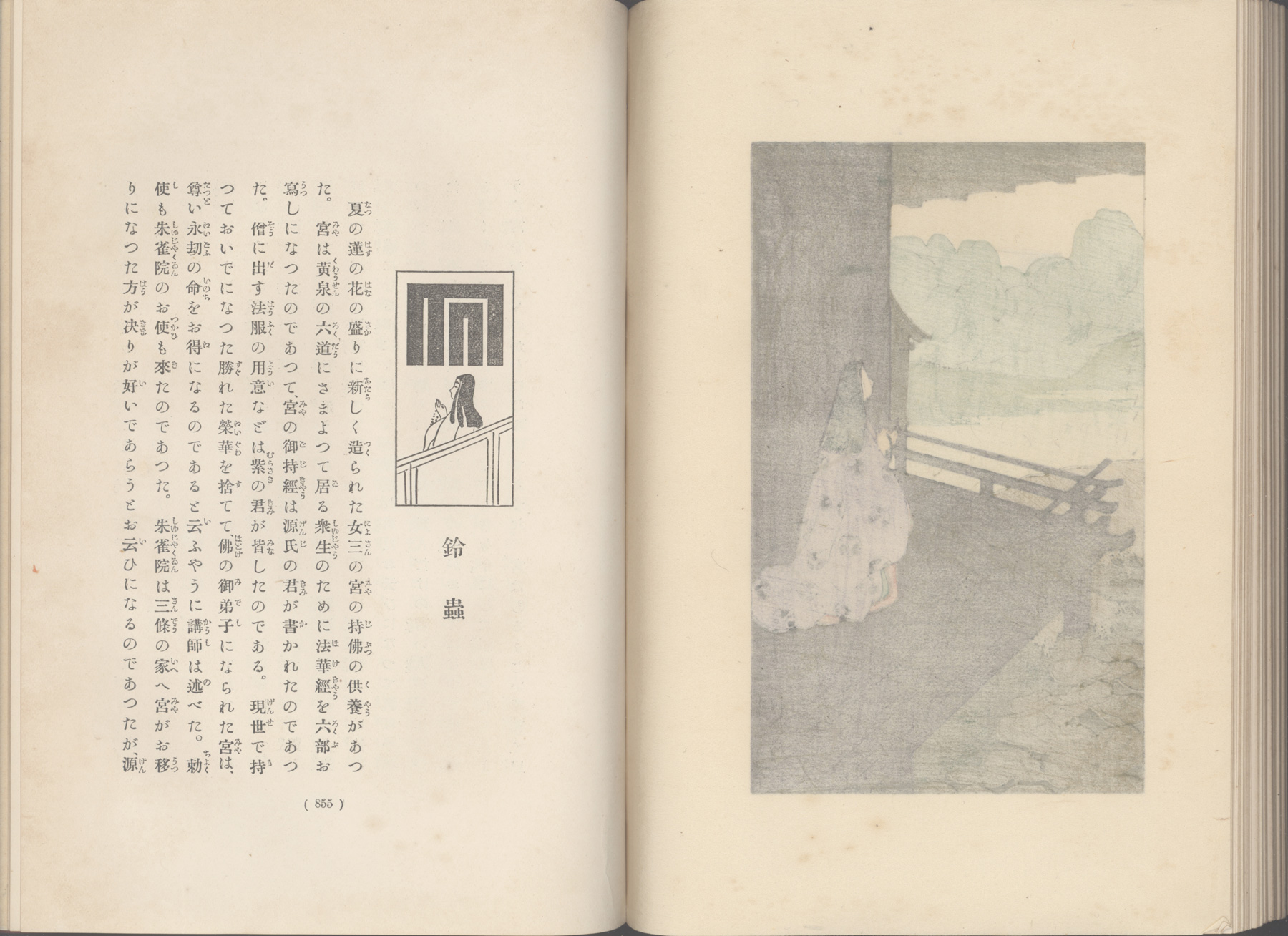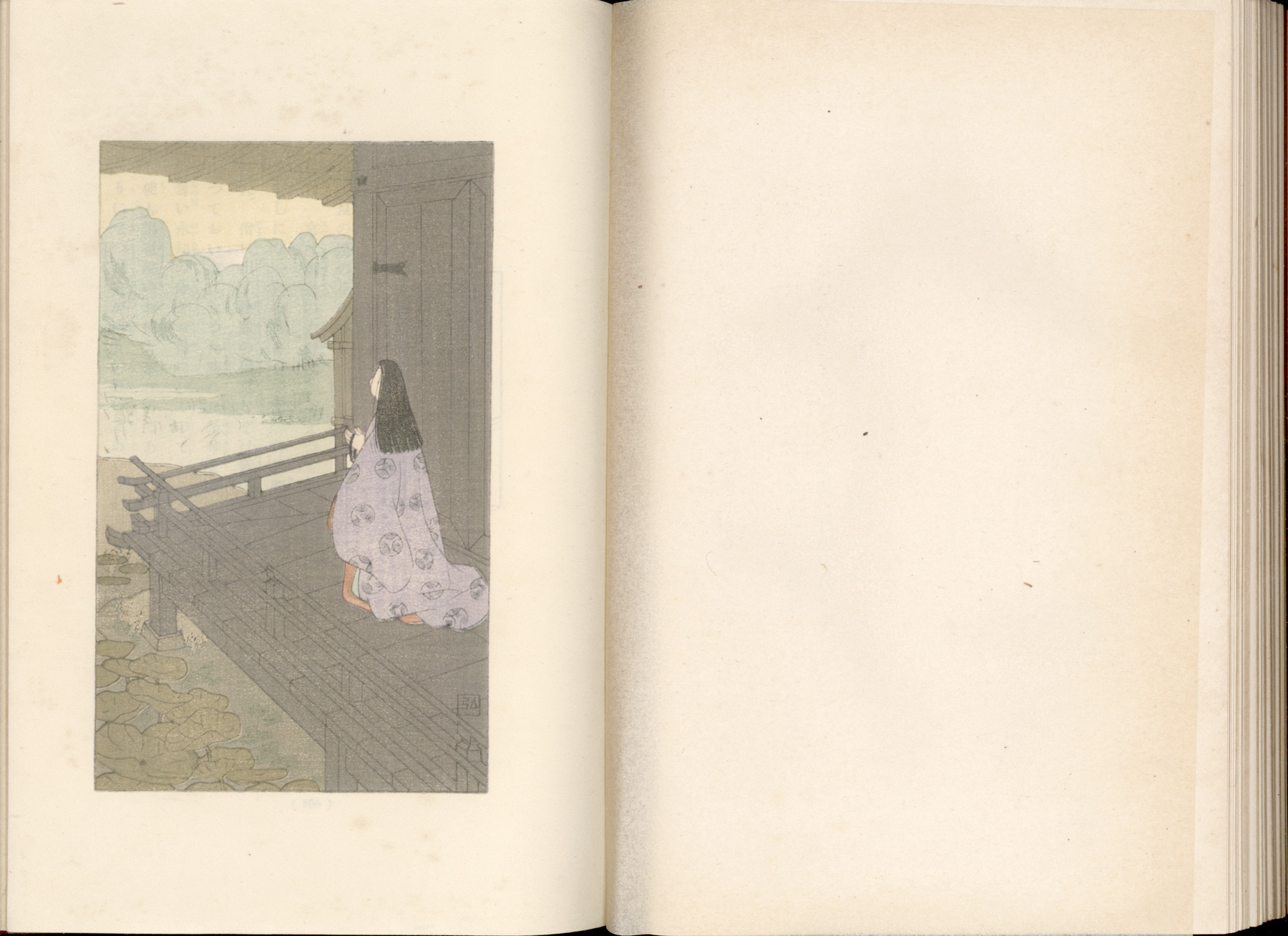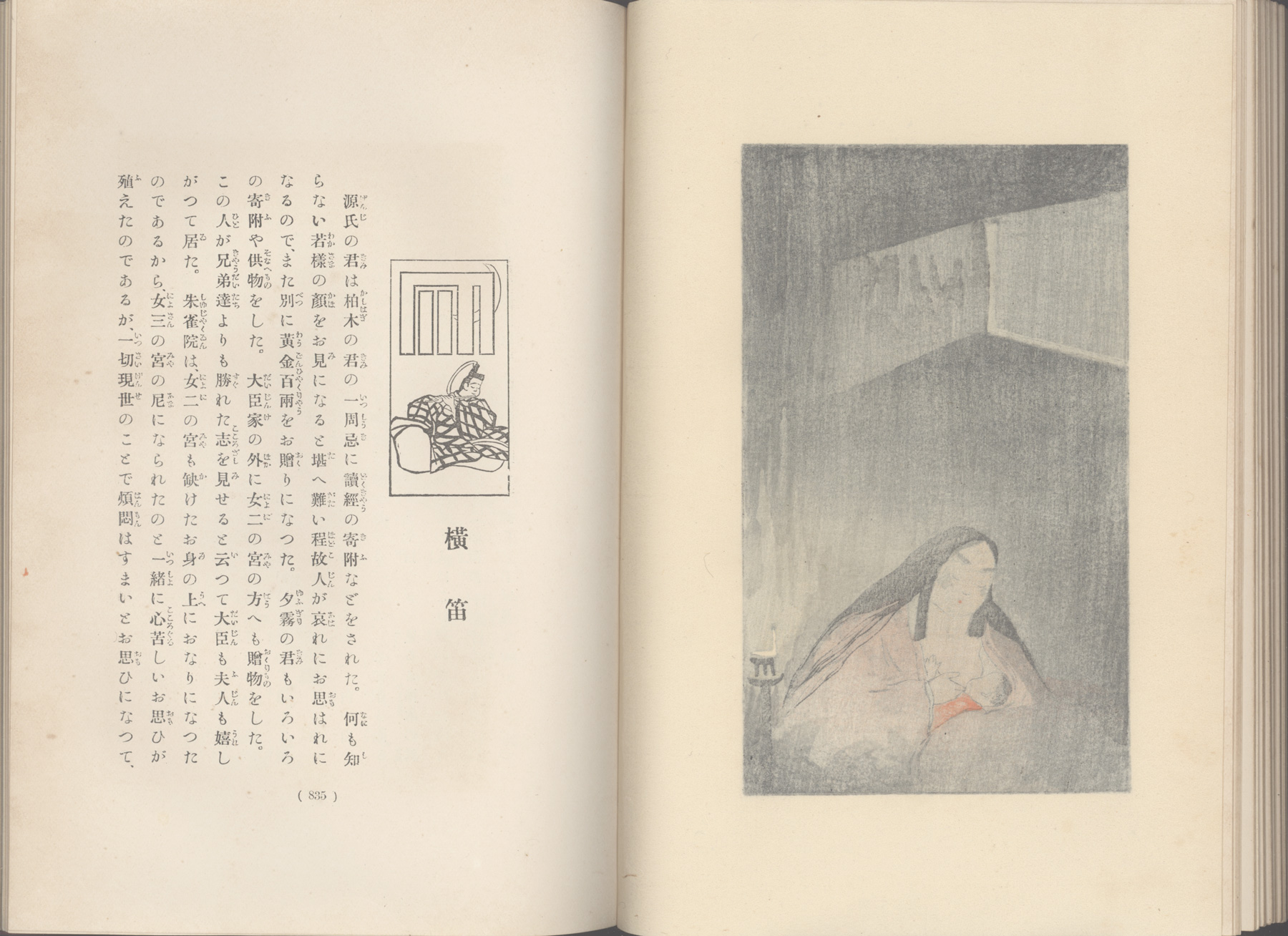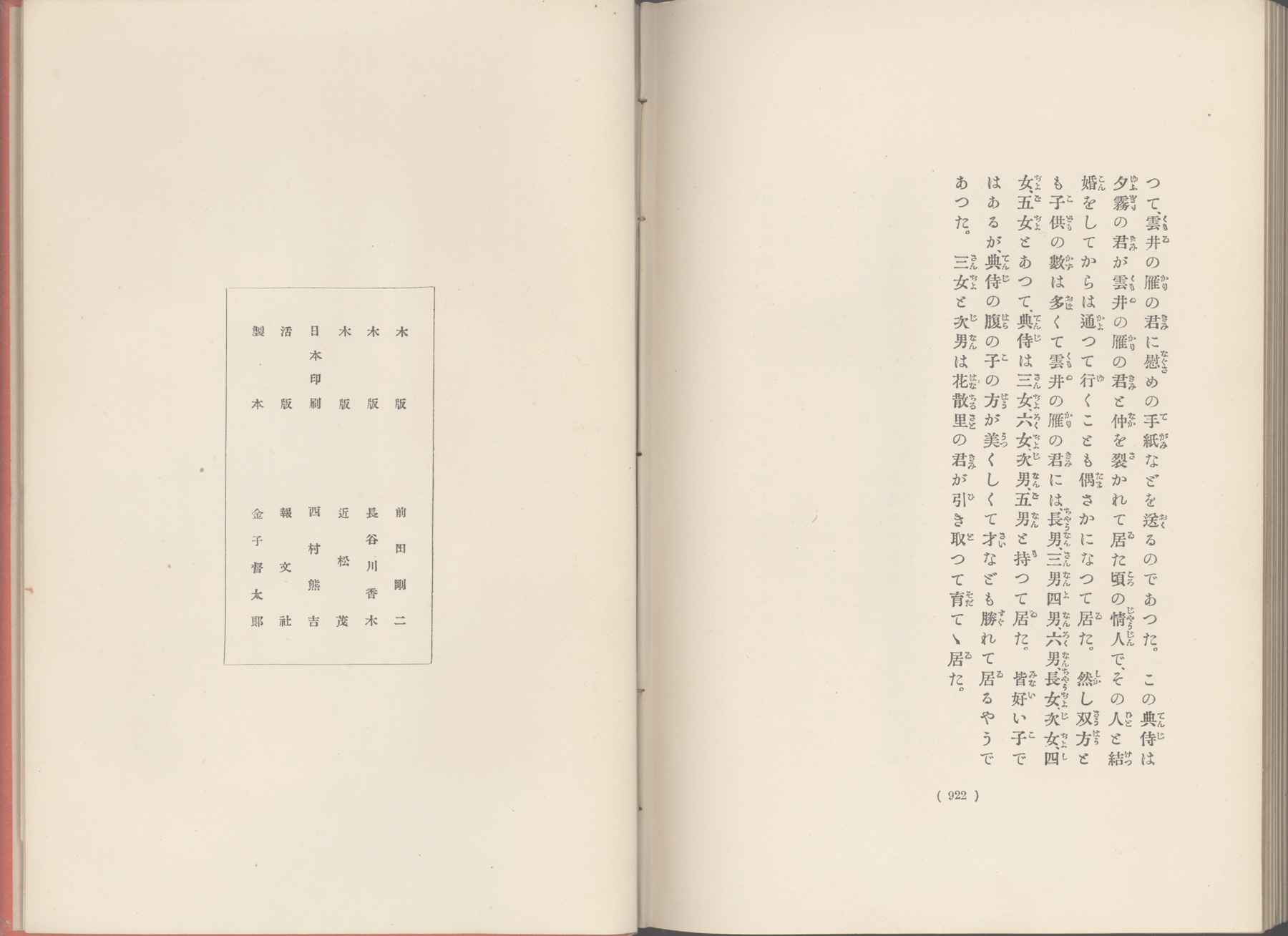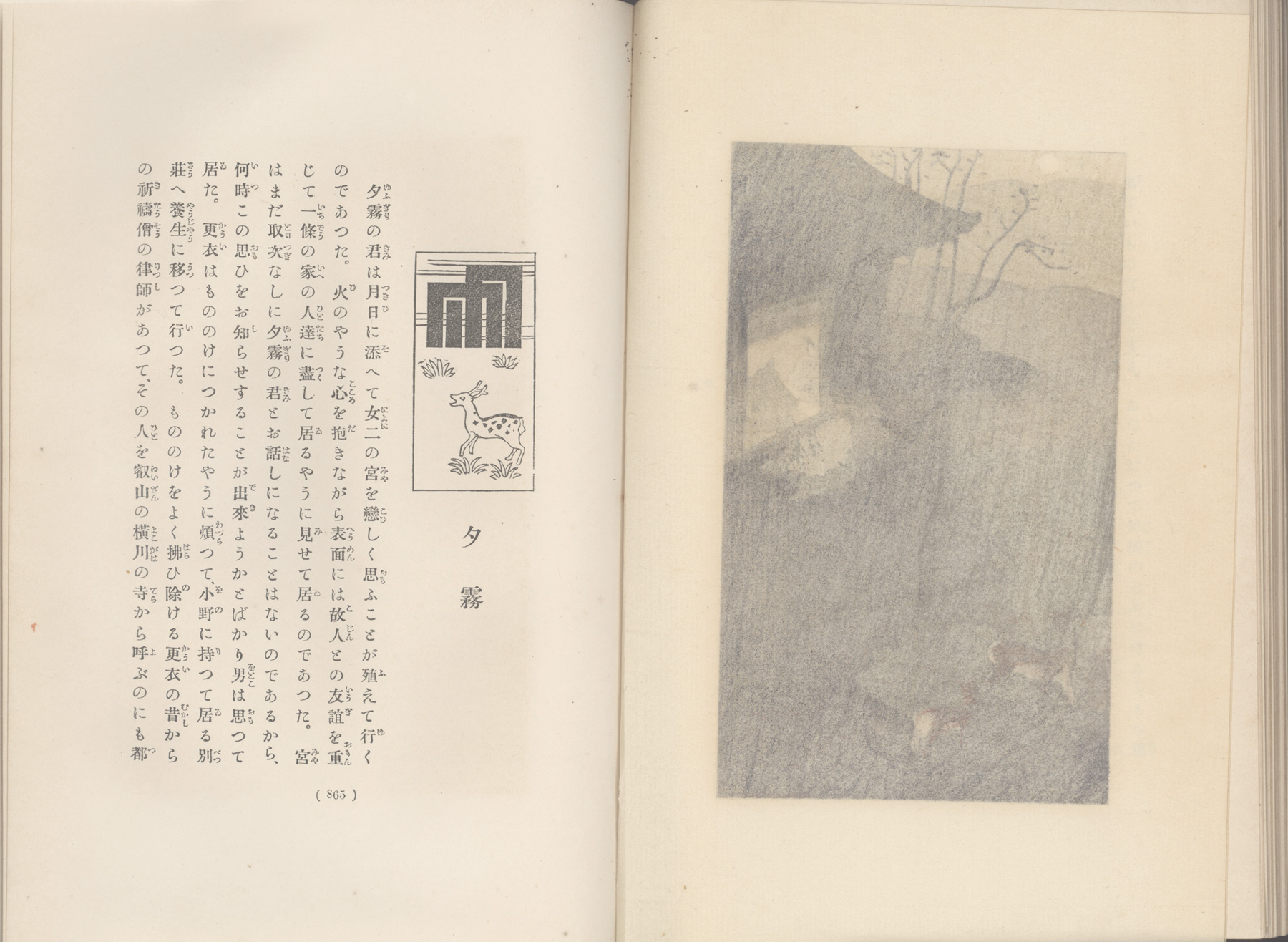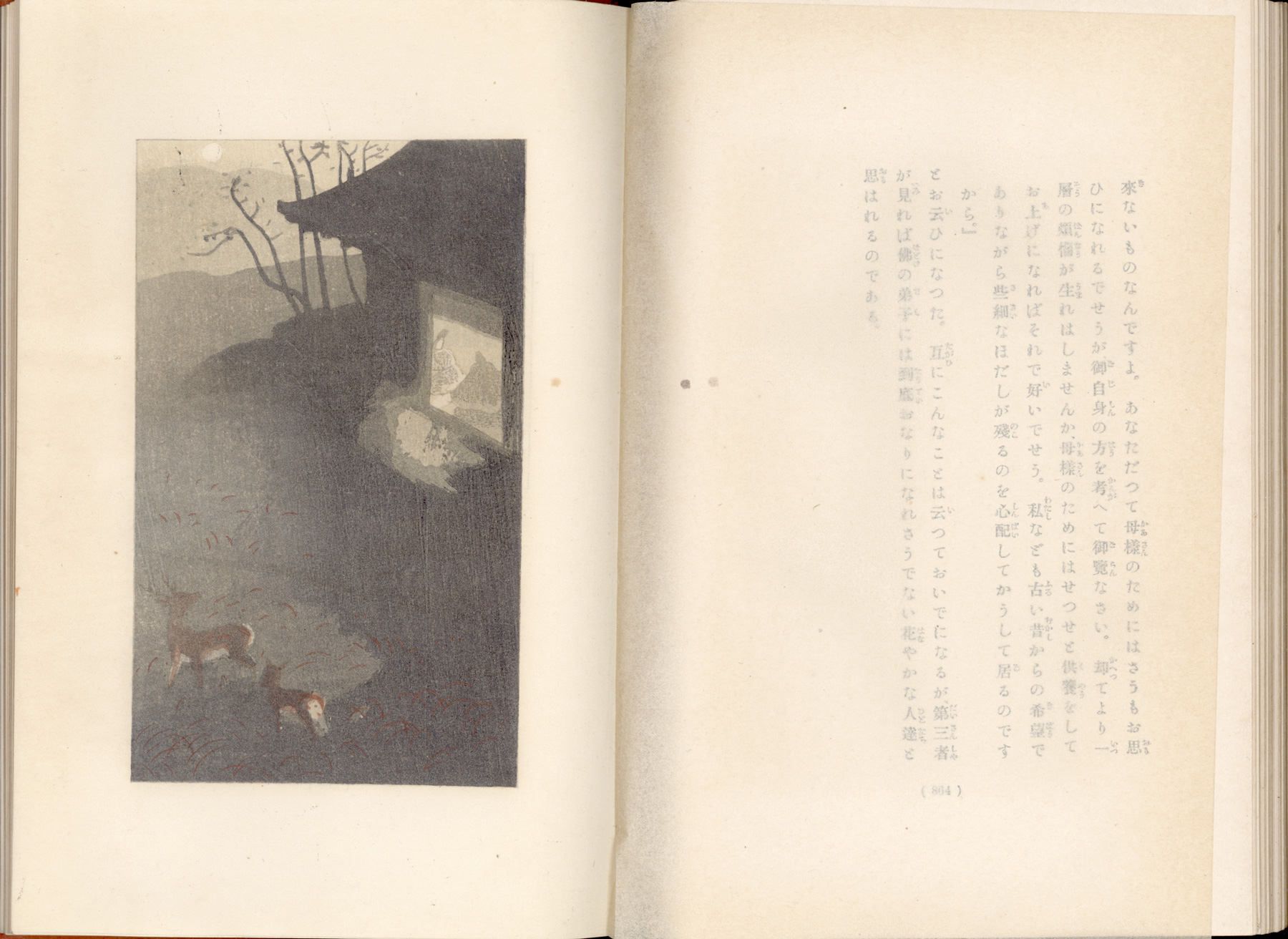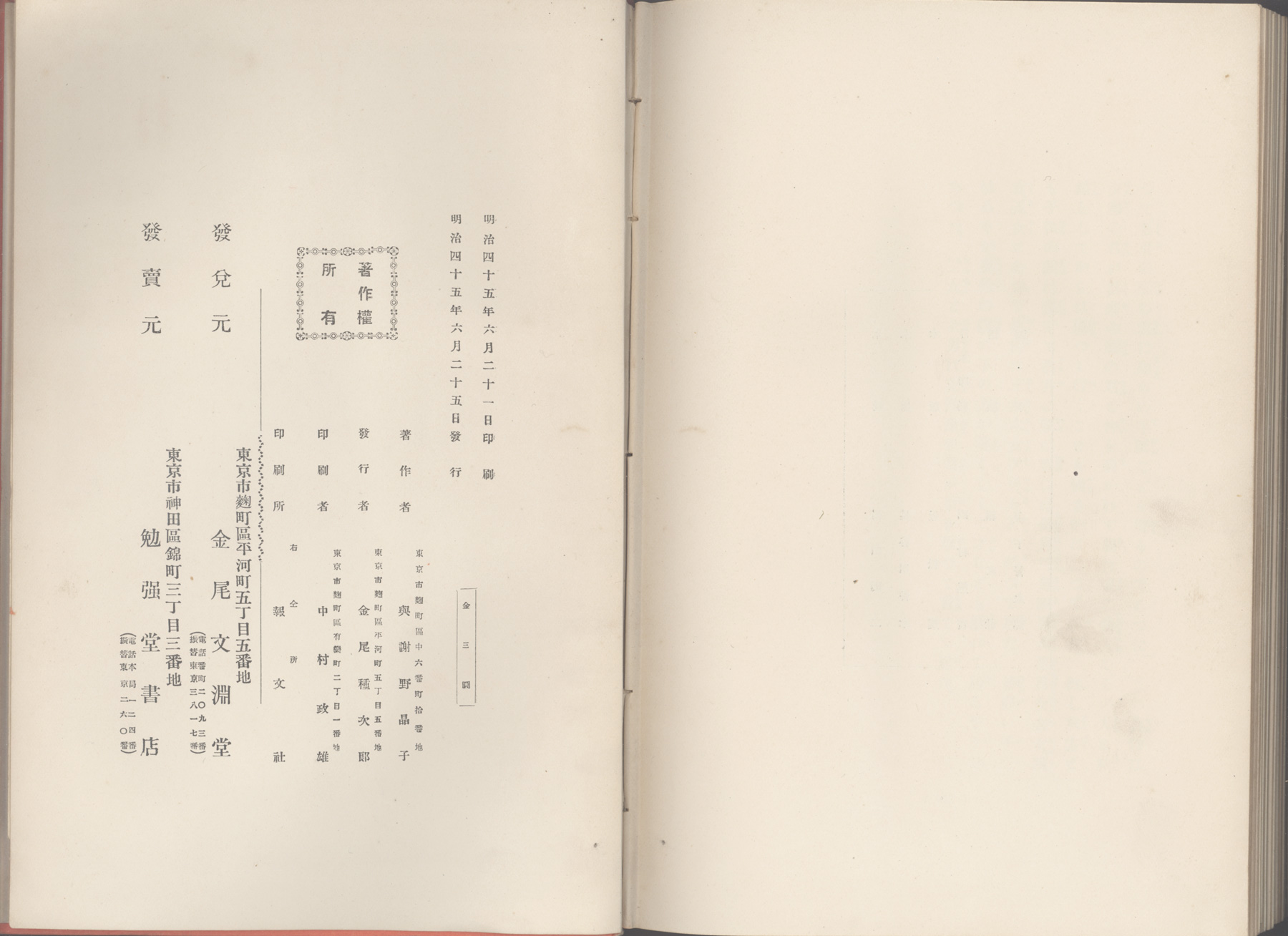Woodblock Print Illustrations in this Volume (right to left as they appear in the book in the Japanese style)
| inside rear cover of 21 of the 54 the Genji-mon (crests)1 | inside front cover of 21 of the 54 Genji-mon (crests)1 |
Chapter 24 - 胡蝶 Kochō
(Butterflies)
Boating on the South Lake of Rokujoin, Genji’s mansion. | Chapter 23 - 初音 Hatsune
(The First Warbler) | Chapter 22 - 玉鬘 Tamakazura
(The Jewelled Chaplet) |
Chapter 27 - 篝火 Kagaribi
(Flares)
Flares lighted in Tamakazura’s garden
at Rokujoin. | Chapter 26 - 常夏 Tokonatsu
(Wild Carnation)
Genji and his son Yugiri on the
verandah of Rokujoin. | Chapter 25 - 螢 Hotaru (Fireflies) |
Chapter 30 - 藤袴 Fujibakana
(Purple Trousers)
| Chapter 29 - 行幸 Miyuki
(The Royal Outing) | Chapter 28 - 野分 Nowaki
(The Typhoon)
Genji on the verandah of Rokujoin
after the typhoon. |
Chapter 33 - 藤の裏葉 Fuji no Uraba
(Wisteria Leaves) | Chapter 32 - 梅枝 Umegae
(A Branch of Plum) | Chapter 31 - 真木柱 Makibashira
(The Cypress Pillar)
|
Chapter 36 - 柏木 Kashiwagi
(The Oak Tree)
Yugiri visits the dying Kashiwagi. | Chapter 35 - 若菜下 Wakana: Ge
(New Herbs, Part 2)
Kashiwagi holding the Third Princess’ cat.
| Chapter 34 - 若菜上 Wakana: Jō
(New Herbs, Part 1)
|
Chapter 39 - 夕霧 Yūgiri
(Evening Mist) | Chapter 38 - 鈴虫 Suzumushi
(The Bell Cricket)
The Third Princess Onna San no Miya
on the verandah of Rokujo-in. | Chapter 37 -横笛 Yokobue
(The Flute)
|
1 Genji-mon (Genji Crests) that were assigned to the Chapters of "The Tale of the Genji" by early Incense Masters for the purpose of playing the incense game "Genji-ko."
About This BookSources: The Tale of Genji: Translation, Canonization, and World Literature, Michael Emmerich, Columbia University Press, 2013 and as footnoted.
A Miracle in the History of World Art - Genji monogatari!
Reborn into the Taishō Literary World - Genji monogatari!
At last, the great woman writer Akiko, A MODERN MURASAKI SHIKIBU, has turned Genji monogatari into a masterpiece of a novel IN THE MODERN LANGUAGE capable of being easily appreciated by anyone.
- from an advertisement appearing on the front page of the August 19, 1913 Yomiuri shinbun1 |
The second of four volumes, containing chapters 22 through 39, of Yosano Akiko's 与謝野晶子 (1878-1942) translation into modern colloquial Japanese of Lady Murasaki Shikibu's 紫式部著 (973-1025?), The Tale of Genji (Genji monogatari), an account of court life in Heian period Japan, written in the early 11th century. Her translation, originally published in 1912 (the first two volumes) and 1913 (the last two volumes) by Kanao Tanejirō (1879-1947), through his publishing house Kanao Bun'endō, was illustrated with sixty-one woodblock prints (including four frontispieces) designed by the Western-style (yōga) artist Nakazawa Hiromitsu (1874-1964).
Yosano, in writing Shin'yaku Genji monogatari, is credited with transforming "Genji [perhaps the world's first novel] into a modern novel, thus making it part of modern Japanese literature."2 For Yosano, Genji had been a passion from an early age as would become her Shin'yaku (new translation). In her afterword appearing in the final volume she wrote: | I was always pushed to the limit by the pressure of my work, both with my family and in my study. During this time I traveled to Europe and I was twice confined; one of these confinements was a difficult birth in which my life was at risk. Nonetheless, sustained by the interest that I have had in the original since I was twelve or so translating the book has been the core of my work for the past three years, and because of my humble efforts, I have been able to complete it earlier than we had initially planned. Looking back at the over-ambitious feat of juggling I have accomplished, I am not without a feeling of relief.3 |
Beloved Genji: that which lay within the names of its chapters in the spring of this New Year I make my sole companions. - Yosano Akiko, January 19204 |
Michael Emmerich in his book The Tale of Genji: Translation, Canonization, and World Literature, which explores how Genji became a modern Japanese classic and part of the world's classic literature, states "Akiko created a literary version of Genji monogatari capable of suggesting to ordinary, non-specialist readers of Japanese that, as the scholar Sassa Seisetsu put it, Genji monogatari was 'the unrivaled treasure of our nation and as such, something worth boasting about to all the nations of the world.'"5
The four books that make up Shin'yaku Genji Monogatari click on links above to go to volume details
At the high price of three yen per volume*, Yosano's translation sold well even through tough economic times, due not only in its readability, making it accessible to a wide audience, but as Emmerich states, its "cosmopolitan modernity...in the books material form."7 Going on to laud the physical book Emmerich writes: | [I]ts volumes are startlingly heavy, printed on thick torinoko paper with gilded edges; the title is printed in gold on the spines; and, most important, there are Nakazawa's delicately colored, beautifully composed woodblock prints. Covering every surface of all four boxes [each volume was originally sold in its own slipcase], decorating the covers and spines of each volume, and interspersed at fifty-seven points throughout the book, the prints' compositions, delicate pastel palette, and luxuriant landscapes clearly display the artist's engagement with transnational artistic trends such as Art Nouveau, even as they reverence the long history of artistic representations of scenes in Genji monogatari.8 |
* more than a week's wages for a teacher at the time
Nakazawa's illustrations came in for some high praise from none other than French sculptor Auguste Rodin (1840-1917) when, after receiving the first two volumes from Yosano, expressed his admiration for Nakazawa's illustrations along with his bitter "regret being unable to read Japanese."9 Commenting on the cover of the first volume, Emmerich states: | It comes as no surprise to find a depiction of Murasaki Shikibu gazing out over Lake Biwa on the cover of volume 1: here, Nakazawa cleaves quite close to convention. The enormous silver moon, the inclusion of red foliage to suggest the season, the shape of the lattice window behind Murasaki Shikibu, and the type of perspective used all point back to earlier precedents. Yet rather than show Murasaki Shikibu seated inside at a long, low table, Nakazawa has her standing in full view on a veranda-and looking, moreover, decidedly, realistically rumpled. This is, in fact, a rather modern Murasaki Shikibu. Unlike most conventional portraits of Murasaki Shikibu, which tend to show her engaged in the act of writing Genji monogatari, Nakazawa depicts her with a book in her hand, reading - a tellingly circular gesture that seems to establish a parallel between Murasaki Shikibu and the reader, almost making it appear that Murasaki Shikibu is inviting her reader to take up their pens and write.10 |
Shin'yaku Genji Monogatari, jōkan New Translation of The Tale of Genji, first volume In commenting on the below cover of the last book in the set, part two of the third volume (see IHL Cat. #2219), Emmerich praises, "its sleek, stylized take on the clouds ubiquitous in Japanese art; its brilliant repetition, and reversal, of the two pairs of men (Kaoru and Niou and their attendants); its subdued greens, blue, yellow, red, and gray; and its almost overbearing bamboo..."11
Shin'yaku Genji Monogatari, gekan no ni New Translation of The Tale of Genji, third volume, part 2
1 The Tale of Genji: Translation, Canonization, and World Literature, Michael Emmerich, Columbia University Press, 2013, p. 336-337. 2 Envisioning The Tale of Genji Media, Gender, and Cultural Production, ed. Haruo Shirane, Columbia University Press, p. 7. 3 "Making a Living from Genji: Yosano Akiko and Her Work on The Tale of Genji", G. G. Rowley appearing in The Journal of the Association of Teachers of Japanese , Apr., 1991, Vol. 25, No. 1, Special Issue: Yosano Akiko (1878-1942), American Association of Teachers of Japanese, p. 33-34. https://www.jstor.org/stable/488909 4 "Yosano Akiko's Poems: In Praise of 'The Tale of Genji'", Yosano Akiko and G. G. Rowley appearing in Monumenta Nipponica , Winter, 2001, Vol. 56, No. 4 (Winter, 2001), Sophia University, p. 439. https://www.jstor.org/stable/3096670 5 Emmerich, p. 330-331.6 Emmerich, p. 338 (Emmerich provides a partial translation of Mori Ōgai's forward.) 7 Emmerich, p. 332. 8 Emmerich, p. 332-333. 9 Emmerich, p. 336. 10 Emmerich, p. 333. 11 Emmerich, p. 333.
The Author/Translator of "The New Translation" 与謝野晶子 (1878-1942)
No one now alive is better suited to translate Genji monogatari than Yosano Akiko - Ueda Bin (1874-1916), poet and literary critic | Yosano Akiko 与謝野晶子 (1878-1942) is one of the most important literary figures of prewar Japan. Poet, translator and feminist writer, she was born in Sakai, Osaka Prefecture to a well-to-do merchant family that sold red bean paste confections (yōku). She graduated from the Sakai Girls' School in 1892. In 1901 she married poet Yosano Tekkan 与謝野鉄幹 (1873-1935), giving birth to thirteen children between 1902 and 1919, eleven of whom survived into adulthood. With Tekkan she founded the free coeducational school Bunka Gakuin in 1921.
Her first volume of poems, Midaregami (Tangled Hair), 1901, contained nearly 400 tanka poems of passion and sensuality and was enthusiastically received, although literary critics panned her explicit and sexual language. She was at the forefront of defining the "New Woman" in Japan. She was a frequent contributor to the poetry journal Myōjo (Venus) started by Yosano Tekkan in 1900 that ran until 1908.
Other noted works include Shin Man’yōshū (1937-1939), a collection of 22,783 poems by 6,675 contributors which she compiled with nine other leading poets and the first translation of Genji monogatari into modern Japanese.
Known as a pacifist, based upon her poem Kimi Shinitamou koto nakare (Thou Shall Not Die), written for her brother during the Russo-Japanese War (1904-1905), she was to go on to support Japan's Pacific War, including the attack on Pearl Harbor.
In May 1940, after completing her second translation of Genji, the six volume Shin-shin'yaku Genji monogatari, Akiko suffered a cerebral hemorrhage leaving her paralyzed for the remainder of her life. |
Selected Pages including all woodblock prints (right to left as they appear in the book in the Japanese style)
New Translation of The Tale of Genji, 2nd volume 新訳源氏物語 中巻 Shin'yaku Genji monogatari, chūkan |
Title page 与謝野晶子 新譯 げんじものがたり中巻Yosano Akiko Shin'yaku Genji monogatari, chūkan New Translation of The Tale of Genji, 2nd volume |
frontispiece | inside cover of the Genji-mon (crests) |
Chapter 22 - 玉鬘 Tamakazura
(The Jewelled Chaplet) woodblock print, chapter illustration | | |
Chapter 23 - 初音 Hatsune
(The Frsrt Warbler)
woodblock print verso and page 503 (opening page of chapter) | Chapter 23 - 初音 Hatsune
(The Frsrt Warbler) woodblock print, chapter illustration |
Chapter 22 - 玉鬘 Tamakazura
(The Jewelled Chaplet) woodblock print verso and page 463 (opening page of chapter) |
Chapter 25 - 螢 Hotaru (Fireflies) woodblock print, chapter illustration | Chapter 24 - 胡蝶 Kochō
(Butterflies)
woodblock print verso and page 515 (opening page of chapter) | Chapter 24 - 胡蝶 Kochō
(Butterflies) woodblock print, chapter illustration |
Chapter 26 - 常夏 Tokonatsu
(Wild Carnation)
woodblock print verso and page 539 (opening page of chapter) |
Chapter 26 - 常夏 Tokonatsu
(Wild Carnation)
woodblock print, chapter illustration | Chapter 25 - 螢 Hotaru (Fireflies) woodblock print verso and page 529 (opening page of chapter) |
Chapter 28 - 野分 Nowaki
(The Typhoon)
woodblock print, chapter illustration |
Chapter 27 - 篝火 Kagaribi
(Flares)
woodblock print verso and page 557 (opening page of chapter) |
Chapter 27 - 篝火 Kagaribi
(Flares)
woodblock print, chapter illustration |
Chapter 29 - 行幸 Miyuki
(The Royal Outing)
woodblock print verso and page 577 (opening page of chapter) |
Chapter 29 - 行幸 Miyuki
(The Royal Outing)
woodblock print, chapter illustration |
Chapter 28 - 野分 Nowaki
(The Typhoon)
woodblock print verso and page 561 (opening page of chapter) |
Chapter 31 - 真木柱 Makibashira
(The Cypress Pillar)
woodblock print, chapter illustration |
Chapter 30 - 藤袴 Fujibakana
(Purple Trousers)
woodblock print verso and page 599 (opening page of chapter) |
Chapter 30 - 藤袴 Fujibakana
(Purple Trousers)
woodblock print, chapter illustration |
Chapter 32 - 梅枝 Umegae
(A Branch of Plum)
woodblock print verso and page 641 (opening page of chapter) |
Chapter 32 - 梅枝 Umegae
(A Branch of Plum) woodblock print, chapter illustration
|
Chapter 31 - 真木柱 Makibashira
(The Cypress Pillar)
woodblock print verso and page 613 (opening page of chapter) |
Chapter 34 - 若菜上 Wakana: Jō
(New Herbs, Part 1)
woodblock print, chapter illustration |
Chapter 33 - 藤の裏葉 Fuji no Uraba
(Wisteria Leaves)
woodblock print verso and page 655 (opening page of chapter) |
Chapter 33 - 藤の裏葉 Fuji no Uraba
(Wisteria Leaves)
woodblock print, chapter illustration |
Chapter 35 - 若菜下 Wakana: Ge
(New Herbs, Part 2)
woodblock print verso and page 731 (opening page of chapter) |
Chapter 35 - 若菜下 Wakana: Ge
(New Herbs, Part 2)
woodblock print, chapter illustration |
Chapter 34 - 若菜上 Wakana: Jō
(New Herbs, Part 1)
woodblock print verso and page 675 (opening page of chapter) |
Chapter 37 -横笛 Yokobue
(The Flute)
woodblock print, chapter illustration |
Chapter 36 - 柏木 Kashiwagi
(The Oak Tree)
woodblock print verso and page 805 (opening page of chapter) |
Chapter 36 - 柏木 Kashiwagi
(The Oak Tree)
woodblock print, chapter illustration |
Chapter 38 - 鈴虫 Suzumushi
(The Bell Cricket)
woodblock print verso and page 855 (opening page of chapter) |
Chapter 38 - 鈴虫 Suzumushi
(The Bell Cricket)
woodblock print, chapter illustration |
Chapter 37 -横笛 Yokobue
(The Flute)
woodblock print verso and page 835 (opening page of chapter) |
production credits
木版 前田剛二
[woodblock (carving): Maeda Gōji]
木版 長谷川香木
[woodblock (carving): Hasegawa Katsura]
木版 井上鎭平
[woodblock (carving): unread
日本印刷 西村熊吉
[woodblock (Japan) printing: Nishimura Kumakichi]
活版 報文社
[typography: Hobunsha]
製本 金子督太郎
[Bookbinding: Kaneko Tokutarō?] |
Chapter 39 - 夕霧 Yūgiri
(Evening Mist)
woodblock print verso and page 865 (opening page of chapter) |
Chapter 39 - 夕霧 Yūgiri
(Evening Mist)
woodblock print, chapter illustration |
- intentionally left blank -
|
inside rear cover of the
Genji-mon (crests) |
colophon
明治四十五年六月二十一印刷 [Printing: June 21, 1912]
明治四十五年六月二十五發行
[Issuance: June 25, 1912]
金三圓
[3 yen]
著作權所有
[copyright reserved]
著者 與謝野晶子
[author Yosano Akiko]
發行者 金尾種次郎
[publisher: Kanao Tanejirō]
印刷者 中村政雄
[printer: Nakamura Masao
印刷所 報文社
[printing place: Hobunsha]
發兌元 金尾文淵堂
[publishing house: Kanao Bun'endō]
|
Book Details| IHL Catalog | #2289 | | Title or Description | New Translation of The Tale of Genji, 2nd Volume
Shin'yaku Genji monogatari, chūkan
新訳源氏物語 中巻 | Artist
| Nakazawa Hiromitsu (1874-1964)
Authors: Yosano Akiko 与謝野晶子 (1878-1942) / Murasaki Shikibu, b. 978? | Signature
| no artist signature
| | Seal | 弘 Hiro seal appears on all woodblock illustrations except the frontispiece | | Publication Date | June 25, 1912 明治四十五年六月二十五發行 | | Edition | likely first edition | | Publisher | 發行者 金尾種次郎 publisher Kanao Tanejirō
發兌元 金尾文淵堂 publishing house Kanao Bun'endō | | Carver | Hasegawa Katsura 長谷川香木, Maeda Gōji 前田剛二, 井上鎭平 (unread) | | Printer | Nishimura Kumakichi 西村熊吉 (woodblock prints only) | | Impression | woodblock prints - excellent | | Colors | woodblock prints - excellent | | Condition | woodblock prints - good (minor toning); book: toning along spine; spine separated from book along 1 vertical side; some offsetting or transference from woodblock prints to adjoining text pages
| | Miscellaneous |
| | Genre | illustrated book zuroku 図録 | | Format |
| | H x W Paper | H x W x D Book Closed: 8 13/16 x 5 7/8 x 1 5/16 in. (22.4 x 14.9 x 3.3 cm) | | Collections | National Diet Library 945501 Call No. 329-168イ; University of California Berkeley Call No. A43.1 (four volumes); The British Museum Volume 1 1991,1112,0.205.1 and Volume 2 1991,1112,0.205.2 | | Reference Literature | The Tale of Genji: Translation, Canonization, and World Literature, Michael Emmerich, Columbia University Press, 2013; The Tale of Genji: A Japanese Classic Illuminated, John T Carpenter, et. al., Metropolitan Museum of Art, 2019 |
last update:3/18/2021 2/16/2021 created
|


